The Best Destinations to Visit in the Basque Country
Eloi_Omella/Getty Images
The Basque Country is a far cry from what you may think of when you picture Spain. You won't find much flamenco dancing or paella here (and if you do, run — you've likely stumbled upon a tourist trap), but rather a rich and proud culture. The Basque people take great pride in their heritage and identity, and visiting the little region they call home is a fantastic opportunity to immerse yourself in their culture and way of life.
This gorgeous gem of a region along Spain's northern coast offers a whole wealth of natural beauty, sophisticated cities, and charming small towns you'll fall in love with immediately. If you're not sure where to start, try narrowing it down from this list of our top Basque Country destinations — there's sure to be one you'll adore.
Here, we'll be focusing on destinations within the Spanish Basque Country. The region also extends part of the way up into southwestern France. Don't miss our guide to the French Basque Country if that neck of the woods is on your itinerary.

San Sebastián
TripSavvy / Paula Galindo Valle
With picturesque Belle Epoque architecture, an unbeatable food scene, and gleaming coastlines surrounding some of Europe's best urban beaches, San Sebastián 's appeal is undeniable. While most visitors flock to this stunning coastal city in the summer months, its packed cultural calendar and lively lifestyle make it worth a visit at any time of the year.
If you're only going to do one thing in San Sebastián, eat . From the city's classic pintxos bars like La Cuchara de San Telmo to Michelin-starred wonders such as Arzak , it's easy to see why the city is considered Europe's best city for foodies.
poliki/Getty Images
Head just a little ways out of San Sebastián to the west and soon you'll find yourself in one of the Basque Country's most charming coastal destinations. A humble fishing village teeming with authentic, local charm, Getaria is a haven of gorgeous landscapes and quaint traditional architecture, which combine beautifully to provide postcard-perfect views.
Getaria is home to the Basque Country's signature drink, txakoli , a refreshing semi-sparkling white wine. Pop into a local bar or take a vineyard tour to try some straight from the source.
The town was also the birthplace of fashion icon Cristóbal Balenciaga, and today is home to a fascinating museum documenting his life and work.
JTPalacio/Getty Images
No list of Basque Country destinations is complete without Bilbao . As one of the region's largest urban areas, this awe-inspiring city provides an experience unlike any other, where modern architectural wonder stand side-by-side with iconic historic buildings.
You may recognize Bilbao's Guggenheim Museum from its Frank Gehry-designed futuristic exterior. However, the inside is absolutely worth a visit as well, hosting one of the best modern art collections in Spain as well as regular cultural events.
Alex Lapuerta/Getty Images
Most people know Guernica as the title of the stunning Picasso masterpiece that takes up an entire wall in Madrid's Reina Sofia Museum . The painting depicts the most grim day in the small town's history: the bombing of the city during the Spanish Civil War. However, Guernica (the town) has risen from the ashes to become one of the Basque Country's most charming small-town destinations.
You can't visit Guernica without acknowledging its past. A respectful way to do so would be by visiting the Peace Museum , which hosts many fascinating permanent and temporary exhibitions explaining the historical context of the bombing and promoting peace.
Vitoria-Gasteiz
JMarabel/Getty Images
As the capital of the Basque Autonomous Community in Spain, Vitoria-Gasteiz provides a metropolitan, cosmopolitan feel blended seamlessly with local tradition. With gorgeous architecture and a down-to-earth feel that will make everyone feel at home, this is a spot that should definitely not be overlooked.
Vitoria-Gasteiz's beautifully preserved medieval city center takes you on a breathtaking journey back in time. Seek out architectural wonders such as Bendaña Palace and the old city walls (dating from the 11th century), or simply let yourself to get lost in the charming cobblestone streets and see where you end up.
Hondarribia
Iñigo Fdz de Pinedo/Getty Images
If there's one thing the Basque Country has in spades (other than tasty pintxos), it's stunning beaches. Hondarribia (also known by its Spanish name, Fuenterrabía) has made its way onto travelers' radar in recent years as one of the best day trips from San Sebastián, thanks in part to its beautiful coastline. However, despite its growing popularity, it manages to retain its traditional small-town charm and authenticity.
Make your way through the Old Town and marvel at the traditional Basque homes lining the streets in bursts of color. Another must-visit area is the Marina neighborhood, a lovely pedestrianized barrio with no shortage of excellent dining options.
Rioja Alavesa
Sima_ha, Getty Images
When you come across a bottle of rioja, Spain's most ubiquitous red wine, you might assume that it was produced in the northern region of La Rioja. Most of the time, you'd be right. However, part of the denominación de origen calificada Rioja wine region extends up into the Basque Country, stretching into the province of Álava. Wines produced here still earn the prestigious D.O.C. Rioja label, but with the addition of one important word: Alavesa .
As the capital of the Rioja Alavesa region, the town of Laguardia is a must for curious travelers seeking gorgeous views and excellent lesser-known wines. Visit a nearby winery, such as Bodega Casa Primicia , for a tour and tasting.
Pierre Ogeron/Getty Images
With a long maritime history stretching back centuries, Bermeo proudly holds a status as one of the most important fishing towns on the Basque Coast. Its charm is undeniable, with a colorful, quaint marina (surrounded by great pintxos bars) and a privileged location in the heart of the Urdaibai Biosphere Reserve. The rugged natural beauty is truly breathtaking and provides for once-in-a-lifetime views.
Head out to the nearby San Juan de Gaztelugatxe hermitage for a lovely seaside walk leading up to the small chapel on a hill. If the weather permits, you might not be able to resist the temptation to go for a relaxing swim in one of the small beaches at the bottom of the steps.
At one point, Zarautz was the preferred vacation spot for Spain's royal family, handpicked by Queen Isabella II herself in the 19th century. Hundreds of aristocrats soon followed suit, and the small coastal town earned its status as a can't-miss summer hotspot. Today, Zarautz offers a sophisticated yet unpretentious vibe perfect for travelers looking for something a bit more laid back than San Sebastián but with all of the charm.
Stretching a mile and a half along the coast, Zarautz's beach is the longest in the Spanish Basque Country. The waves here are unbeatable, making it a prime spot for surfing. Grab a board and hit the waves with the locals.
Shaun Egan/Getty Images
With a perfect location right between Bilbao and San Sebastián, Lekeitio makes an ideal spot for a day trip from either city. However, despite its small size, the beautiful landscapes and undeniable charm of the town itself will make you wish you could stay longer.
It's not every town where you can literally walk to an island. But in Lekeitio, you can. At low tide, you can make your way across the sandbar to San Nicolas Island, which offers unbeatable views of the town from its peak. (Just be sure to head back before the tide rises again.)
In the town itself, the Basilica of the Asunción de Santa María serves as a stunning example of Gothic architecture both inside and out.
The Best Day Trips from San Sebastian and Bilbao
How to Spend 3 Days in San Sebastian, Spain
Plan the Perfect Trip to Spain
How to Travel From Biarritz to San Sebastián by Train, Bus, and Car
The Very Best of Spain's Cities, Regions, Food, and Drinks
Where to Go in July in Spain
Top 15 Events in Spain in August
The 11 Best Beaches in Spain
The 10 Best Destinations in the Spanish Countryside
Where I'm Traveling in My Mind: Biarritz, France
15 Best Under-the-Radar Places to Visit in Spain
Travel From Madrid to San Sebastian by Train, Car, and Plane
The 20 Best Things to Do in Spain
How Long Should You Spend in Each City in Spain?
How to Travel From Bilbao to Bordeaux by Train, Bus, Car, and Plane
The World's Most Gay-Friendly Beach Cities and Resorts
Must-see attractions in Basque Country
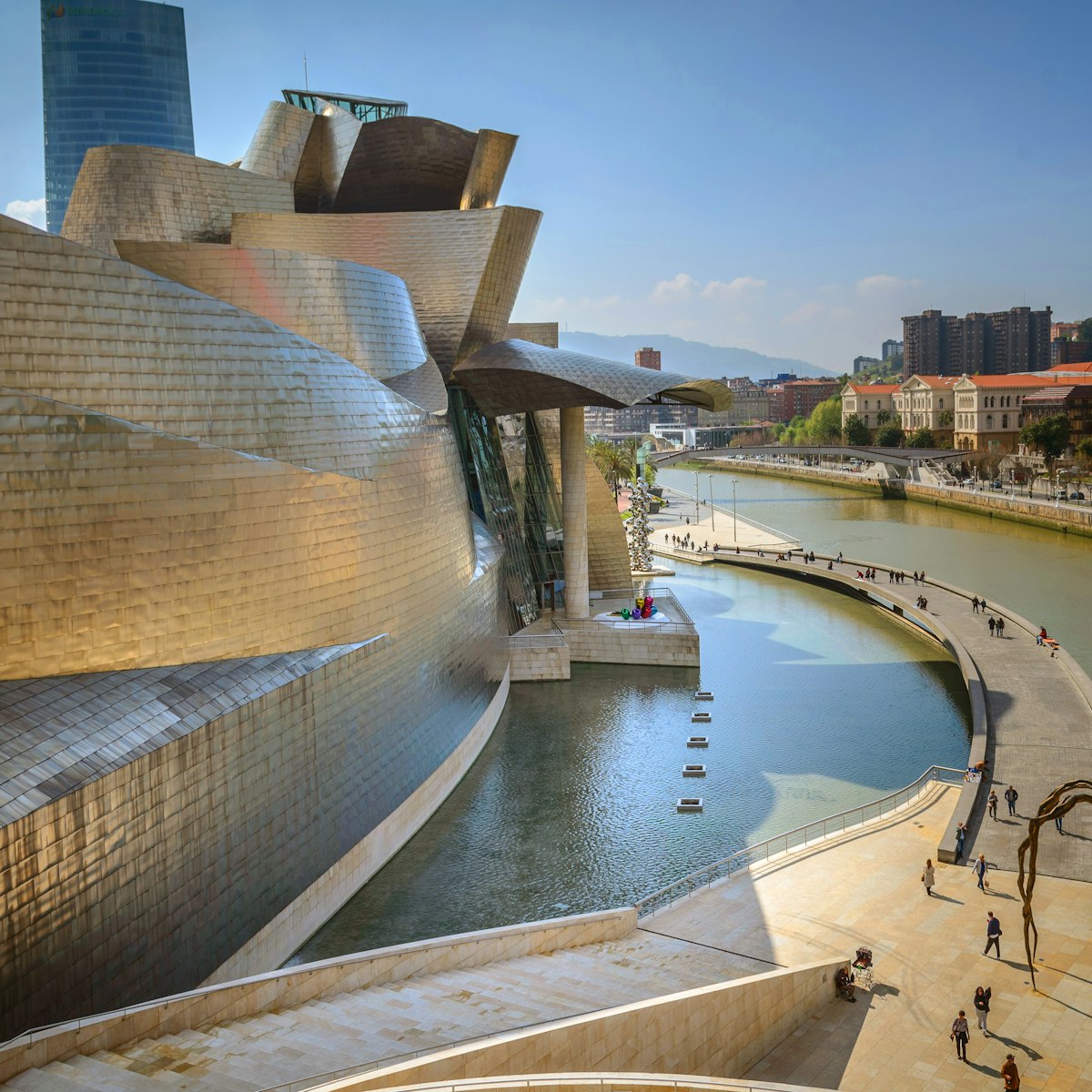
Museo Guggenheim Bilbao
Shimmering titanium Museo Guggenheim Bilbao is one of modern architecture's most iconic buildings. It played a major role in helping to lift Bilbao out of…
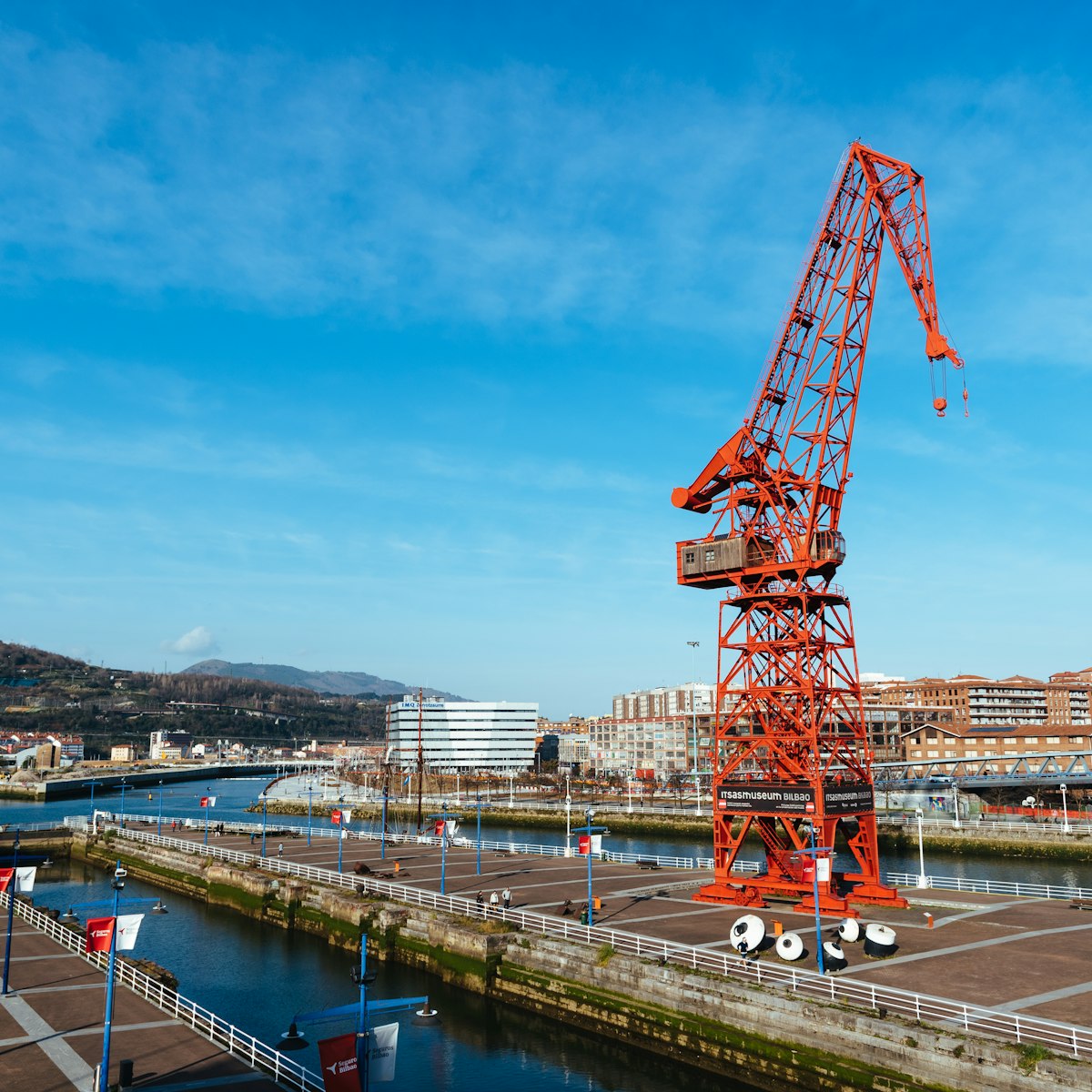
Itsasmuseum
On the waterfront, this interactive maritime museum brings the watery depths of Bilbao and Basque maritime history to life. Start with a 10-minute video…
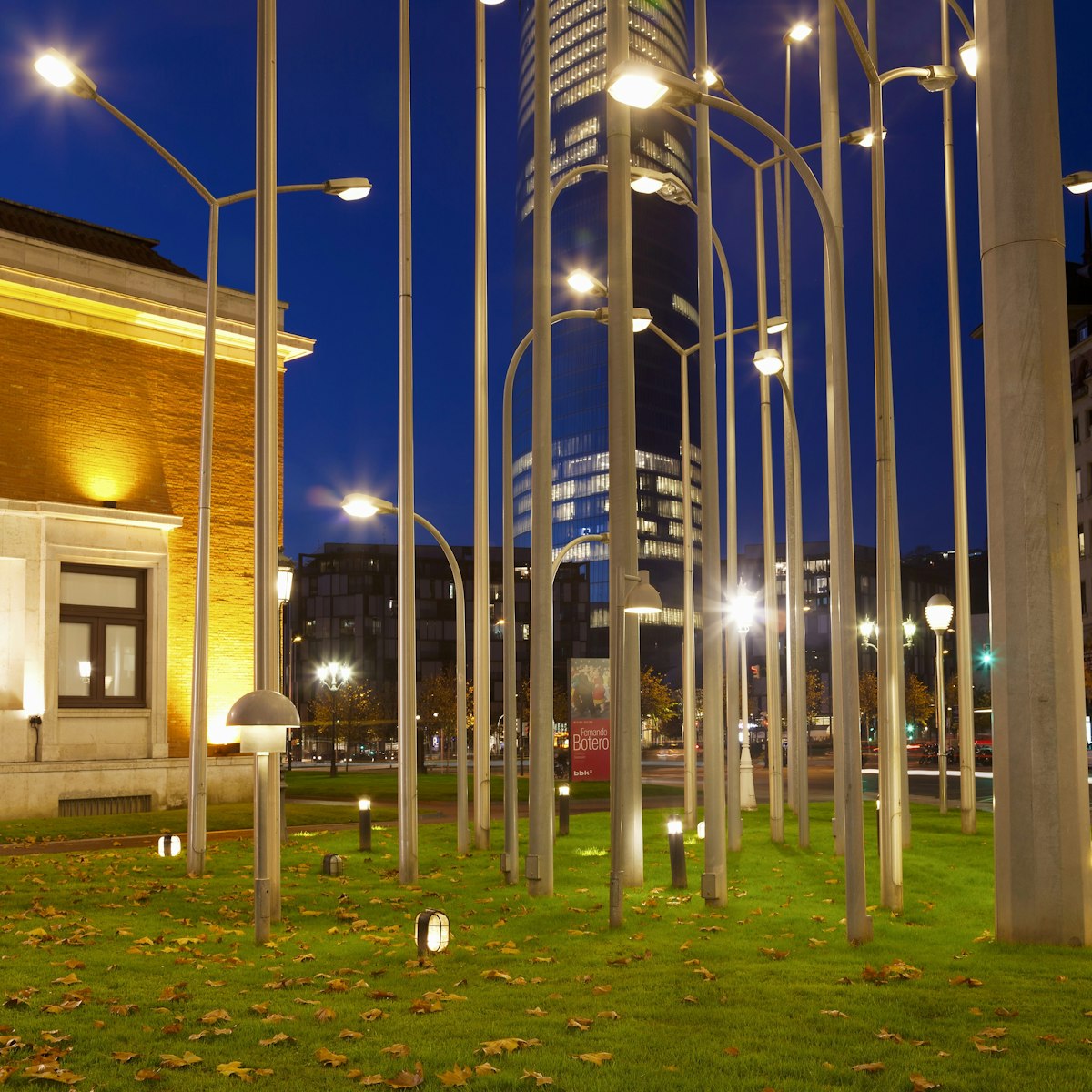
Museo de Bellas Artes
The Museo de Bellas Artes houses a compelling collection that includes everything from Gothic sculptures to 20th-century pop art. There are three main…
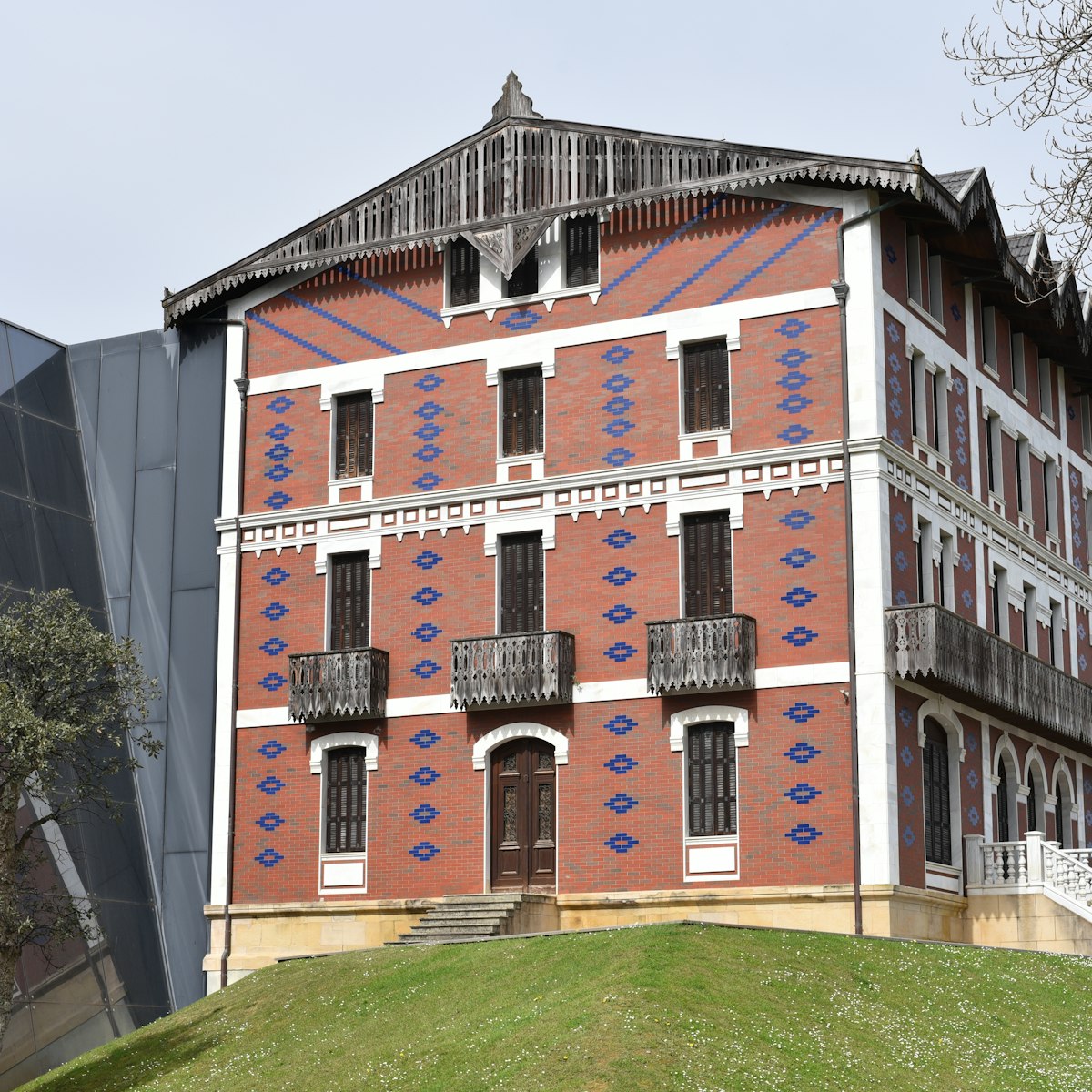
Cristóbal Balenciaga Museoa
Although Getaria is mainly about sun, sand and seafood, don't miss a visit to the Cristóbal Balenciaga Museoa. Local boy Cristóbal became a giant in the…
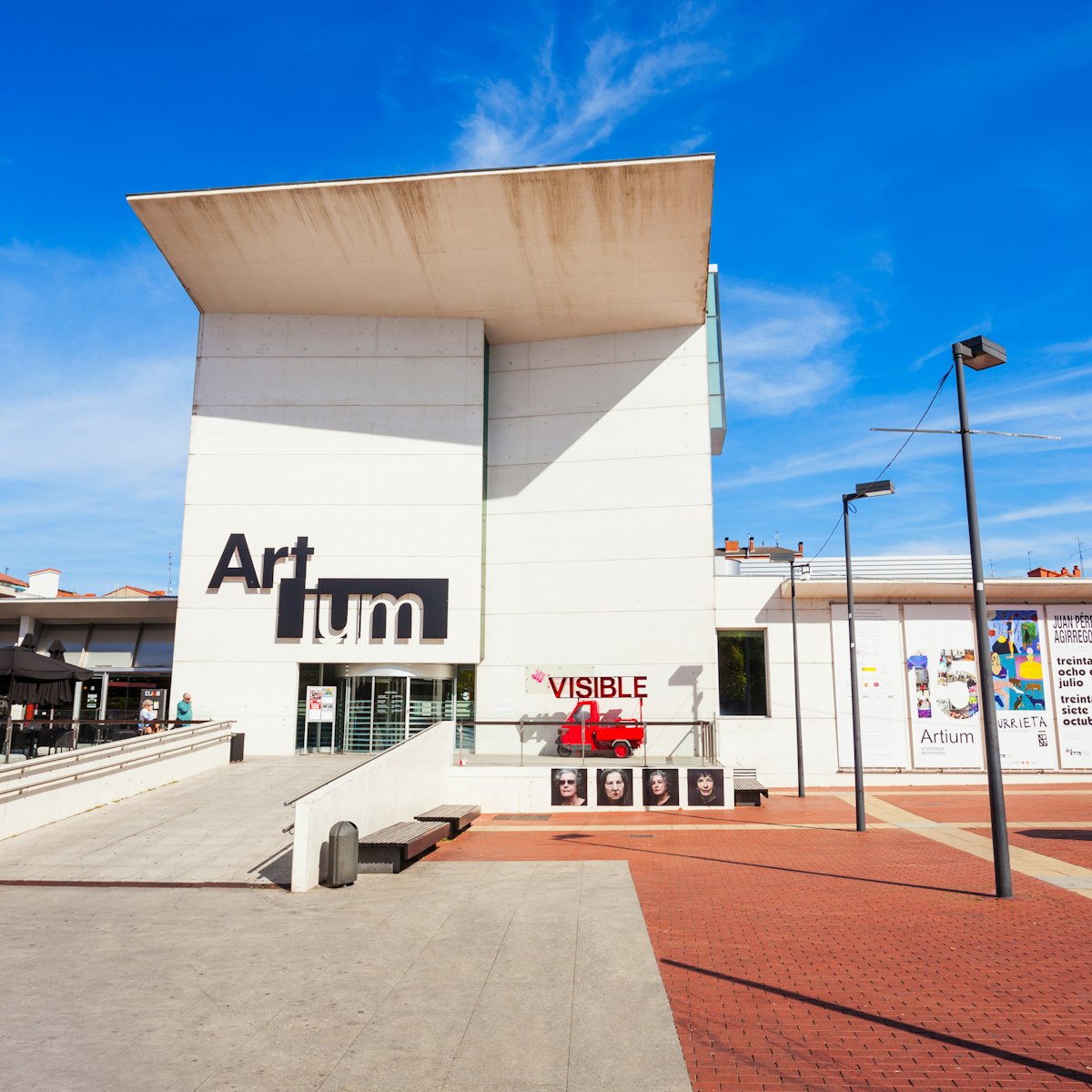
Basque Country
Art lovers shouldn't miss Vitoria’s palace of modern art. The large subterranean galleries are filled with engrossing pieces by artists from the Basque…
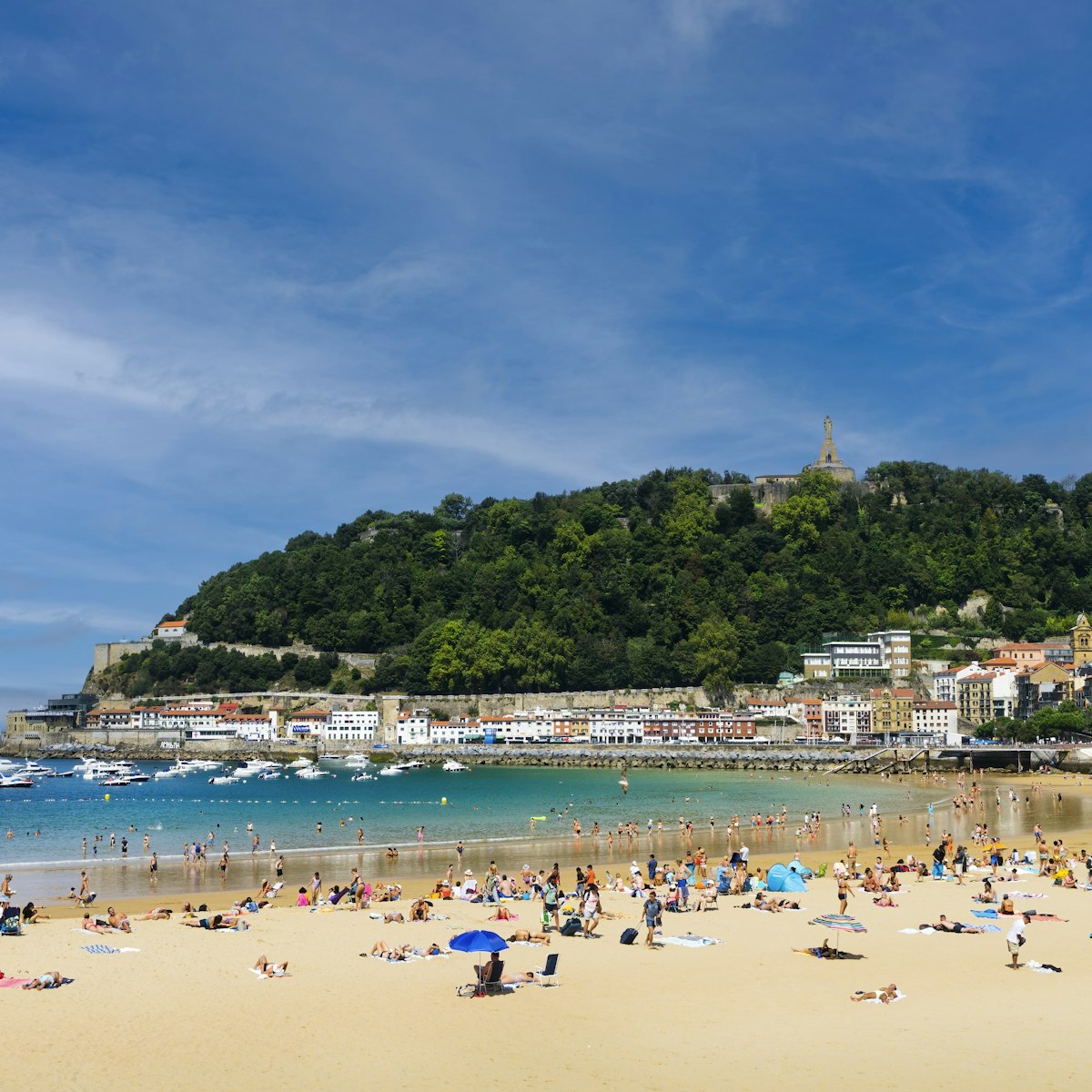
Playa de la Concha
San Sebastián
Fulfilling almost every idea of how a perfect city beach should be formed, Playa de la Concha (and its westerly extension, Playa de Ondarreta) is easily…
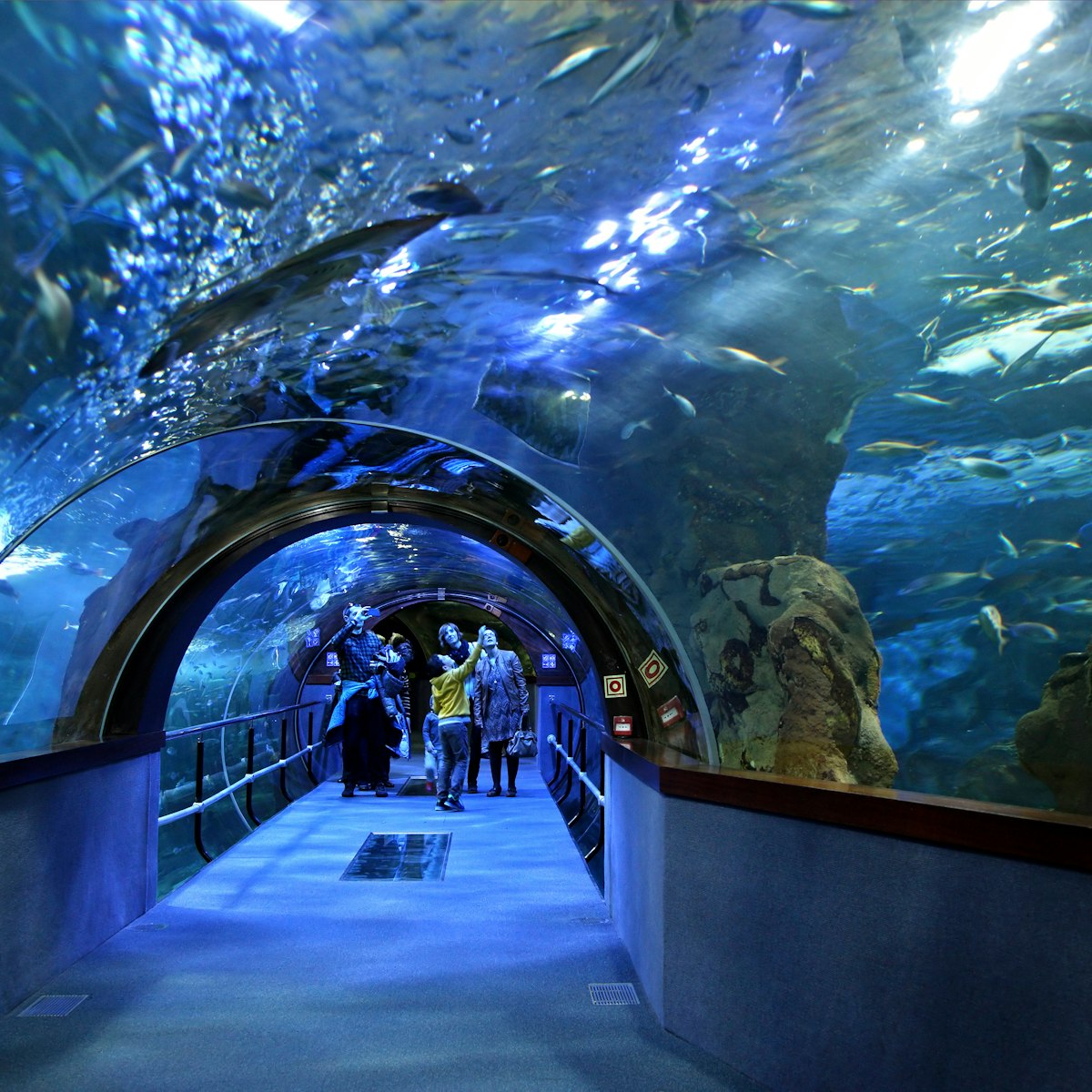
Parte Vieja
Fear for your life as huge sharks bear down behind glass panes, or gaze at otherworldly jellyfish. The highlights of a visit to the city's excellent…
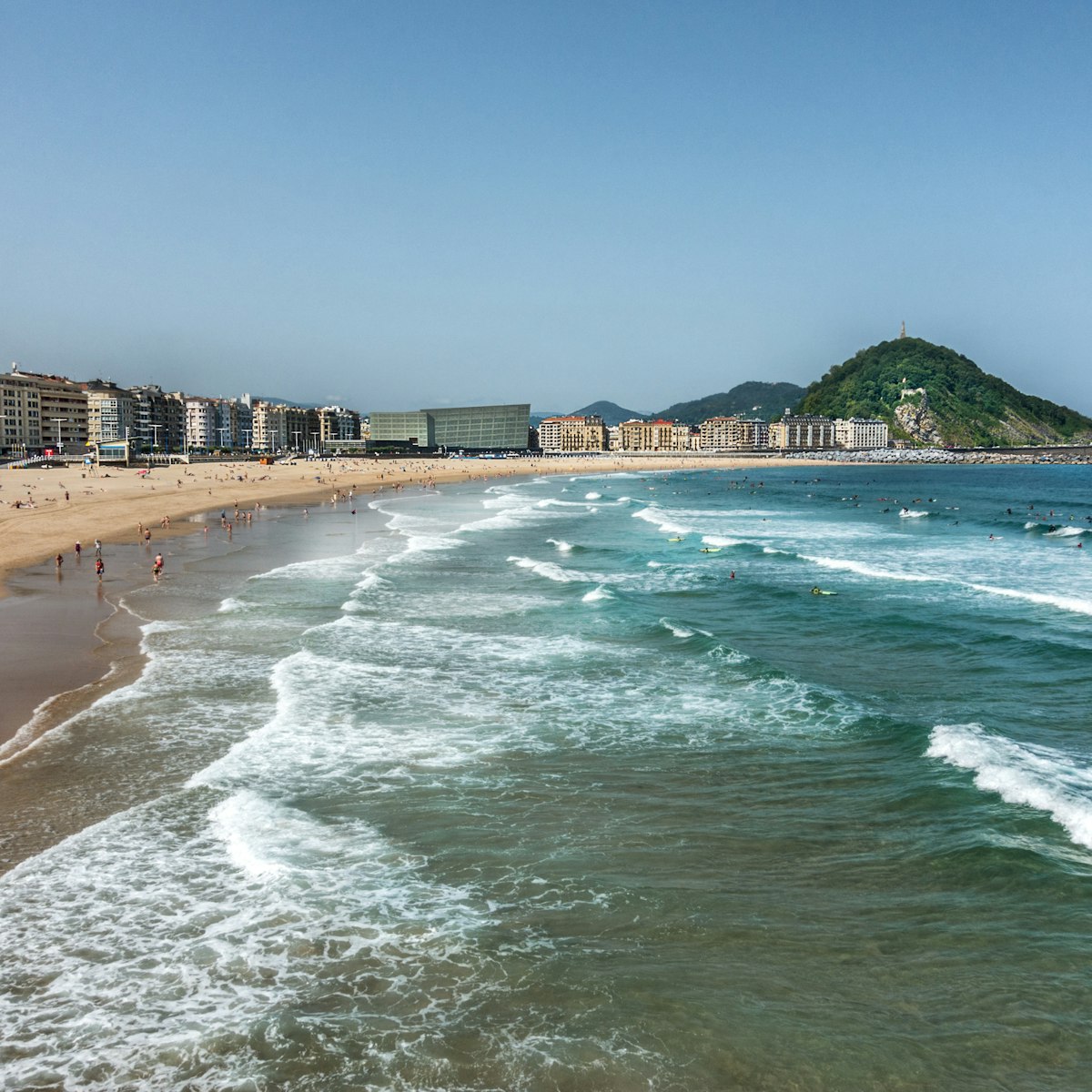
Playa de la Zurriola
Stretching 800m in front of Gros, from the Kursaal to Monte Ulía, 'Zurri', as it's known locally, has some excellent waves that draw surfers from near and…

San Juan de Gaztelugatxe
The Central Basque Coast
One of the most photographed features of the Basque coast, 10km to Bermeo's northwest, is the small, rocky isle of San Juan de Gaztelugatxe. Accessed from…
Crusoe Treasure
The world's first underwater winery, Crusoe Treasure, ages its vintages 20m below the surface on an artificial reef. Tastings of its whites and reds are…
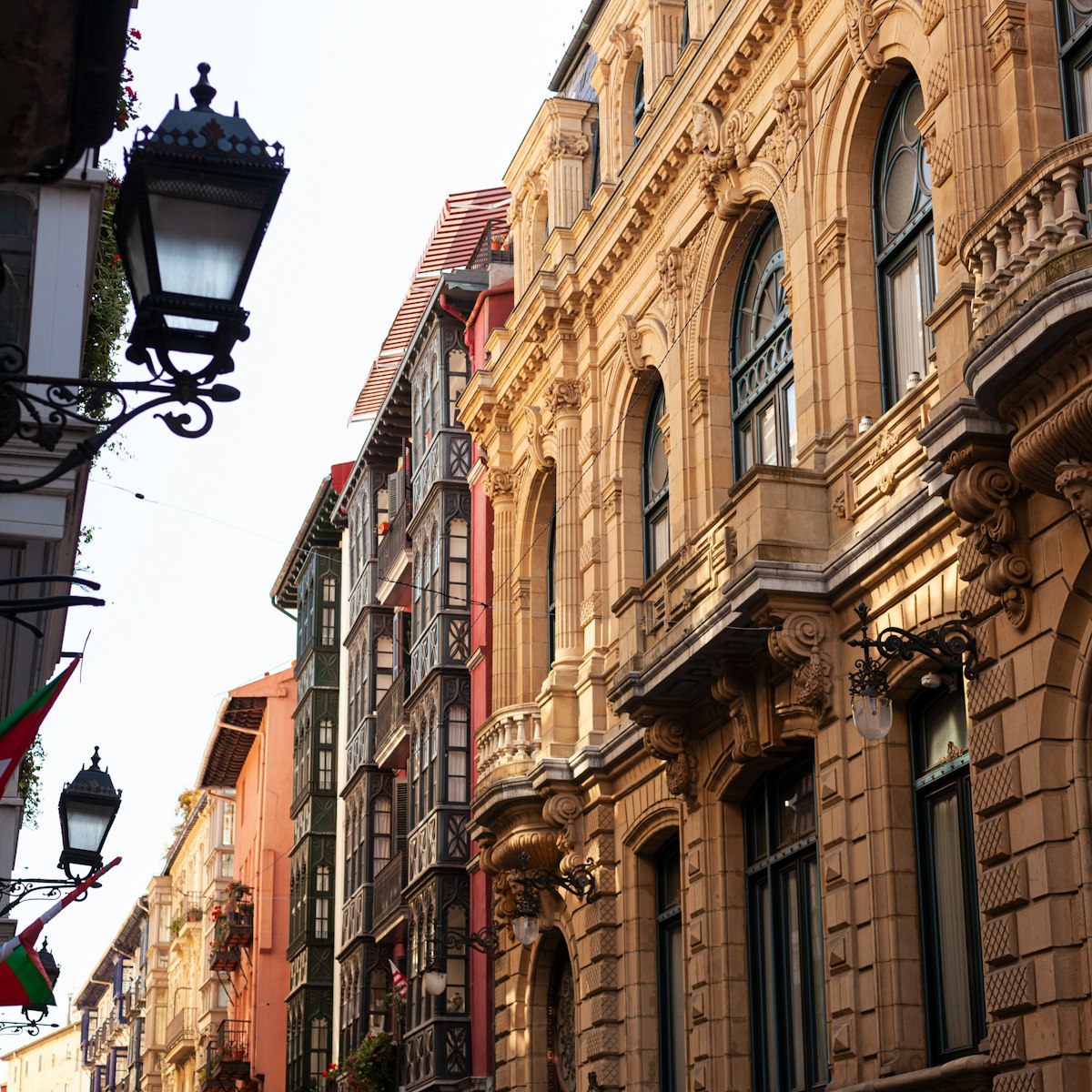
Casco Viejo
The compact Casco Viejo, Bilbao’s atmospheric old quarter, is full of charming streets, boisterous bars and plenty of quirky and independent shops. At the…
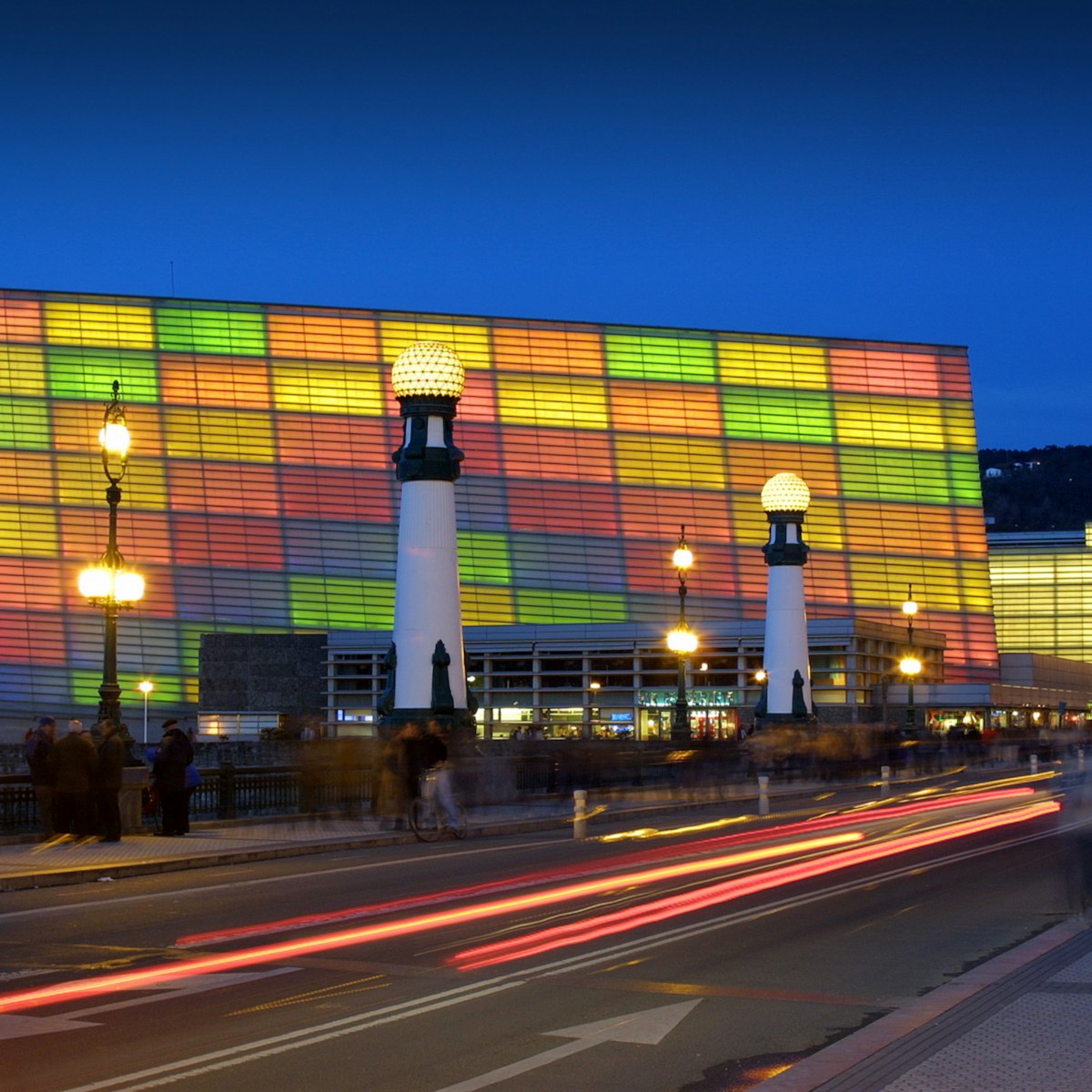
Designed by Rafael Moneo and opened in 1999, the Kursaal is one of the city's most striking buildings. Consisting of two cubes made of translucent glass…

Basque Coast Geopark
Running from Zumaia west to Deba and Mutriku, this narrow coastal strip encompasses meadows, forests, caves and, most importantly, 13km of dramatic cliffs…

Azkuna Zentroa
Take a neglected wine storage warehouse, convert it into a leisure and cultural centre, add a shot of Bilbao style and the result is the Azkuna Zentroa …
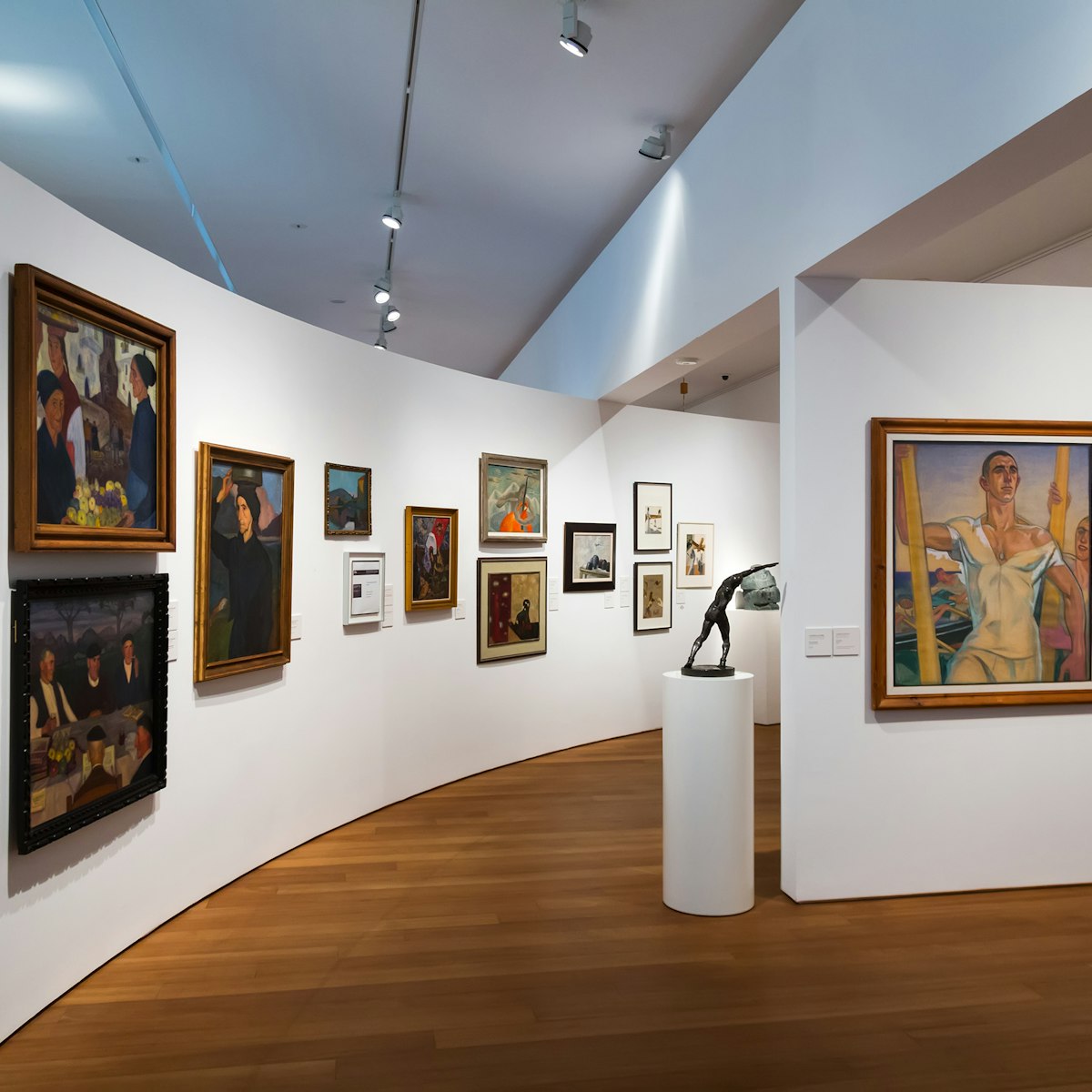
San Telmo Museoa
One of the best museums in the Basque Country, the San Telmo Museoa has a thought-provoking collection that explores Basque history and culture in all its…
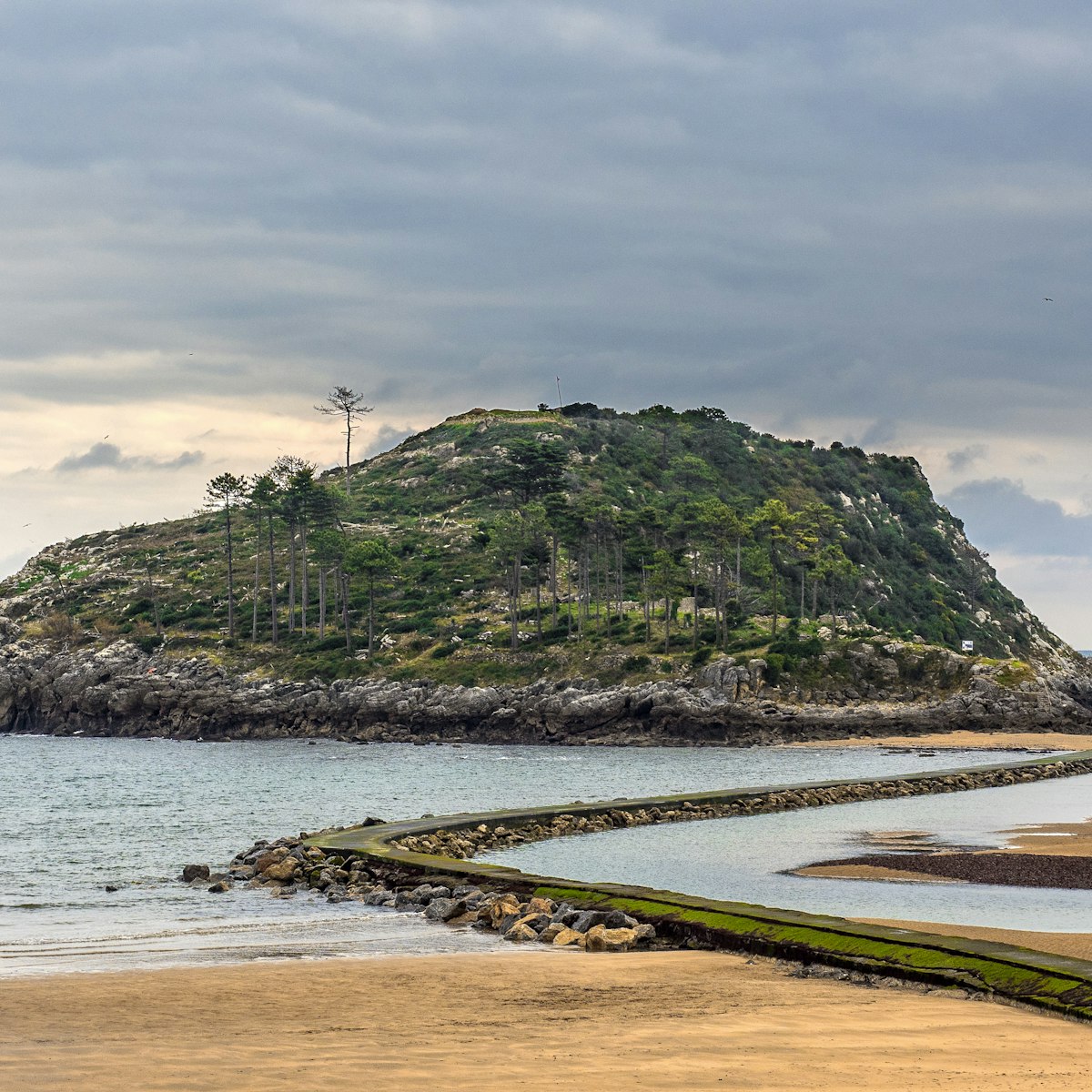
Isla de San Nicolás
One of the great attractions of Lekeitio is the rocky island, known in Basque as Garraitz, sitting just offshore of the main beach (Playa Isuntza). When…
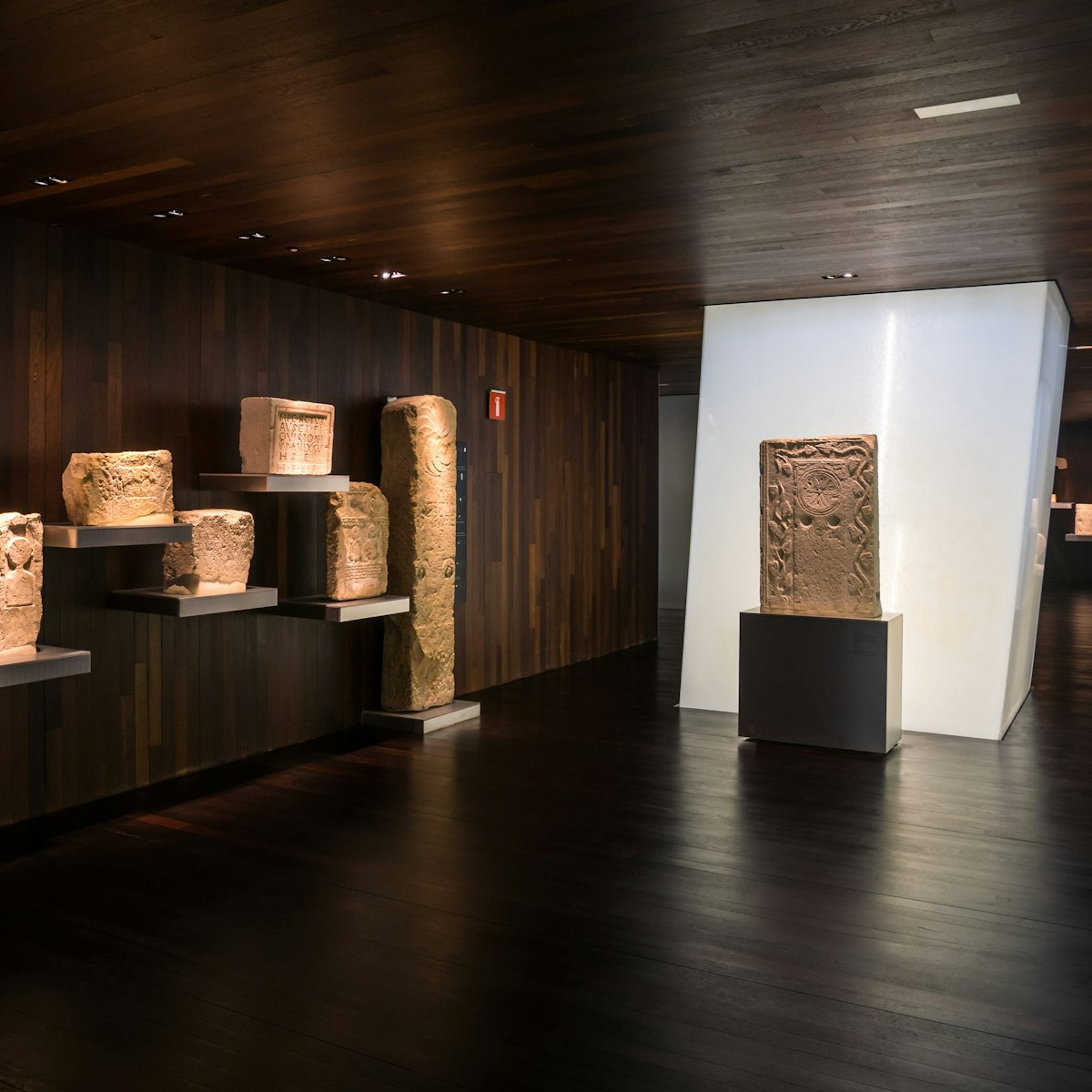
Bibat incorporates the Museo de Arqueología, whose 1500-piece archaeological collection covers the province of Álava, from prehistory to the Bronze Age …
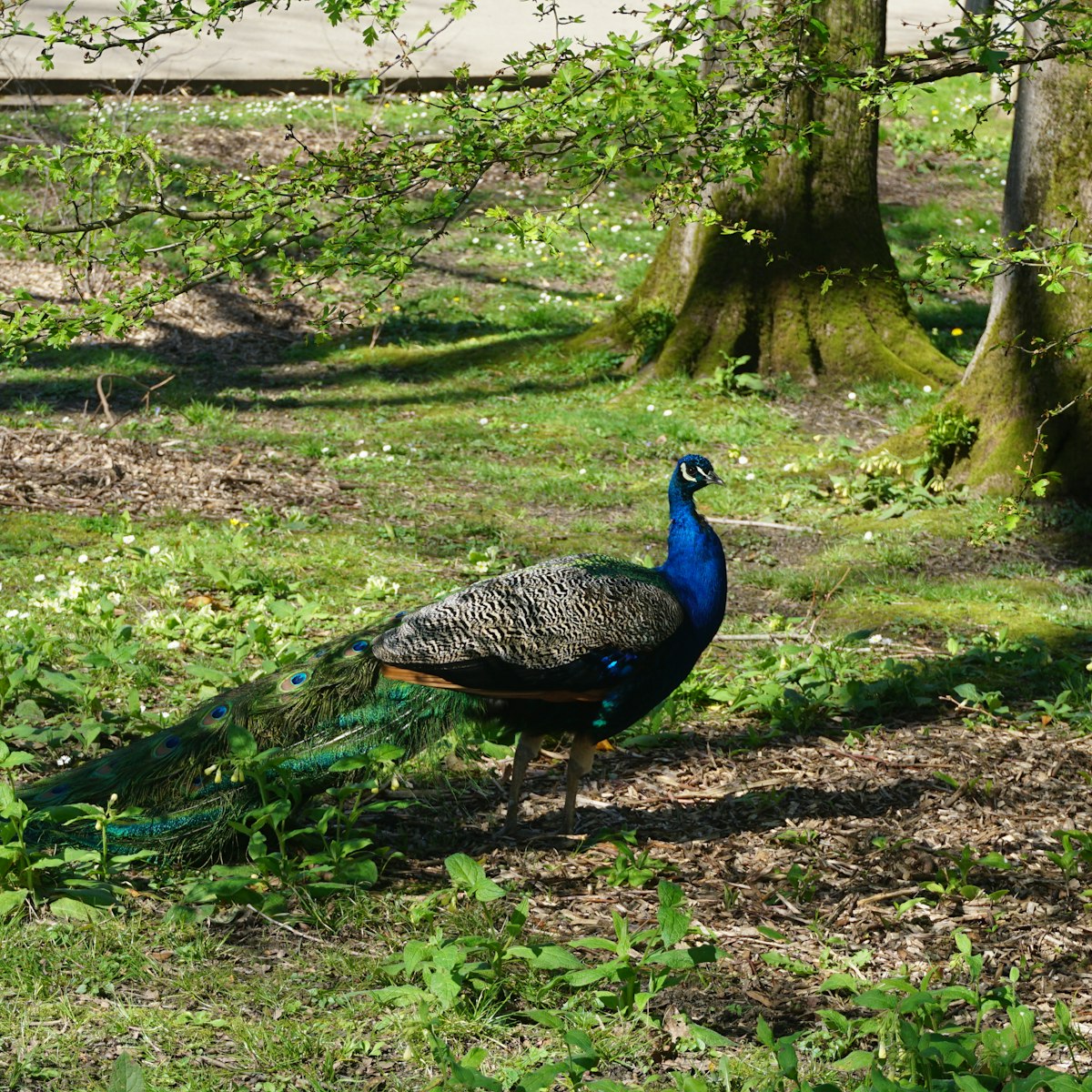
Parque de Cristina Enea
Created by the Duke of Mandas in honour of his wife, the Parque de Cristina Enea is a favourite escape for locals. This formal park, the most attractive…

This cobblestone village on the coast has much to recommend it, including excellent seafood restaurants, narrow atmospheric lanes sprinkled with shops and…
Euskal Museoa
One of Spain's best museums devoted to Basque culture takes visitors on a journey from Palaeolithic days to the 21st century, giving an overview of life…
Catedral de Santa María
At the summit of the old town and dominating its skyline is the Catedral de Santa María. Built between the 13th and 14th centuries in the Gothic style,…
Santuario de Arantzazu
Situated 10km south of Oñati, the Santuario de Arantzazu is a busy Christian pilgrimage site that's a fabulous conflation of piety and avant-garde art…
Valle Salado de Añana
For over 7000 years, 'white gold' has been produced at this site, where over 4km of wooden aqueducts transport high-saline spring water from 200-million…
Museo de la Paz de Gernika
Biscay Province
Gernika’s seminal experience is a visit to the Peace Museum, where audiovisual displays calmly reveal the horror of war, both in the Basque Country and…
Sun-drenched cultural space Tabakalera occupies a beautifully reconfigured tobacco factory dating from 1913. It's a hub for the arts and design, as well…
Puente Colgante
Designed by Alberto Palacio, a disciple of Gustave Eiffel, the Unesco World Heritage–listed Puente Colgante (also known as the Vizcaya or Bizkaia Bridge)…
Peine del Viento
A symbol of the city, the Peine del Viento (Wind Comb) sculpture, which lies at the far western end of the Bahía de la Concha, below Monte Igueldo, is the…
Anillo Verde
Ringing the city is the Anillo Verde (Green Belt), a series of interconnecting parks, ponds and marshes linked to one another by 31km of cycling paths,…
Albaola Foundation
Eastern Basque Country
This terrific museum charts the history of Pasaia's whaling industry. At the centre of the story is the San Juan, a galleon that sunk off the coast of…
Casco Histórico
Hondarribia
Hondarribia's walled historic centre, much of which dates to the 15th and 16th centuries, is an atmospheric grid of graceful plazas, cobbled lanes, and…
Iglesia de San Salvador
With its unusual shape, sloping wooden floors, and nautical atmosphere, Getaria's striking 1397-built Gothic church is well worth a stop. Features worth…
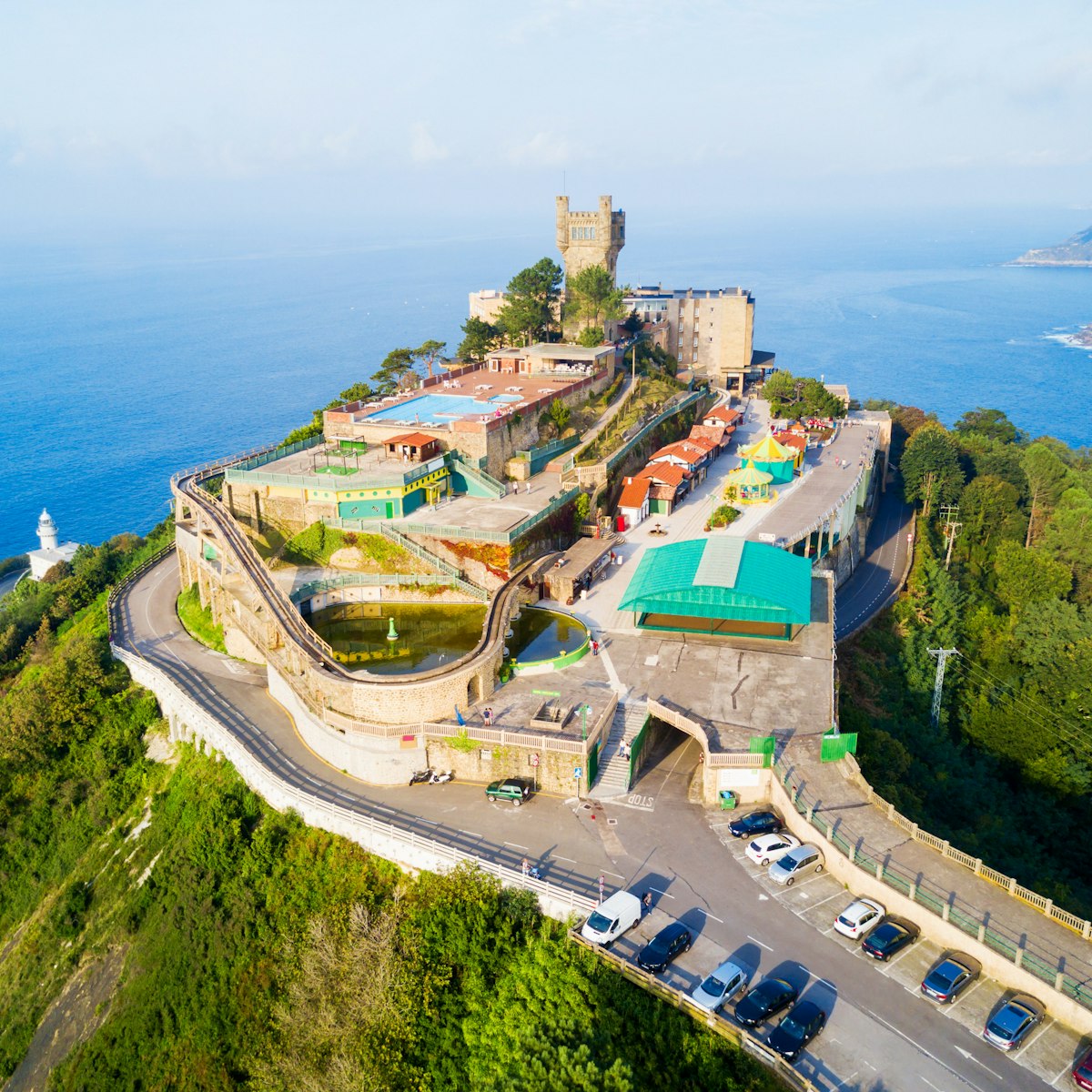
Monte Igueldo
The views from the summit of Monte Igueldo (181m), just west of town, will make you feel like a circling hawk staring down over the vast panorama of the…
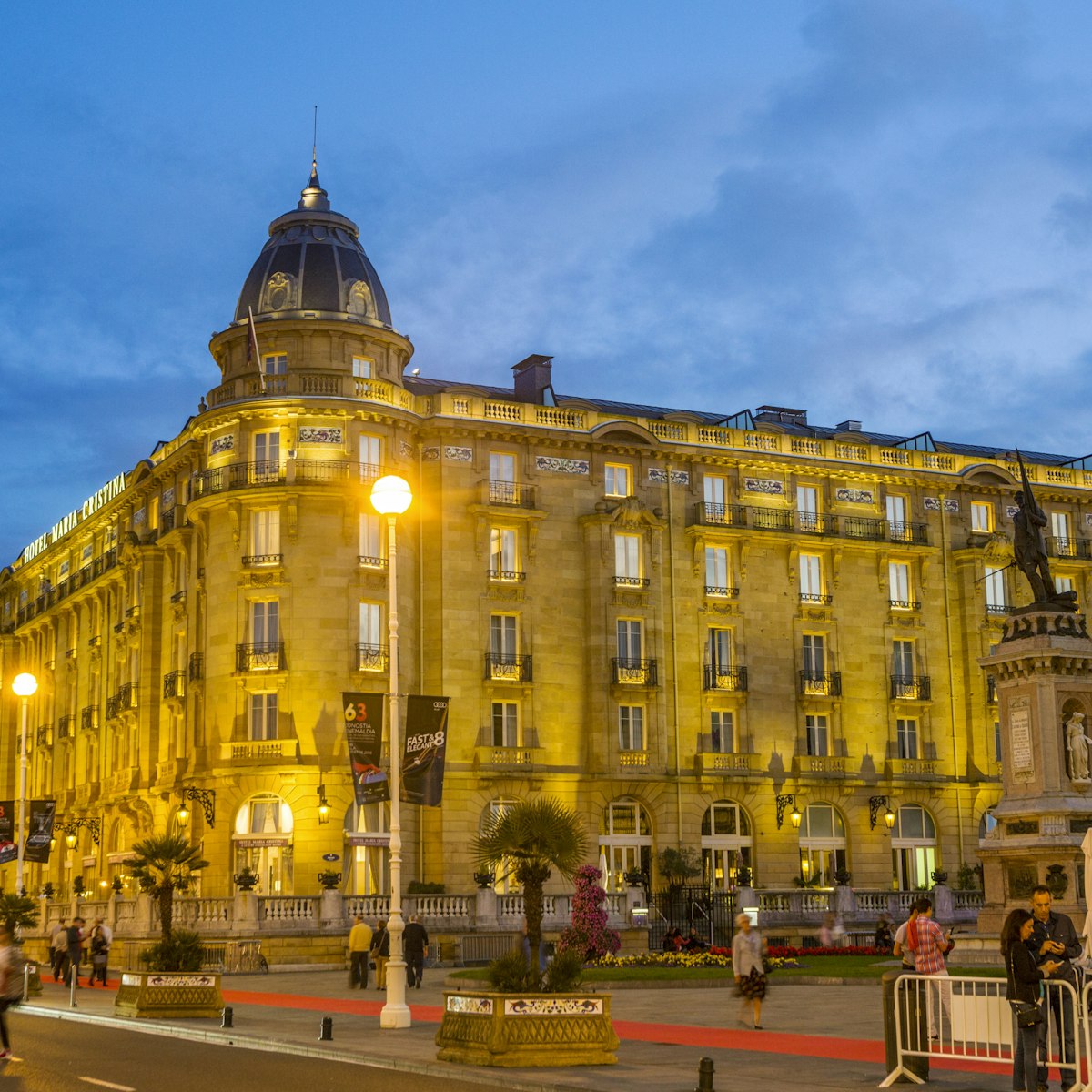
Hotel Maria Cristina
A wonderful example of belle époque architecture, the Hotel Maria Cristina was designed by Charles Mewes, the architect responsible for the Ritz hotels in…
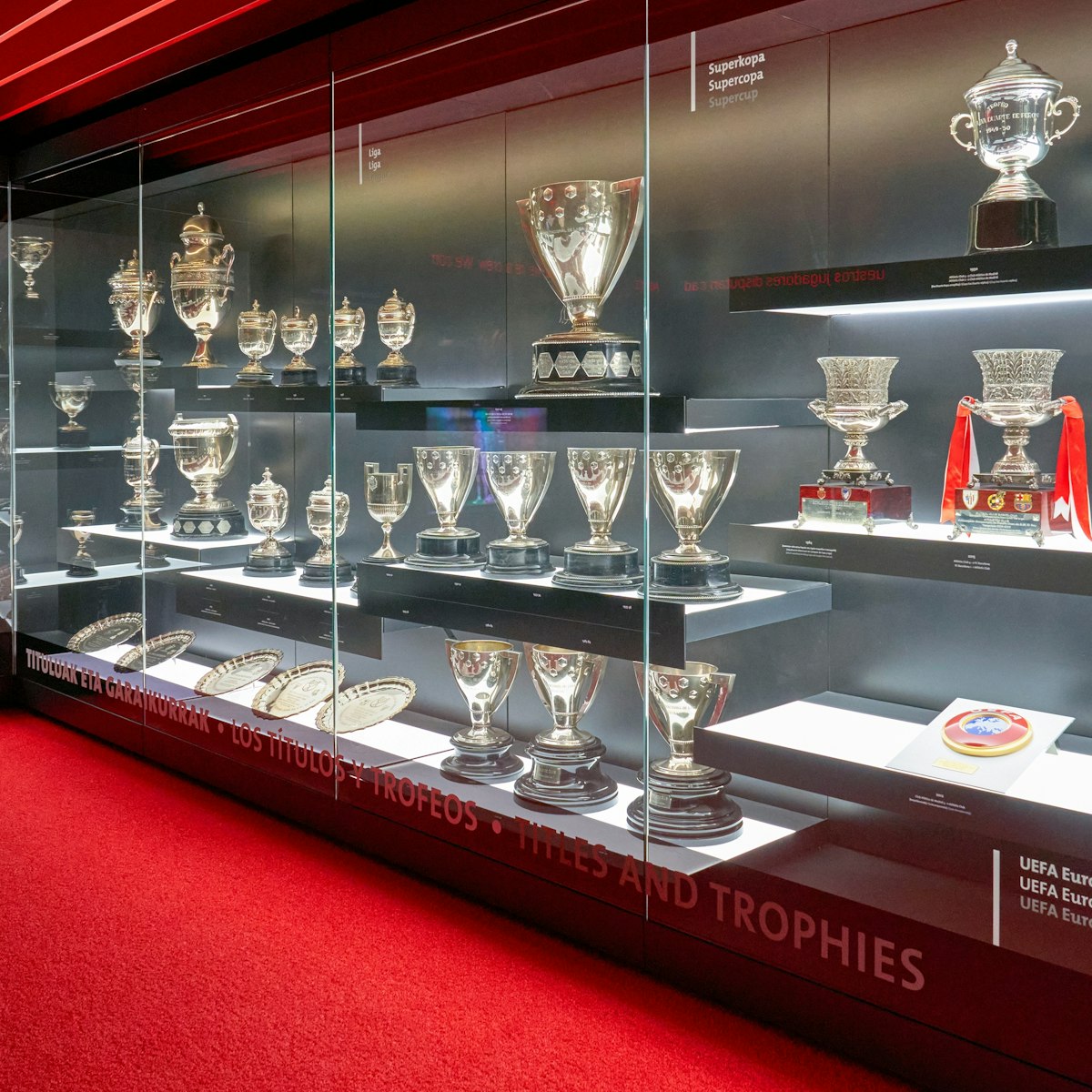
Museo Athletic Club
A must for all AC Bilbao fans, this high-tech museum delves into the club's legendary past, with gear and trophies dating back to 1905. Interactive…
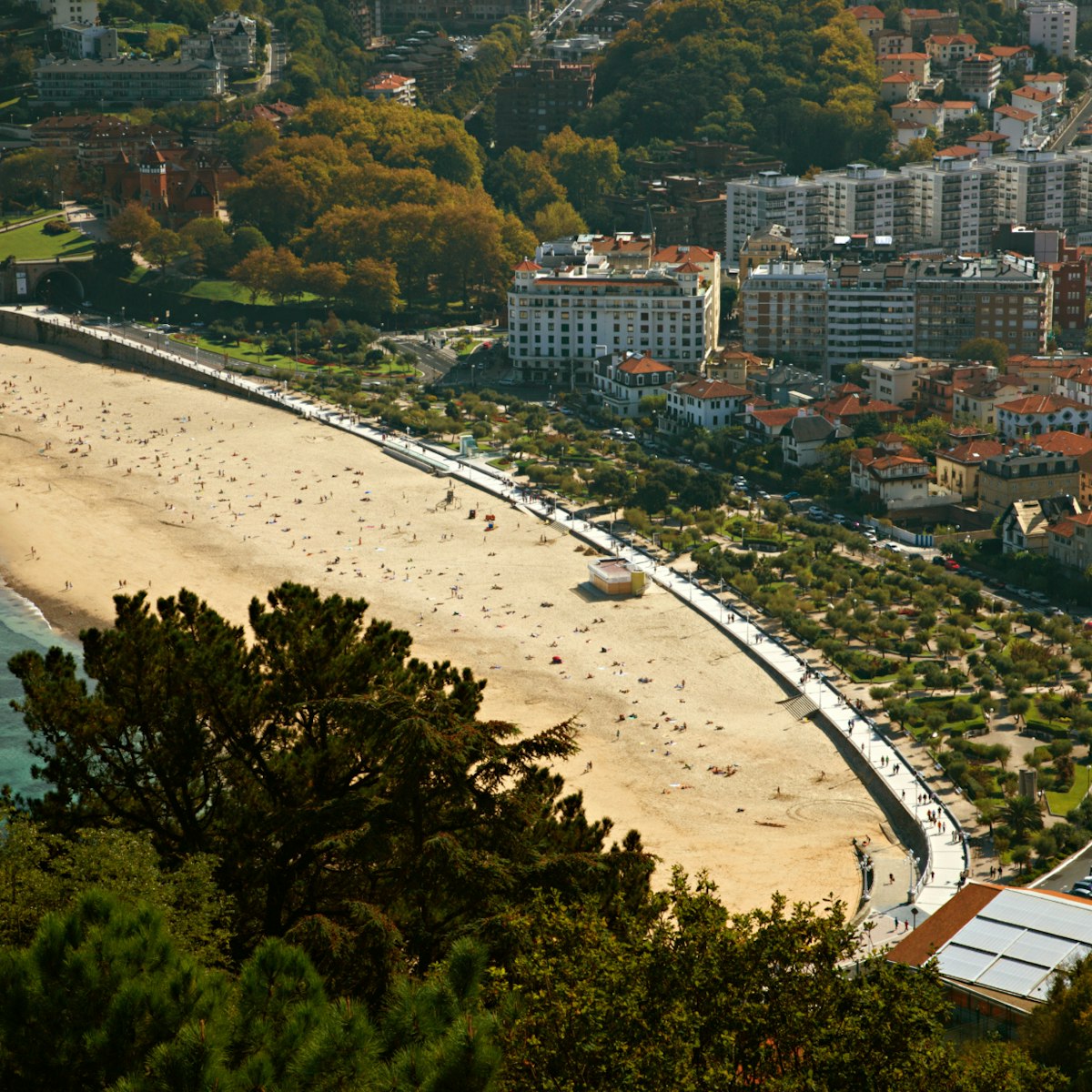
Playa de Ondarreta
Playa de Ondarreta, the western extension of the renowned Playa de la Concha, has a less glam, more genteel atmosphere. It's long been popular with the…
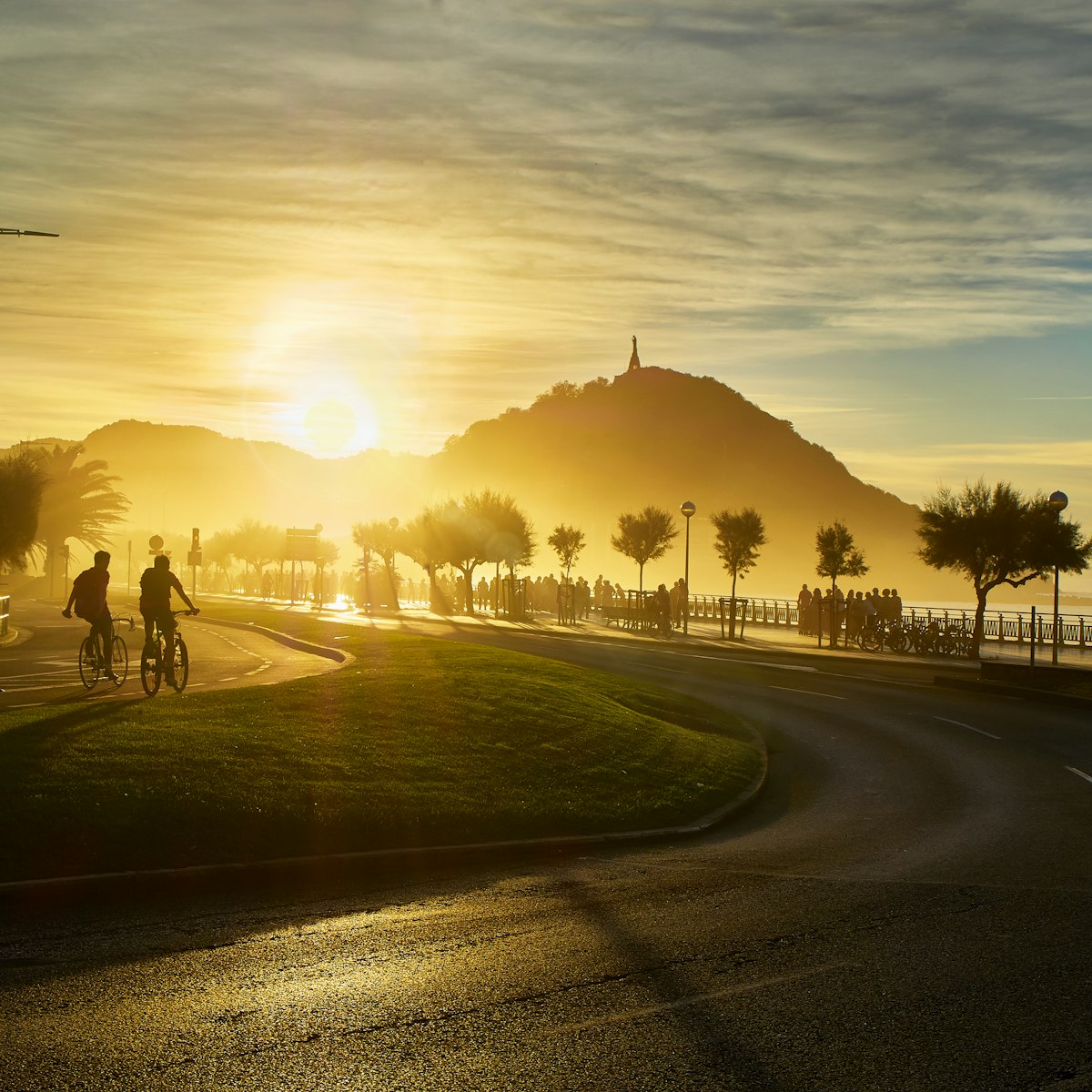
Monte Urgull
You can walk to the summit of Monte Urgull (123m), topped by the low castle walls of the Castillo de la Mota and a grand statue of Christ, by taking a…
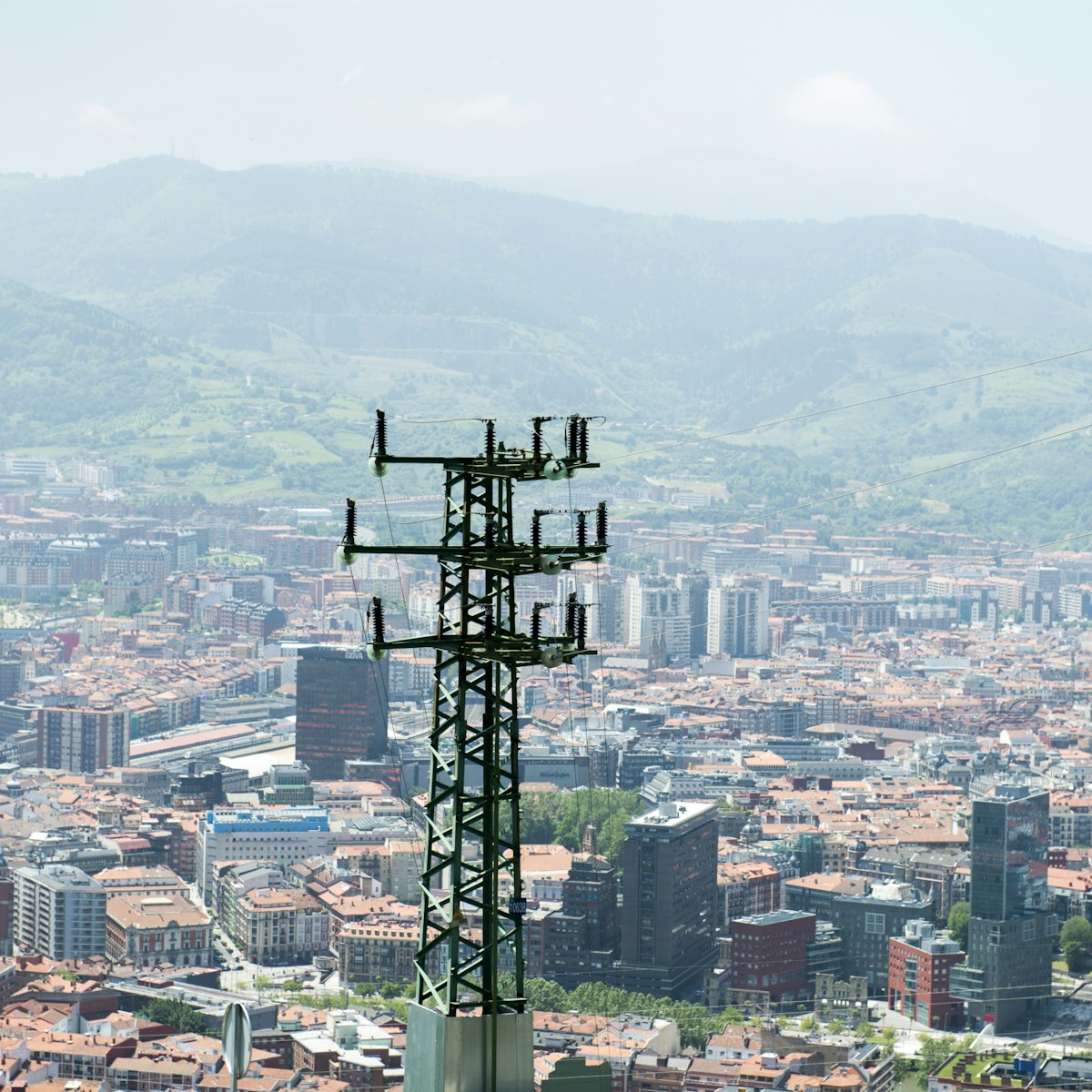
Funicular de Artxanda
Bilbao is a city hemmed in by hills and mountains, resting in a tight valley. For a breathtaking view over the city and the wild Basque mountains beyond,…
Arkeologi Museo
This two-storey museum takes you deep into the past, beginning with 430,000-year-old fossils found in the Sierra de Atapuerca. On the 2nd floor, along the…
Paseo de las Grandes Villas
The Paseo is the unofficial name given to Getxo's seafront – made up of Muelle de Las Arenas Areeta and Calle Marques de Arriluce e Ibarra. The 'Villas'…
Museo de Armería
On a peaceful, tree-lined boulevard, this low-lit armaments museum showcases weapons used over the centuries, from Bronze Age spearheads to 19th-century…
More destinations you need to see
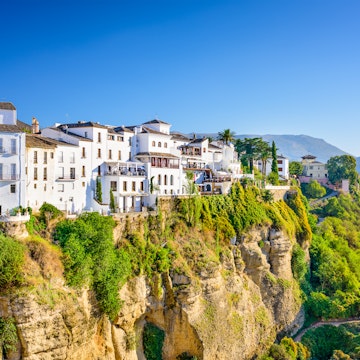
BASQUE COUNTRY
Basque Country Travel Guide

The name Euskal Herria is how the natives of the Basque Country refer to their land. It simply means, “land of the Basque speakers.” And Basque has been spoken by the feisty inhabitants well before the Romans ever arrived. Their full history as well as the origins of their language have long been shrouded in mystery.
However, their identity is very evident. This can be seen in the plethora of Basque music, dance, sports, festivals and food – all of which are celebrated with great fervor by the Basques.
Even with this strong identity, a new image of the Basque Country is emerging. Bilbao , which is now a mecca for design and architecture was, until some decades ago, a city full of decaying industrial complexes.
The city underwent a transformation and some of the finest architects in the world were invited to leave their mark. The Guggenheim Museum designed by Frank Gehry is the most well known example and it’s now the number one tourist destination in the entire Basque region.

San Sebastian is also redefining the Basque image around the world with its extraordinary cuisine. The city has 14 Michelin stars spread across 6 restaurants. It is also one of the best places to eat pintxos – culinary creations in miniature form, similar to Spanish tapas but better.
San Sebastian isn’t the only place to eat amazing food. Located just 20 minutes up the coast, the beautiful town of Hondarribia is quickly becoming a hotspot for foodies. And once you’ve eaten all that tasty food then a trip to Spain’s best wine region – la Rioja – is not far off.
There’s still so much more to be discovered in the Basque Country. The region is packed with quaint villages like those found in the French Basque Country and numerous fishing communities found along the coast. There are beautiful beach resorts such as Biarritz and some of the best surf spots in the world. Have a look through our travel guide and website – because there is just far too much to mention here.
Basque Country's Top Things to Do & See
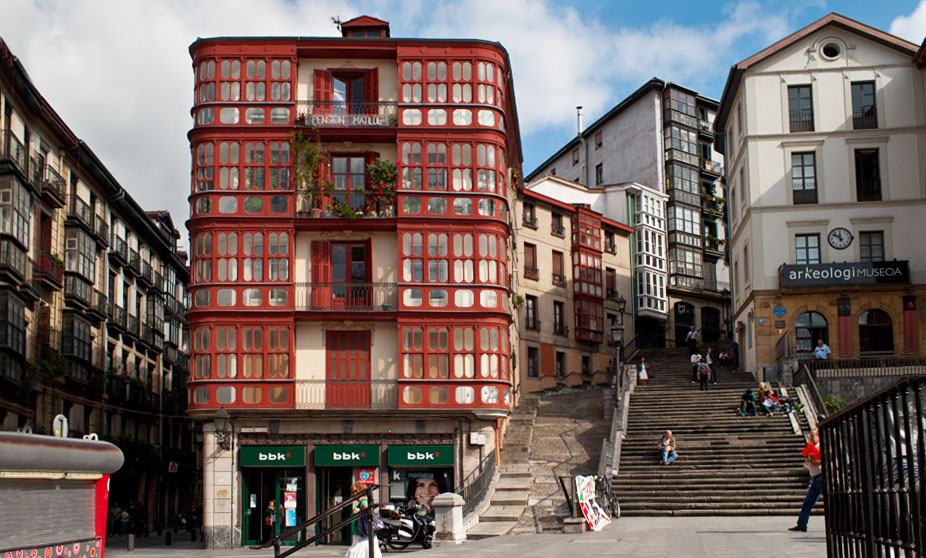
Bilbao is the beating heart of the Basque Country as well as the region’s largest and most cosmopolitan city. Bilbao’s main draw for visitors is, without a doubt, the Guggenheim Museum.
This impressive building designed by the architect Frank Gehry, is considered to be one of the most important structures of contemporary architecture. The construction of the Guggenheim marked an important turning point in the history of Bilbao.
Over the past several decades, the city has undergone a huge transformation. The old decaying industrial complexes along the river have been ripped up and a new modern Bilbao has emerged. Countless world class architects have since left their mark on the city.
Today, in addition to the Guggenheim Museum, there is a timeless Metro system designed by Sir Norman Foster, an airport and a bridge from Spanish architect Santiago Calatrava and a community center (Alhondiga) designed by Philippe Starck. The list goes on and on.
Much like the rest of the Basque Country, Bilbao is constantly evolving. While the city is embracing the future, it is also conserving its past and there is plenty of old Bilbao to be discovered. Whatever you are looking for, whether it’s savory Basque cuisine , Basque culture , shopping, nightlife, etc., you will find it in Bilbao.
San Sebastián
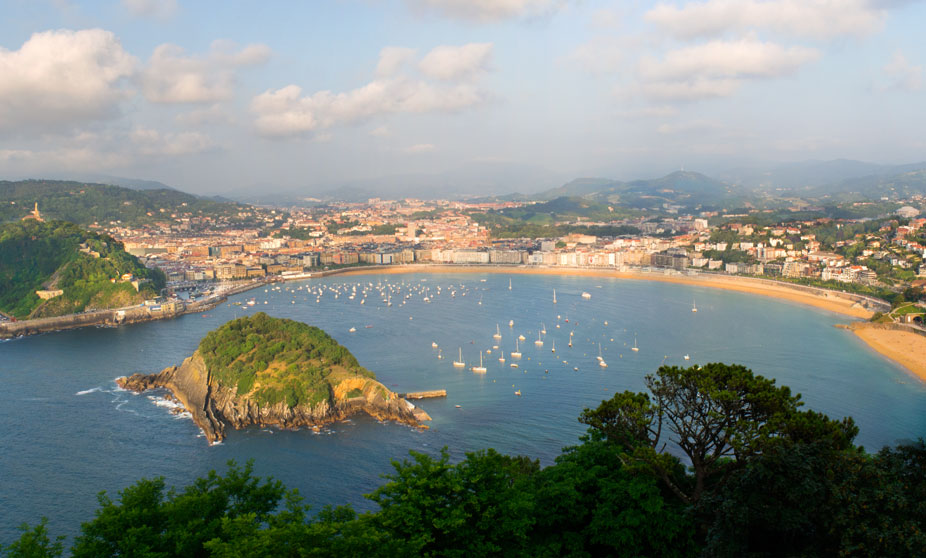
San Sebastián, or Donostia as it is called in Basque, is a majestic city with beautiful beaches and an impressive culinary scene. The city was first made famous during the Belle Époque era and is where Queen Maria Cristina established her royal summerhouse.
Since then, San Sebastián has attracted wealthy beach-goers in search of sun and sophistication. And it’s no wonder why.
The city’s main beach, called La Concha, is for sure the most beautiful urban beach in Europe. Luxurious beachside mansions run along La Concha, as well as the famous spa called La Perla (The Pearl) and its boardwalk is lined by an ornate white railing that has become a symbol of the city.
If that already weren’t enough, there are two additional beaches in San Sebastian, one of which is also very popular with surfers.
In more recent years, San Sebastián has gained significant press for its cuisine. The city alone has 14 Michelin stars spread across 6 restaurants and famously boasts more stars per capita than anywhere else in the world other than Tokyo. Restaurant Mugaritz has been ranked number 31 in the world ( 2023 World’s 50 Best Restaurants ). It is in many ways like a mini Paris, except in Basque style.
San Sebastián is also famous for its pintxos (similar to tapas). And the best place to go to try some of them is the Parte Vieja (Old Part). This charming old city center is famous for having the highest concentration of bars in the world. This is where the pintxo is king and the food is taken very seriously.

Gernika is known throughout the world due to the painting by Pablo Picasso that bears the same name (although spelled the Spanish way, “Guernica”). It was this town that was bombed in 1937, the events of which inspired Picasso’s most famous piece of art.
The bombing by German and Italian air forces took many lives and left the town utterly destroyed. The destruction of Gernika was ordered by Francisco Franco in an attempt to overthrow the Republican government during the Spanish Civil War.
One of the reasons Gernika was chosen for the bombing is due to its importance both politically and historically. The Gernika Tree can be found here and it’s where, underneath its branches, Basques were granted autonomy in the Middle Ages.
Next to the tree is the Biscayan Assembly, a place where the political leaders have meet to decide the fate of their people over the ages. Both the assembly and the tree offer insights into the history of the Basque people and can give a deeper understanding of more recent historical events such as the Basque independence movement.
In addition, Gernika also has its own Basque museum, the Euskal Herria Museum as well as the Peace Museum. For those who are interested in Basque culture and politics, Gernika is a must.
On a lighter note, the city is also host to the Monday Market, one of the most important markets of the Basque Country.

French Basque Villages & Towns
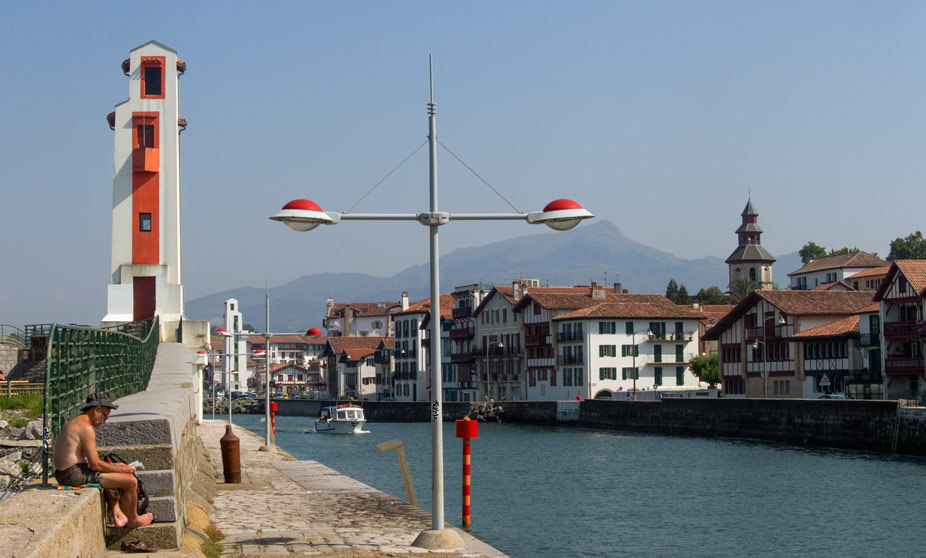
The French Basque Country has numerous well manicured villages and towns with rustic charm. A majority of them are scattered throughout the interior among the green hills of the countryside and often only occupy a street or two.
Saint Jean de Luz is one of the exceptions that is actually located on the coast and it is also rather unique since it combines traditional old Basque architecture found in the interior with stately mansions that have a French influence.
This is due to the fact that in the 17 th century the town transitioned from being one of France’s most important fishing ports to a center for Basque corsairs. These corsairs looted and plundered and brought back incredible wealth to Saint Jean de Luz, the evidence of which can still be seen.
Today, Saint Jean de Luz is a sleepy beach town that is the perfect place for families or couples who are seeking to relax in the sun while experiencing the charm of a gone-by era.
In the French Basque interior, the most beautiful village is Espelette. Its picture-perfect streets are lined with traditional Basque houses, many of which feature Espelette’s number one export, the Piment d’Espelette (“Espelette pepper”).
These drying peppers proudly dangle from lines that are attached to the facades of the houses, creating the symbol of the entire village. It is a pleasure to stroll down its streets and take in the unique scenery while stopping once in a while at the stores and boutiques that sell not only the famous peppers but also many more local products such as chocolate and cheese.
Deep in the French Basque Country’s hinterland lies another beautiful village, St. Jean Pied-de-Port. It’s unspoiled and surrounded by a green landscape making it a great place for those interested in hiking and those in search of solitude & relaxation. It is a walled village and has numerous gates.
The most well known is the Porte St-Jacques which was made a Unesco World Heritage Site in 1998. St. Jean Pied-de-Port is also a popular starting point for many pilgrims traveling along the Camino de Santiago. The camino is also listed as a World Heritage by Unesco.
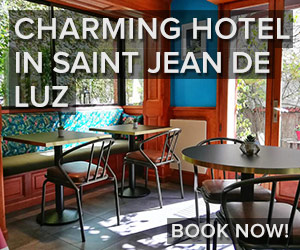
The Basque coast is full of beaches and there are far too many to even mention here. However, whichever kind of beach you are looking for, whether it is a city beach, a wild isolated beach, or anything else in between, you will find it in the Basque Country.
Laga & Laida Beaches - Located within the Biosphere Reserve of Urdaibai, these two beaches are two of the Basque Country’s most beautiful. Laida is quite special because it is located in the middle of an estuary and changes depending on the tide to reveal more or less of the sandbanks.
Lekeitio - A small town with a few special beaches and crystal clear turquoise water. In the bay lies an island that can be reached via a sandbank during low tide.
Hendaye - A 3km long sandy beach located on the French-Spanish border.
Biarritz - Posh beach resort that is popular among surfers. It’s the French Basque Country’s answer to San Sebastian.
San Sebastian - The city’s main beach, La Concha Beach, is considered to be one of the most beautiful city beaches in the world.
Saint Jean De Luz - Small beach resort that has a gentle bay and a beautiful old town. Good for families with small children.
Zarautz - Home to the longest beach in the Spanish Basque Country, known as "the queen of the beaches," and also to famous waves that attract surfers from all over the world.

Laguardia & the Rioja Wine Region
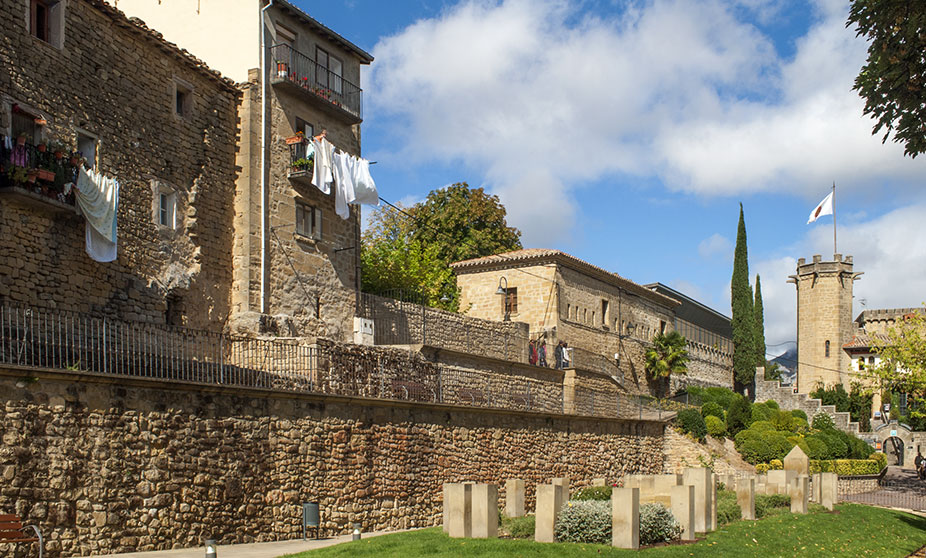
La Rioja is synonymous with Spanish wine and for good reason. Although Spain in general has very good wines, the bulk of the best wines are without a doubt coming from La Rioja. The region is divided into 3 areas: Rioja Alta, Rioja Baja and Rioja Alavesa.
Only Rioja Alavesa is located in the Basque Country and most points of interest are located within this region. However, if you are really into wine, it might be worth it to explore the entire region as the wine from the three different parts have their own particular characteristics.
La Rioja wines are of the highest quality, which is reflected in continuous ratings of 90+ points from Robert Parker, the world’s leading wine critic.
Not only is the wine amazing, but there are also many points of interest to be explored. Laguardia is a small, walled town set atop a hill in the heart of La Rioja Alavesa. The town once held a strategic military position and, because of this, tunnels and cellars were built under the houses.
After it was no longer of any military value, the villagers began to take advantage of the cellars perfect conditions for creating wine. And the rest is history.
Today, there are several wineries that still use the cellars and it is possible to tour them. It’s like stepping back in time before state-of-the-art facilities existed and the products were still very artisanal in nature. Laguardia is a definite “must see.”
There are literally hundreds and hundreds of bodegas in the region. Some are very traditional and some very modern. Modern examples can be seen at the Ysios Bodega from Santiago Calatrava and the Marques de Riscal Bodega from Frank Gehry.
Hondarribia
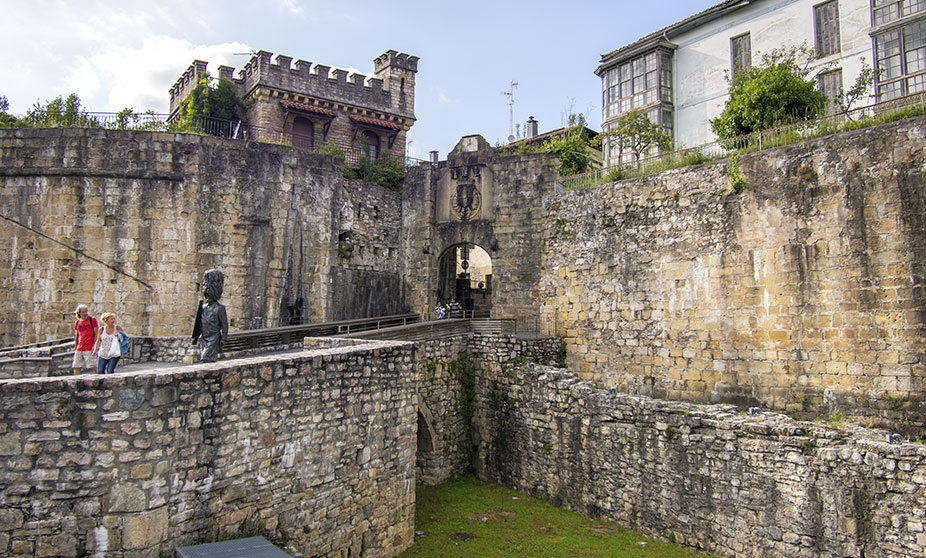
The village of Hondarribia is located on the Basque coast and is situated on the border with France. It is full of perfectly manicured houses with colorful wooden balconies. The architectural features reflect a kind of mixture between Spanish and the French Basque Country characteristics and make it of particular interest.
In addition to being a pleasure to explore, it is also home to some of the Basque Country’s best restaurants and is quickly becoming a foodies paradise.
Hondarribia is packed with a huge number of amazing restaurants and bars – some of the very best in the region in fact. If you are into Basque gastronomy, your trip won’t be complete if you don’t visit Hondarribia.
The well-preserved Old Town, a relaxing maritime atmosphere and fantastic food are only some of the reasons why Hondarribia is one of our favorite places in the region.
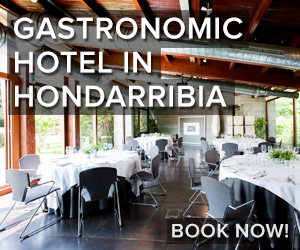
San Juan de Gaztelugatxe
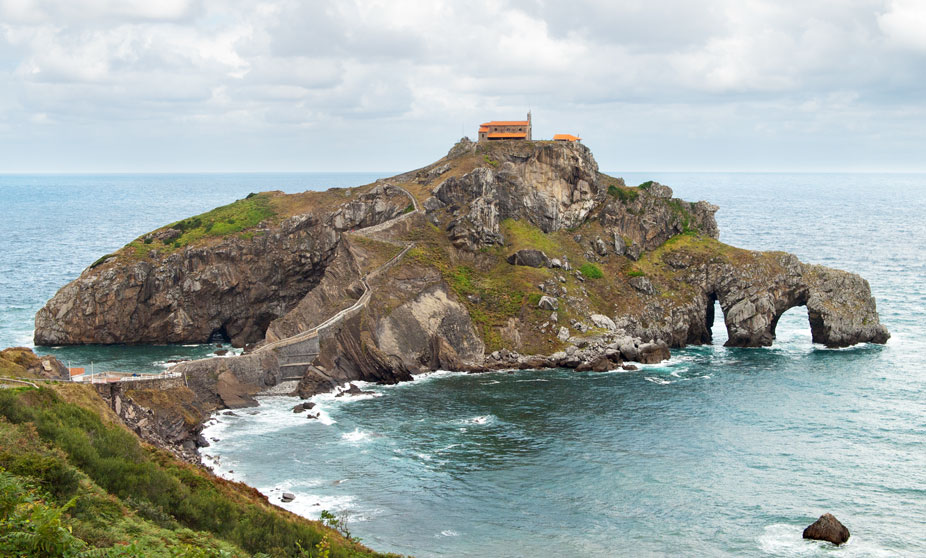
San Juan de Gaztelugatxe, whose name means “castle rock” in Basque (“gaztelu” = castle + “aitz” = rock), is a definite “must” if you are visiting the Basque Country. It is an awe-inspiring island located just off the shore along the Bay of Biscay. The views to, from, and around the island are simply beautiful.
San Juan de Gaztelugatxe is accessed by a man-made stone bridge. The bridge transitions into a narrow path that contains 241 steps and zigzags its way back and forth to the top. At the highest point of the island there is a tiny church dedicated to John the Baptist.
The island also has an intriguing history. Throughout the years it has housed a convent, served as a prison for Basque witches during the Spanish Inquisition, been used as a defensive outpost for the lords of Biscay, and was even ransacked by Sir Francis Drake.
Getaria & Txakoli Wine
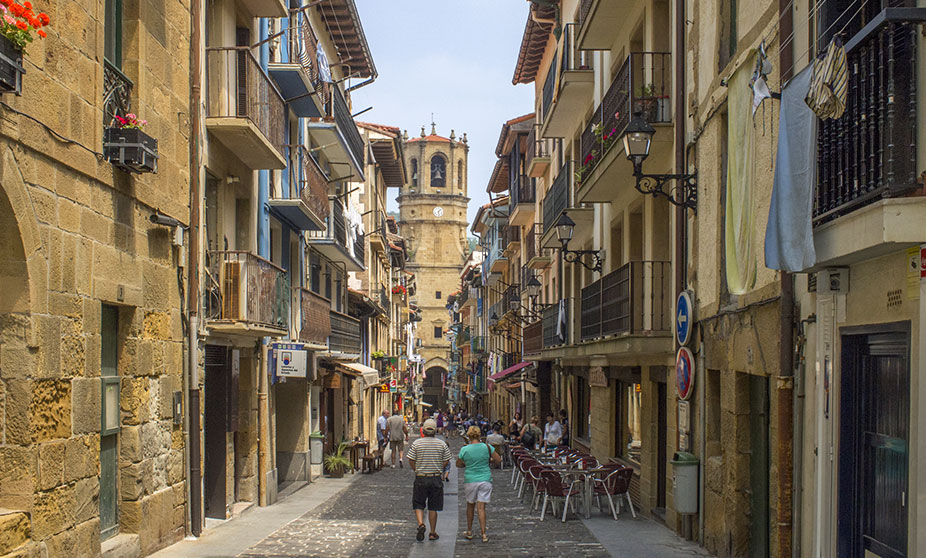
Getaria is a charming fishing village that’s wedged between two beautiful beaches and a tiny island and sits adjacent to the green rolling hills of the getariako txakoli wine region.
Txakoli is a slightly sparkling, young and fruity white wine that is produced in these unique vineyards overlooking the ocean. Although txakoli has been around for centuries (the first mention of it dates back to 1520), it has just started to become popular in recent years, and not only in the Basque Country but also all over the world.
Some of the txakoli bodegas offer tours, while others offer tastings and almost all of them offer direct sale. However, to fully experience txakoli, you must visit one of the many restaurants at the harbor where you can enjoy a bottle with some freshly caught fish that is grilled outside over charcoals. The lovely setting along with great food and wine is one of the reasons we love Getaria so much.
But Getaria has more to offer, especially if you are into fashion design. This little town is actually the birthplace of the famous fashion designer Cristóbal Balenciaga.
Balenciaga, who was born in 1895, was a true fashion innovator and was respected throughout the fashion world for both his techniques as well as his perfectionism. In 2011, the Balenciaga Museum was opened in the Aldamar Palace and today, proudly displays many of his haute couture creations.

San Fermin – Running of the Bulls
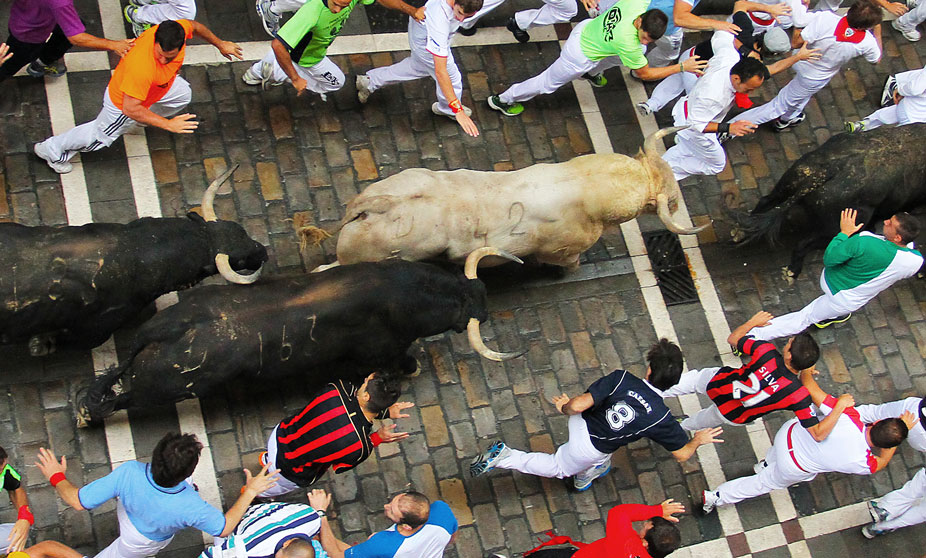
The San Fermín festival and the legendary running of the bulls, attracts over a million visitors every year to Pamplona. The festival starts the 6 th of July at 12:00 PM with the “txupinazo,” a small firework that is fired from the balcony of the City Hall.
During the week of San Fermín, Pamplona is flooded with party-goers from all over the world each donning a white t-shirt and a red handkerchief. The activities and events of the festival consist of concerts, rural sport competitions, Basque dance and music, nightly fireworks shows and much more.
However, the most famous event of San Fermín is, without a doubt, the running of the bulls (“encierro” in Spanish). This event, which was immortalized in Ernest Hemingway’s book, “The Sun Also Rises,” takes place every morning at 8:00 AM between the 7 th and the 14 th of July.
Runners are chased by six bulls for approximately 800 meters until they reach the bullring (“plaza de toros” in Spanish). This is a very dangerous activity and while some people train all year preparing for it, others decide to join at the last moment, convinced by the amount of alcohol drank during the night before. This makes the running even more dangerous and unfortunately 15 people have died doing it since 1924.
Nevertheless, the running of the bulls is an extremely popular activity and something unique that is worth seeing at least once.

Biarritz & Bayonne
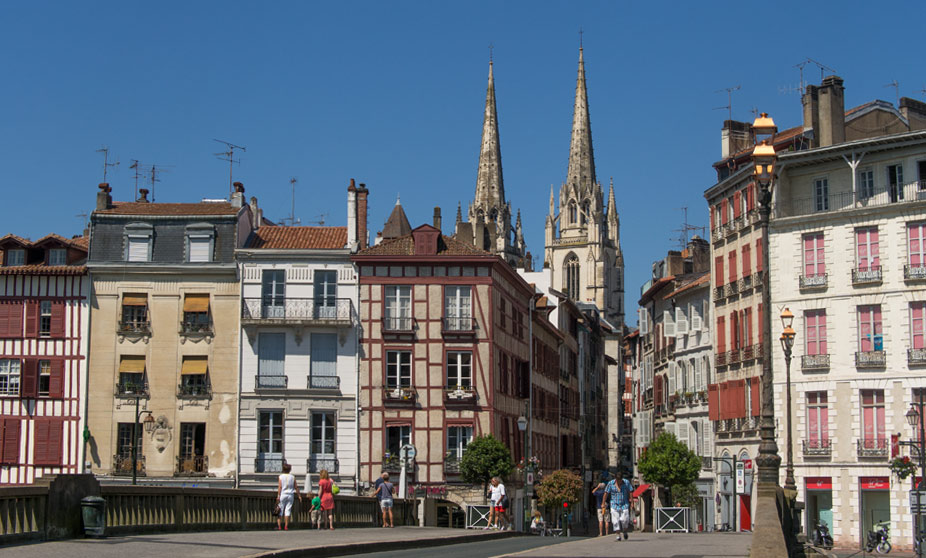
Biarritz and Bayonne are separated by a mere 8 km, however, they are two very distinct places of interest. We have grouped them together here because if you visit one, you should definitely take the time and check out the other – you won’t be disappointed.
Biarritz Biarritz is famous for its beaches, therapeutic water and a thriving surf scene. It’s a place where posh restaurants and spas live harmoniously side-by-side with laid-back pizza joints and surf shops.
When Empress Eugenia, wife of Napoleon III, built her palatial summer residence next to the sea, Biarritz was forever changed. The small whaling town transformed into a trendy spa and holiday destination for France’s elite.
Today the town is full of grand summer houses and has an up-scale feel to it. However, the atmosphere in Biarritz has been balanced off by a laid back surf culture that has deep roots in the area. This interesting contrast forms part of Biarritz’s identity and adds to its charm.
Bayonne Every year, more than one million people descend on Bayonne for what is France’s largest festival, the Fetes de Bayonne. It is reminiscent of the San Fermin festival of Pamplona , where the bull plays an important role in many of the events throughout the week.
However, during the rest of the year, Bayonne is a relatively quiet and stress free city. It is a picturesque place with a nice mixture of Basque and French architecture as well as a massive gothic cathedral with a cloister from the 13 th century.
And if you are into food, then you might also want to check the local chocolatiers and the infamous Bayonne ham.

Nature Parks
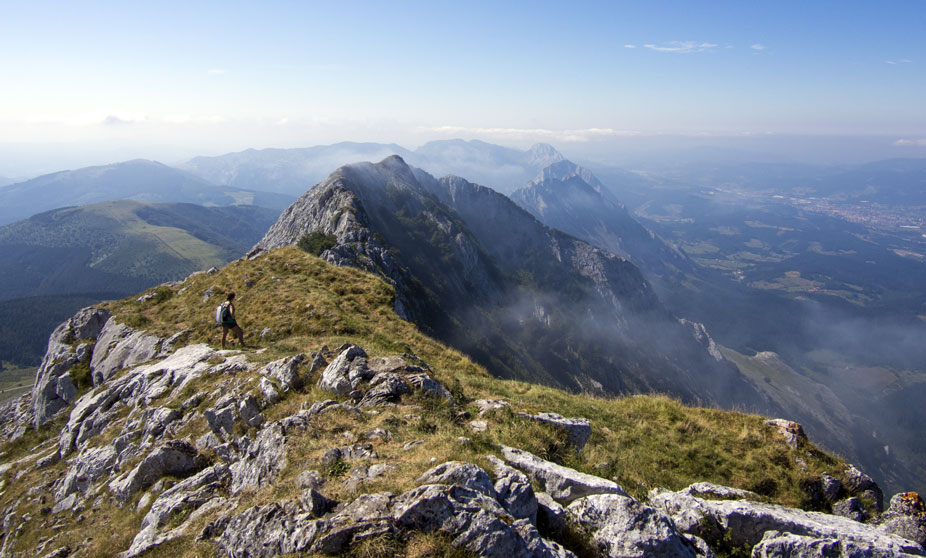
In general, the Basque Country is pretty sparsely populated. Outside of the cities and towns, life still revolves around the Basque farmhouse, known as a baserri. Whether they are tending to a flock of sheep, raising livestock or making cheese, the Basques of the baserris still have a strong connection with the land.
It is a land full of natural wonders and thankfully many are protected natural parks. Not only can you experience the beauty of the parks but there is also a good chance you will come across a Basque shepherd with his flock or see some Basque ponies (pottokas).
Although there are far too many parks to mention here, we are listing a few of our favorites.
Urkiola - This nature park is situated in a mountain rage with the highest point being the Anboto at 1331 m. It is possible to hike to the top of the Anboto and to a few lower peaks. The views are impressive.
Urbasa-Andia - The highlight of this park is the Nacedero del Urederra – the birthplace of the Urederra river. A path runs along the river into the forest where pool after pool of clear blue water lead to a waterfall. The water color is simply amazing and even in person, looks surreal.
Bardenas Reales - This is one of only a few deserts in Europe and it’s definitely the most impressive of them all. There are several unique geological formations and some lovely landscapes. Explore the park by car or get in a little deeper by hiking or riding a bike on one of the many paths.
Le Petit Train de la Rhune in Sare - This quaint train has been operating for more than 90 years and takes visitors 905 meters up the Rhune Mountain to get a 360° view of the Basque Country and the Atlantic Ocean. Great for those who want the views without having to hike.
Ruta del Flysch - If you are into long all-day hikes, then you shouldn’t miss the Ruta del Flysch. This path goes along the coast between the towns of Deba and Zumaia and offers amazing vistas of the coastal flysch rock formations. This is the most beautiful hike of the entire Basque Country in our opinion.
Basque Gastronomy
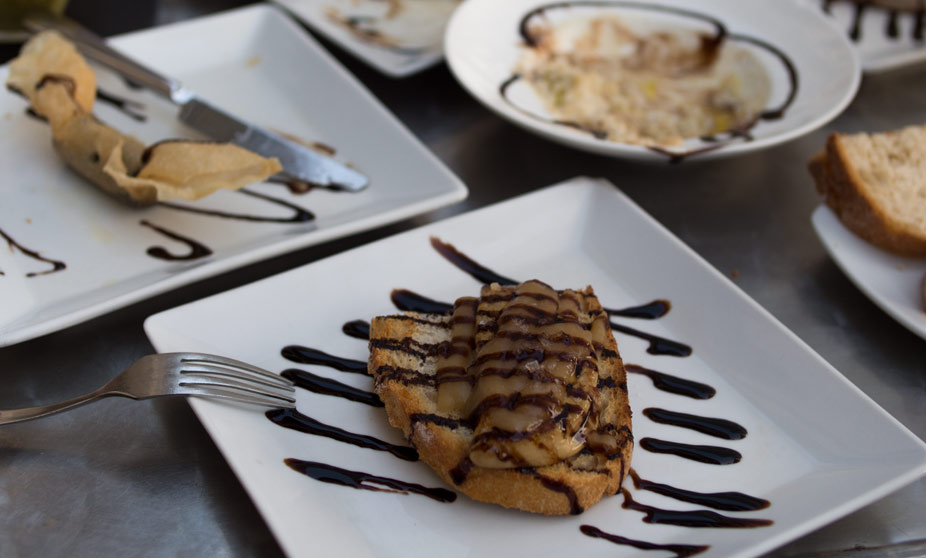
It’s possible to find good food all over the Basque Country. However, San Sebastian and Hondarribia are probably the two places with the highest concentration of quality establishments.
If you are interested in visiting a Michelin starred restaurant, be sure to check out our Michelin page that contains all of the Michelin restaurants located within the Basque Country.
Pintxos The Basque Country has its own unique food culture that revolves around the bar. Pintxos ( bite-sized appetizers, similar to tapas ) can be found in nearly every bar. Often the bar counter will be filled with plates of all different varieties.
They range from being rather traditional to very experimental in nature. It is typical to find the locals out enjoying a drink while sampling different pintxos and then going on to the next bar to do the same thing all over. This is sometimes done before a meal as a kind of aperitif or it can take the place of a normal meal.
In addition, every city and town has yearly competitions for the best pintxos and the winning trophies are proudly displayed within the bars.

Sagardotegi The Sagardotegi (sidrería in Spanish), is another special Basque tradition. It is a type of cider house that is found within the Basque countryside. These restaurants serve a traditional set menu with their highlight being the enormous txuleton steak .
This mouth-watering slab of un-adulterated beefy goodness weighs in at around one kilo and like the other plates are shared by those at the table. The other highlight of the sidrería is the endless supply of cider from giant wooden barrels (kupelas in Basque).
The sidrería is a great chance to experience something uniquely Basque and eat like a king.
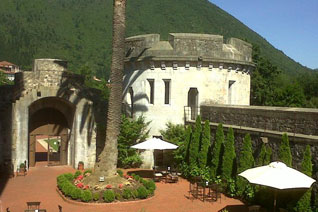
Search Hotels, Compare & Save
Basque country history.
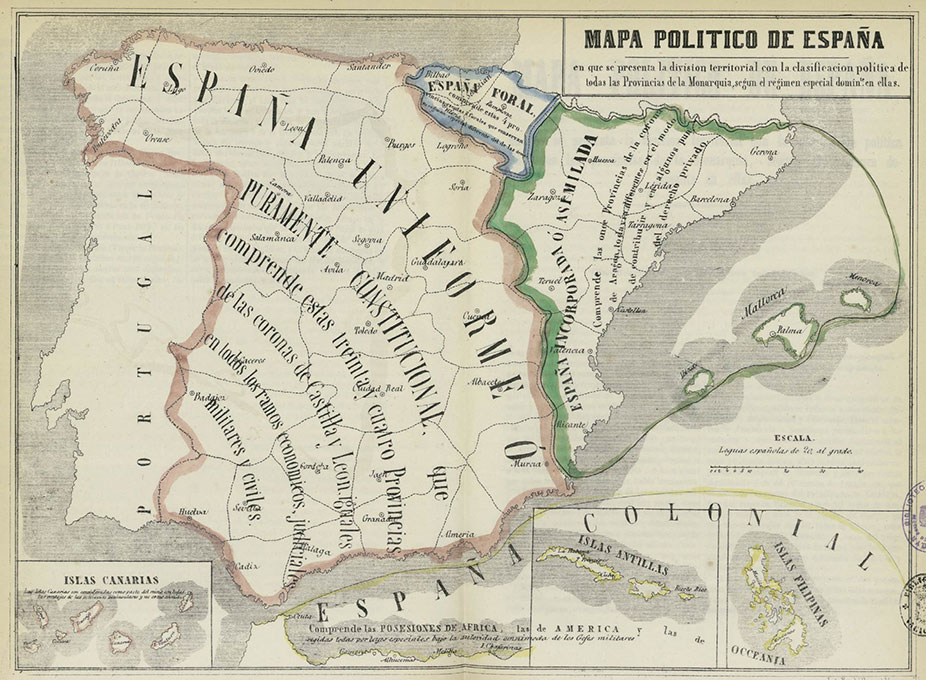
No one is exactly sure where the Basque people come from. The people along with the language seem to have been around since long before indo-european speakers arrived. Basque speakers lived predominately in Aquitaine which extended through the Pyrenean Mountains and north along the French coast.
The area changed hands many times through history and eventually, in the Middle Ages, the Kingdom of Castile gained control over what is today the Spanish Basque Country. Navarre became its own Kingdom and the French Basque Country was absorbed by France.
Basque Fueros (set of laws similar to a constitution) were established between the Basque regions and their respective kings and allowed for them to function as an autonomous community. These fueros were used as the rule of law until after the Second Carlist War in 1876 when they were stripped away. This action was the catalyst that started a movement towards nationalism.
After enjoying hundreds of years of autonomous rule, the Basques were now being oppressed and starting to lose aspects of their culture and identity. In response to this, Sabino Arana, who is considered to be the father of Basque nationalism, created the Basque National Party (PNV) and started a cultural renaissance.
Everything that was considered Basque was celebrated. Arana also designed the Basque flag, called the Ikurrina, which can still be found in use throughout the Basque Country.
The nationalist movement gained most of its momentum following the Spanish Civil War (1936 - 1939). The dictator Francisco Franco took control of Spain and the Basques suffered greatly under his heavy hand. In his quest to create a unified Spain, languages and customs not considered to be Spanish were prohibited. This also included the use of the Ikurrina.
However, the flag was often placed in public places and became a symbol of defiance. Franco created an obvious backlash by trying to destroy the Basque culture and that helped give roots to the nationalist movement.
In 1959, a new chapter of Basque history began with the formation of ETA (Euskadi Ta Askatasuna – "Basque Homeland and Freedom"). The group started by promoting Basque culture but later developed into a paramilitary group whose goal was to have an independent Basque Country.
Some of ETA’s first attacks were generally approved of by Spanish and Basque societies who saw them as part of the fight to put an end to Franco’s regime. They were responsible for the assassination of the Spain’s Prime Minister and successor to Franco, Luis Carrero Blanco. Many consider Carrero Blanco’s death as an important step in the establishment of Spain’s democracy.
ETA subsequently continued their fight for independence for more than 50 years in what has been referred to as “Europe’s longest war.” The conflict resulted in the deaths of more than 1,000 people. In 2011, ETA announced a “definitive cessation of its armed activity.” It seems now that this chapter of Basque history has finally come to an end.
Basque Language
Euskara, the language of the Basques, is the last remaining descendent of the pre-indo-european languages. Throughout time the area containing Basque speakers continued to shrink, but as luck would have it, never completely disappeared.
Since it is the last survivor of its language family, it is considered a language isolate, meaning that it doesn’t have any relationship with any other language.
Euskara suffered greatly during the dictatorship of Francisco Franco (1939 - 1975) since it was prohibited. By the time Franco died, the language was in steep decline. In an attempt to save it, the Basque Language Academy (Euskaltzaindia) took the various Basque dialects and combined them, forming a standardized Basque language called Batua.
Batua was introduced into the education system and it is now common for children to take either some class or all of them in Basque. This along with newspapers, magazines and a TV station have helped the language rebound.
Today, one of the most significant criteria for being Euskaldun (Basque) is the ability to speak the language. There are only 715,000 native Basque speakers who are very proud of their language. They don’t expect visitors to be able to speak a word.
So you can image how impressed a local would be if you, a foreigner, said anything to them in Basque. This is the easiest way to make friends in Euskal Herria. For this reason we have compiled a list of words and expressions to aid you in your journey.
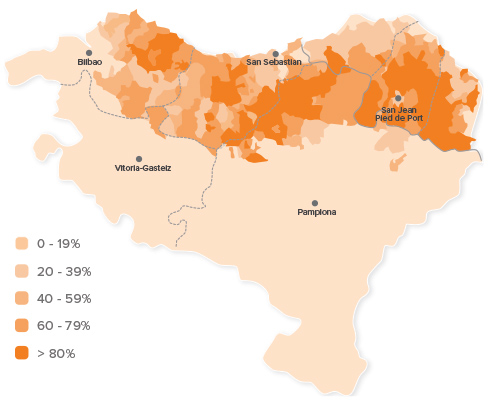
The weather in the Basque coast is quite moderate due to the ocean breeze. Some areas on the coast are more susceptible to rain. The interior has temperatures that are slightly more extreme. Usually a few degrees hotter in the summer and a few degrees colder in the winter.
The wine region of La Rioja Alavesa has a microclimate and in the summer is almost always sunny. Summers are warm, but not incredibly hot like the south of Spain for example. It is not unusual though for temperatures to reach 30ºC (86ºF).
Bilbao : Loiu airport is the largest in Basque Country. There are cheap flights with Easyjet and Vueling to London and with Vueling to Barcelona and Malaga. There are many connections to other European cities with other companies such as Iberia, Lufthansa, Air Berlin, Bruxelles Airlines.
San Sebastián-Donostia : Hondarribia Airport has flights to/from Barcelona & Madrid.
Biarritz : Flights with Ryanair from Dublin, London (Stansted), Shannon (Ireland) and Frankfurt, and with Sterling Airlines from Oslo and Copenhagen.
Madrid : It is possible to catch a flight to Madrid and then take a bus or a train to the Basque Country. Direct buses run approximately every hour and take about 4 - 5 hours.
Book flights at the best price on Omio
Daily connections are offered to main cities from Paris, Madrid and Barcelona. You can also travel within the Basque Country with the scenic routes of the EuskoTren network. The main drawback to EuskoTren is that is takes about twice as long as the same trip by car.
Get the best deals on train tickets on Omio
Both Spain and France have extensive bus infrastructure and this is one of the easiest and most comfortable ways to travel. You can always find connections between cities and most larger towns. However, access to more remote villages may be limited as would be expected.
Get the best deals on bus tickets on Omio
A rental car is really great to have in the Basque Country. It makes for access to some parts of the region such as San Juan de Gaztelugatxe and to the sagardotegis (traditional Basque cider restaurants in the countryside) much easier.
Driving along the coast and through the Basque interior is beautiful. If you do rent a car, we recommend not staying on the highway the whole time and driving through the country side as it is very rewarding and you get to see a part of Basque life that you would otherwise not be able to.
Some of the highways are also toll roads in the Basque Country. The most expensive one is between Vitoria and San Sebastian and costs around 12 €.
If you take the alternative free route, it takes about 20 minutes longer, but is much more scenic.
Car Rental – Search, Compare & Save
Is Eusko Guide helping you plan your trip?
If so, please consider booking your hotel through the links to booking.com found on our website or use the following link: https://www.booking.com/?aid=360107
That way, you get the best rates on your hotels and at the same time, it helps us to continue contributing to this site. Everyone wins!
Travel Safe
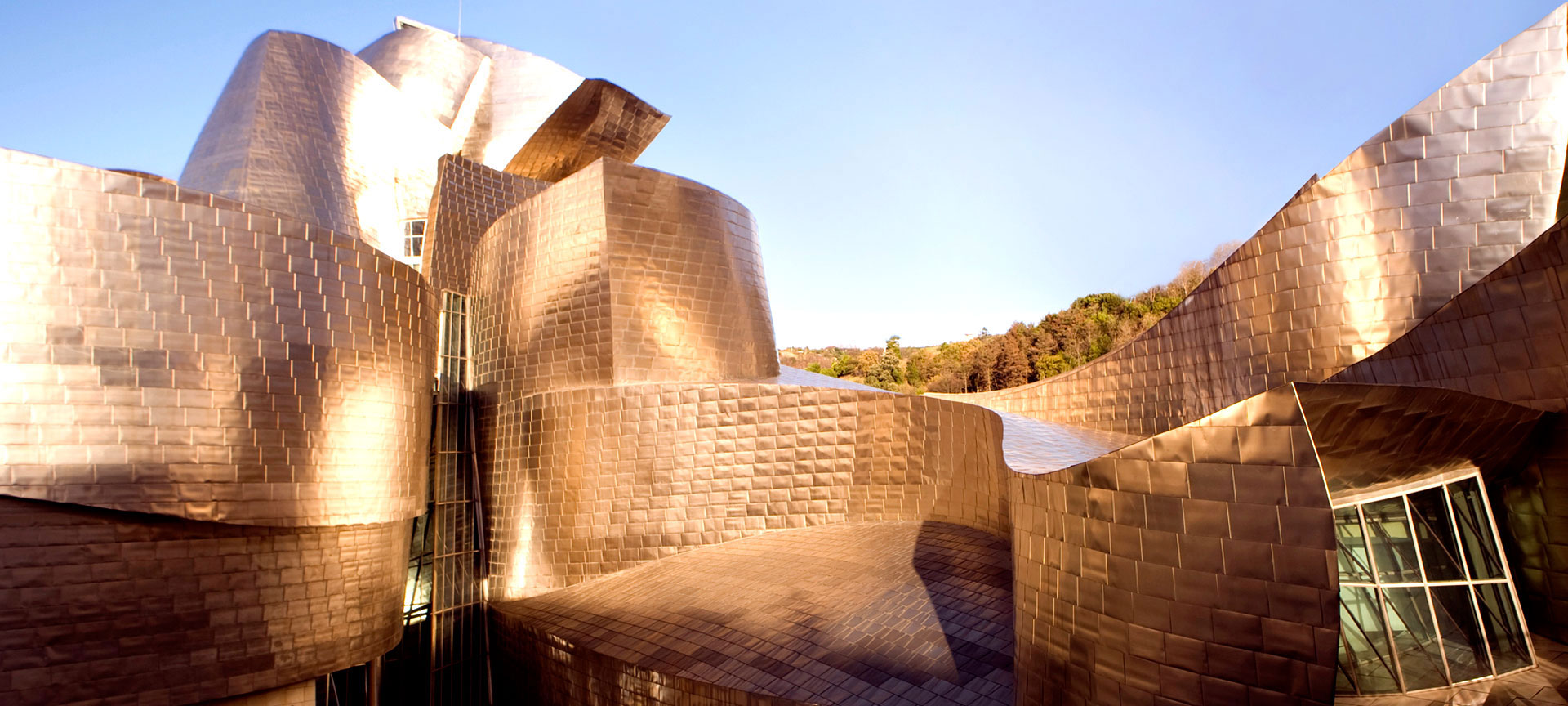
Basque Country
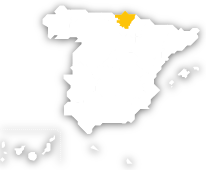
Get to know the provinces of Basque Country
Araba-Álava (Province)
Gipuzkoa (Province)
Bizkaia (Province)
This is the site of the Gothic cathedral of Santa María de Vitoria, a must for visitors, and particularly now that that the building can be seen while the restoration works are actually taking place.…
One of the best-known images of this area is the view of the bay of La Concha in the capital, Donostia-San Sebastián.…
Vizcaya is the most densely populated province in the Basque Country, and has both cities and rural areas which conserve the full flavour of country living.…
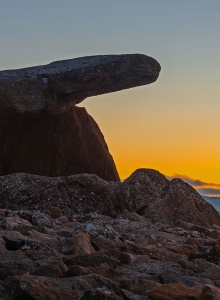
Places not to be missed
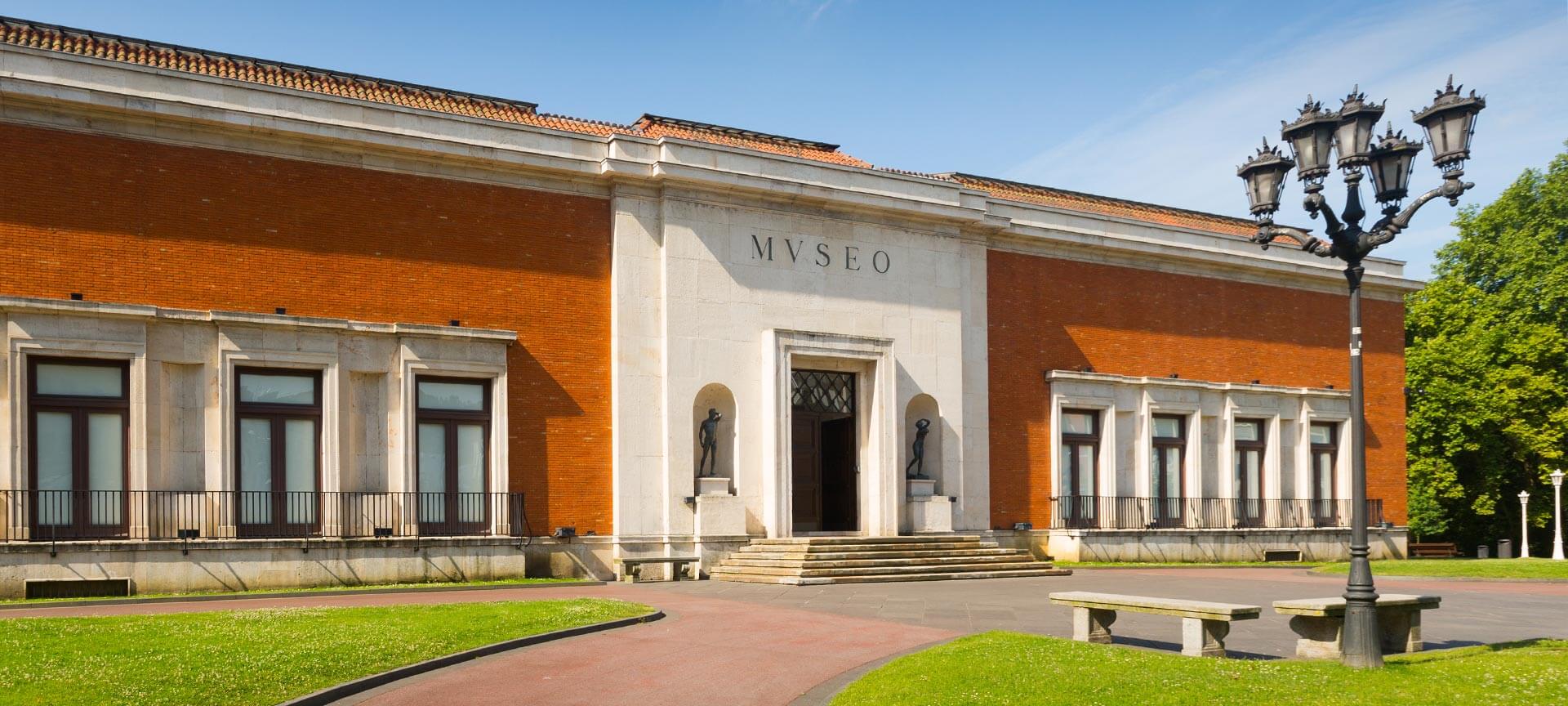
Bilbao Museum of Fine Arts
The Museum of Fine Arts takes a journey through the general…
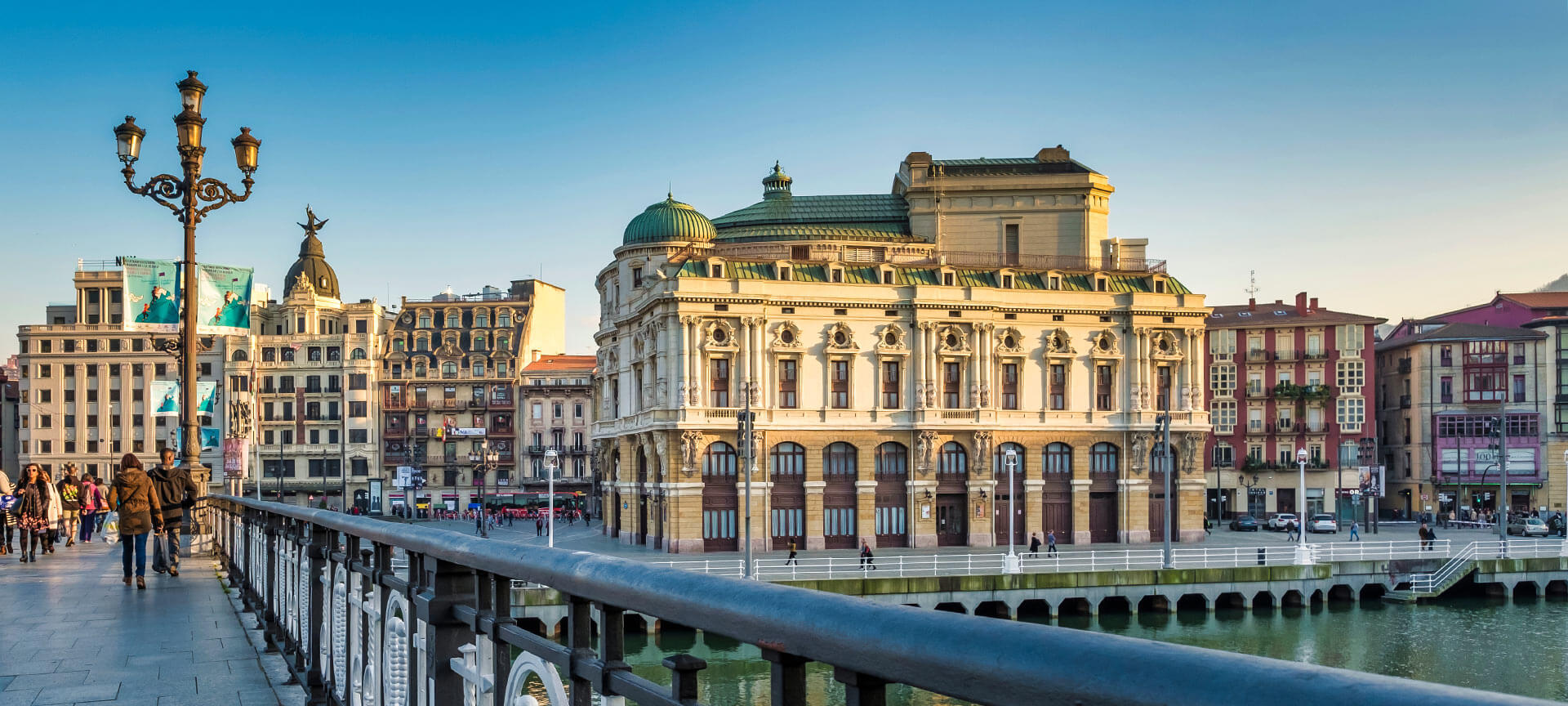
Arriaga Theatre
The Arriaga theatre is one of the most important buildings in the…
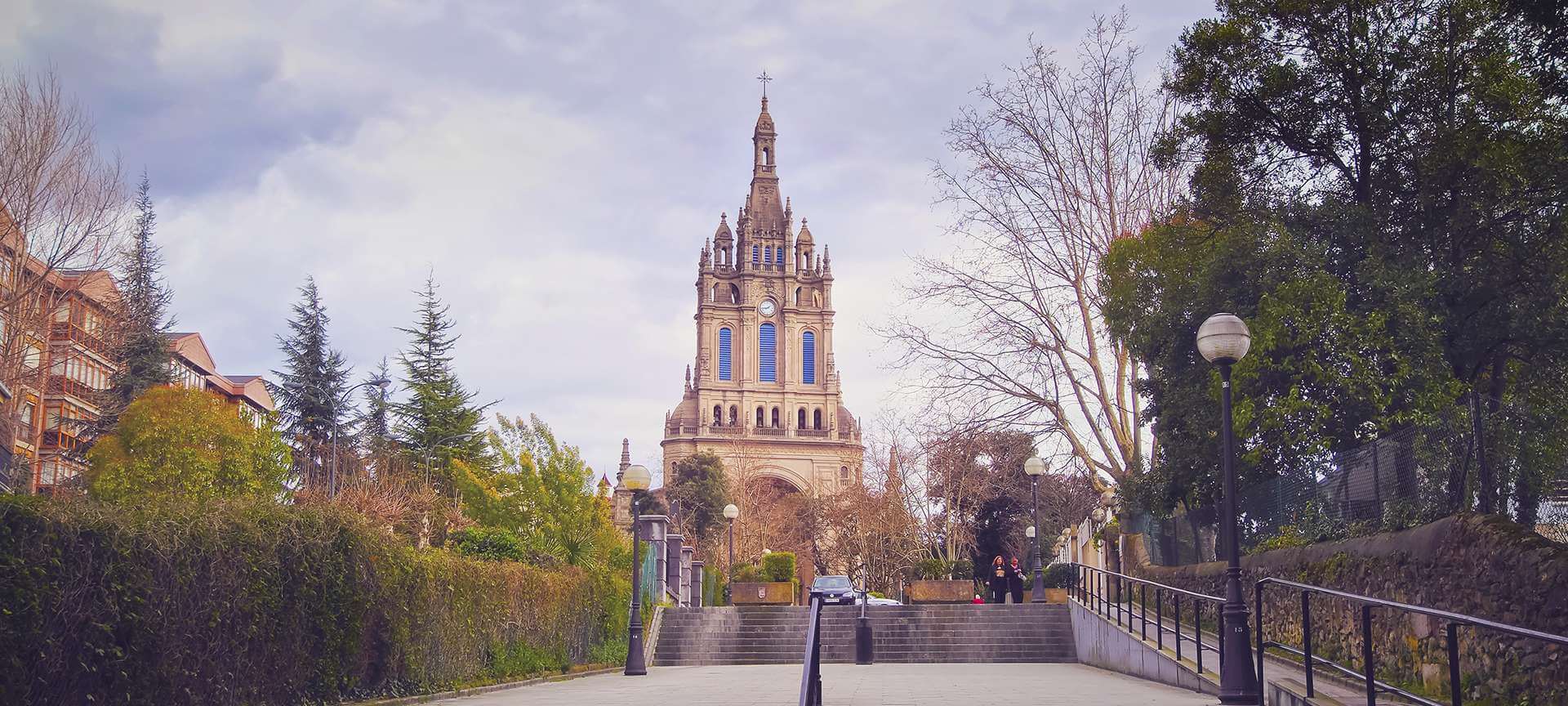
Begoña Basilica
It is built on the site of an old shrine where, legend has it,…
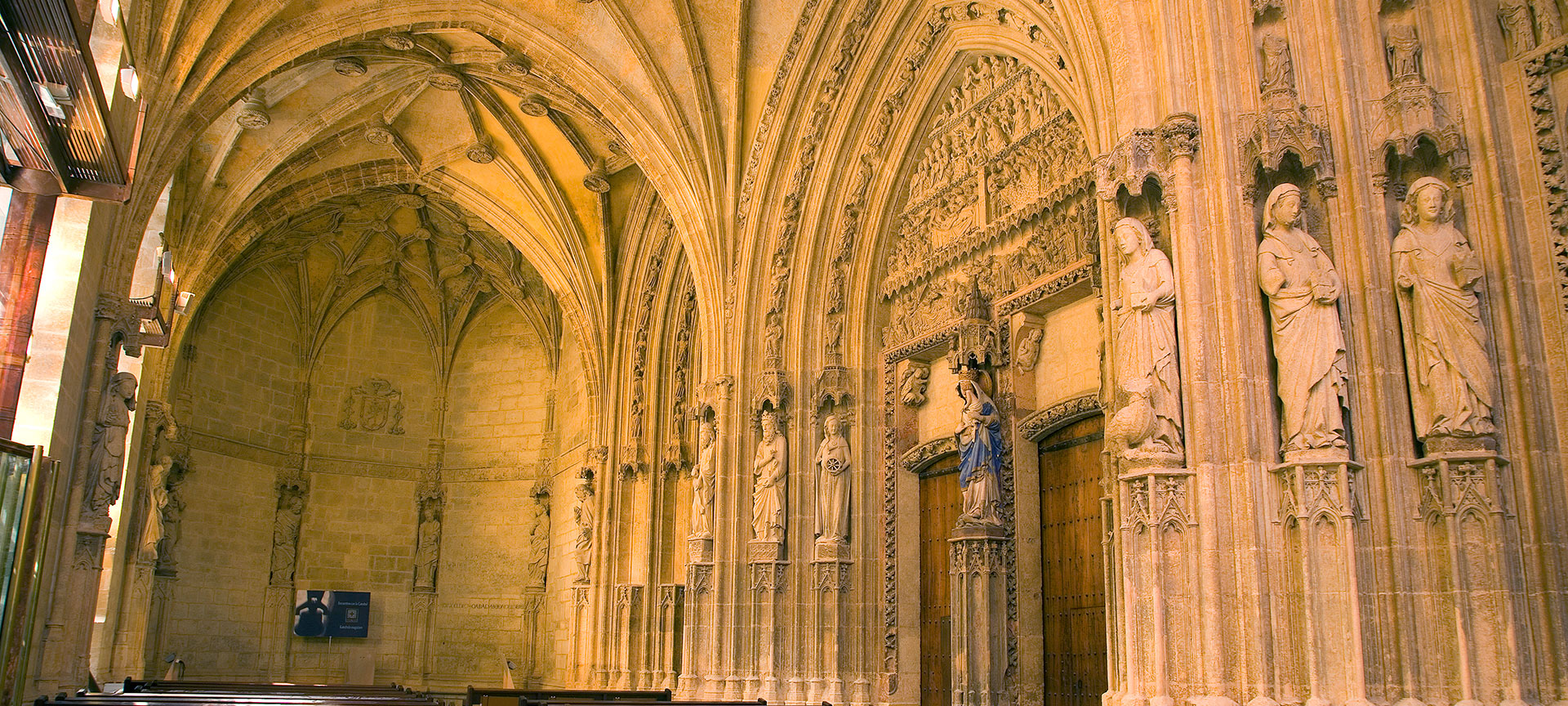
Cathedral of Santa María
It is built on a previous construction dating from the 13th…
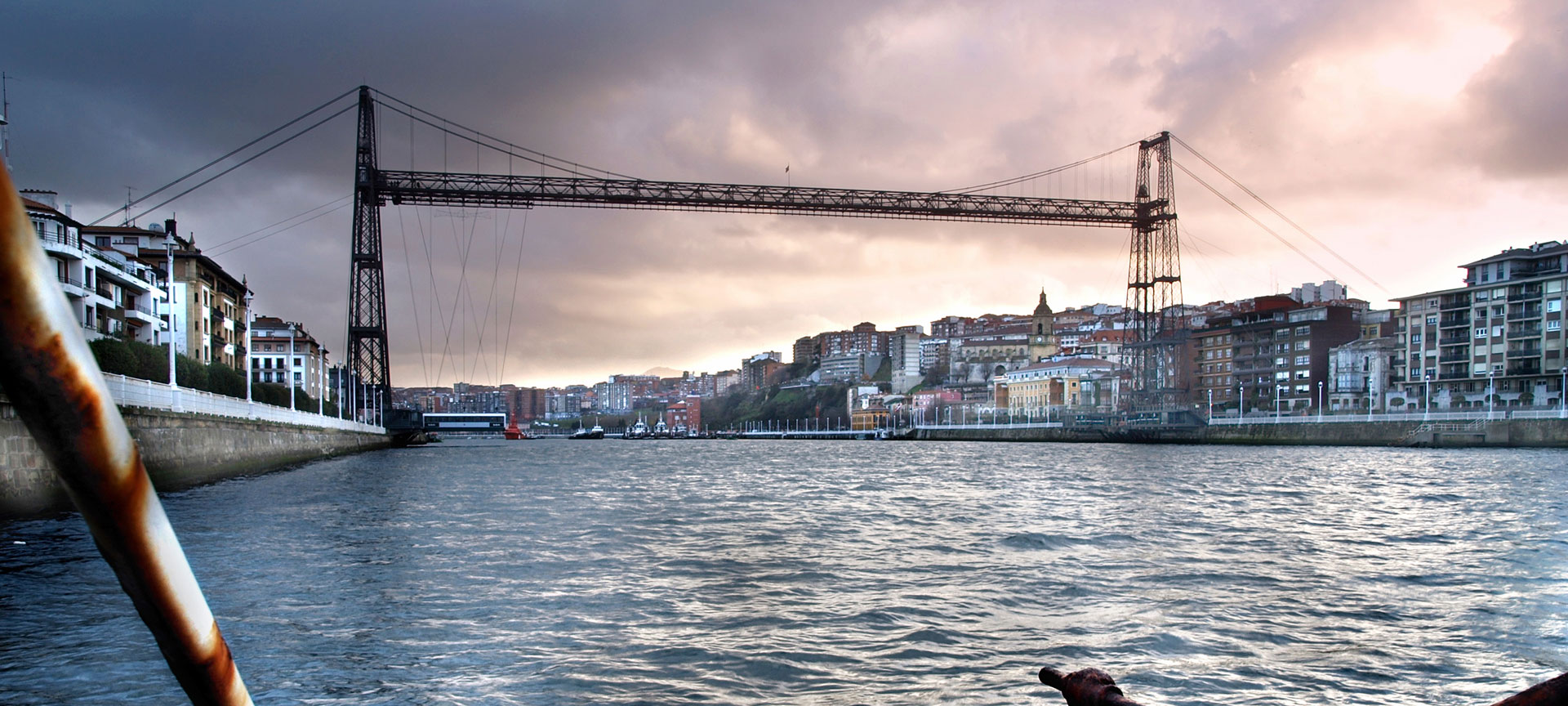
Vizcaya transporter bridge
Puente de Vizcaya, very close to Bilbao, is the world's oldest…
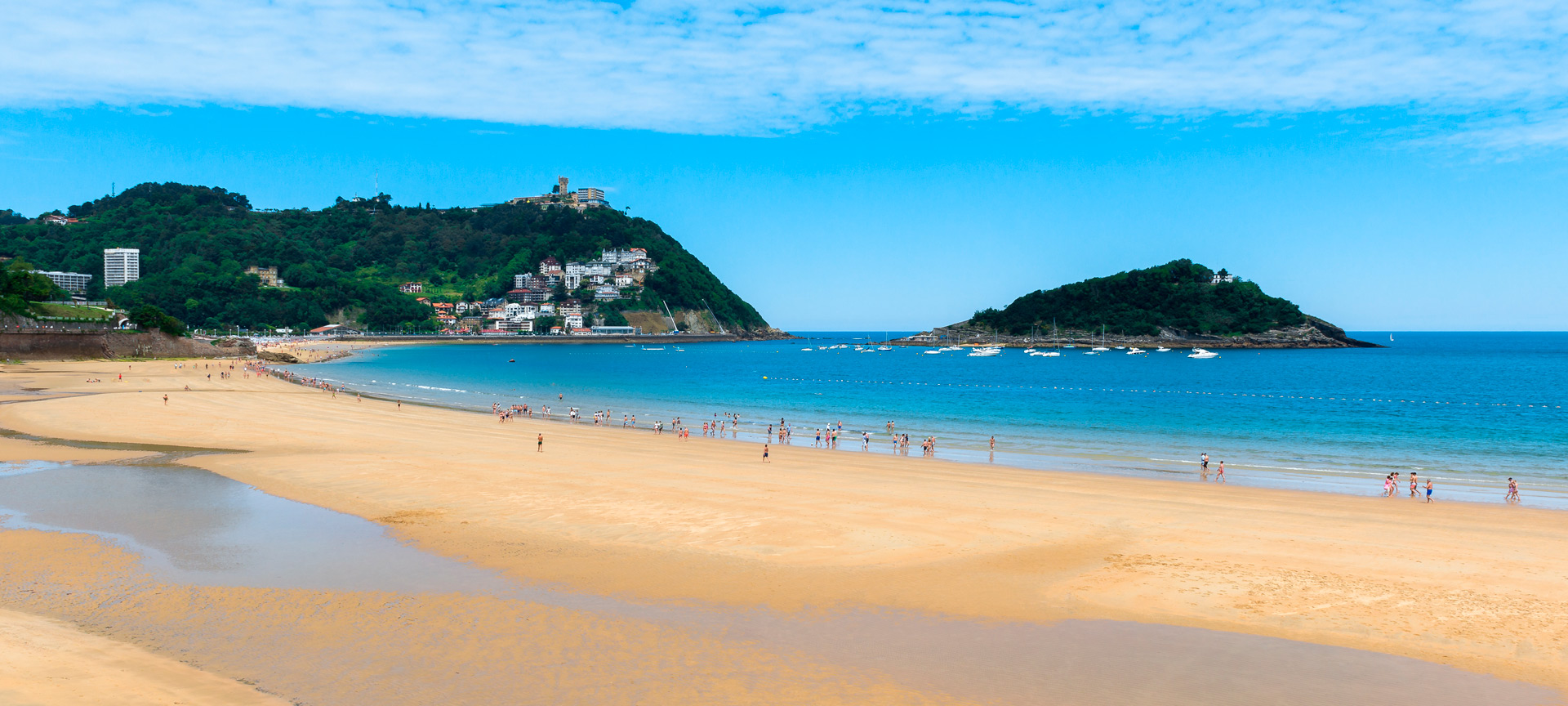
Beach: La Concha (Donostia-San Sebastián)
This beach with fine golden sand is located in the bay of La…
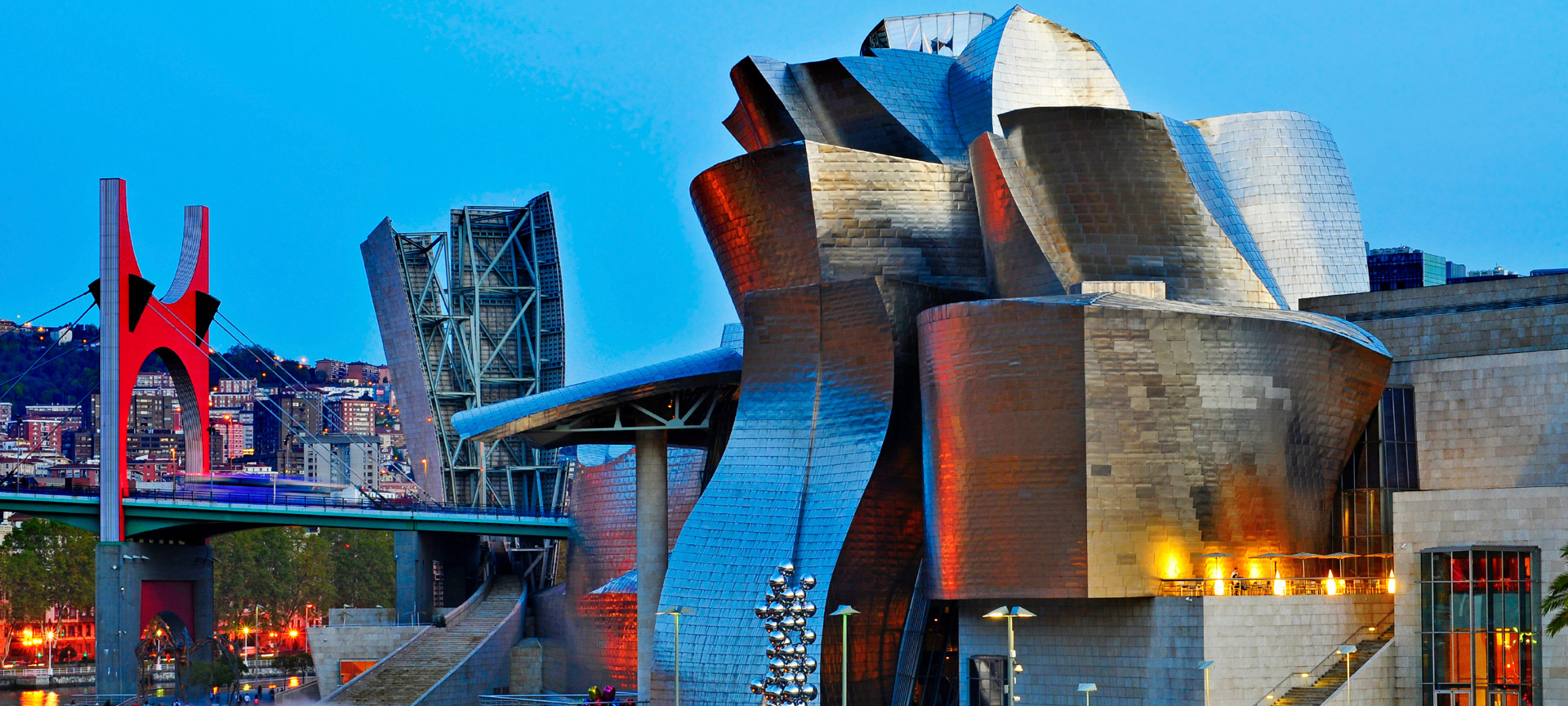
Guggenheim Museum Bilbao
This avant-garde building designed by Canadian-born Frank O.…
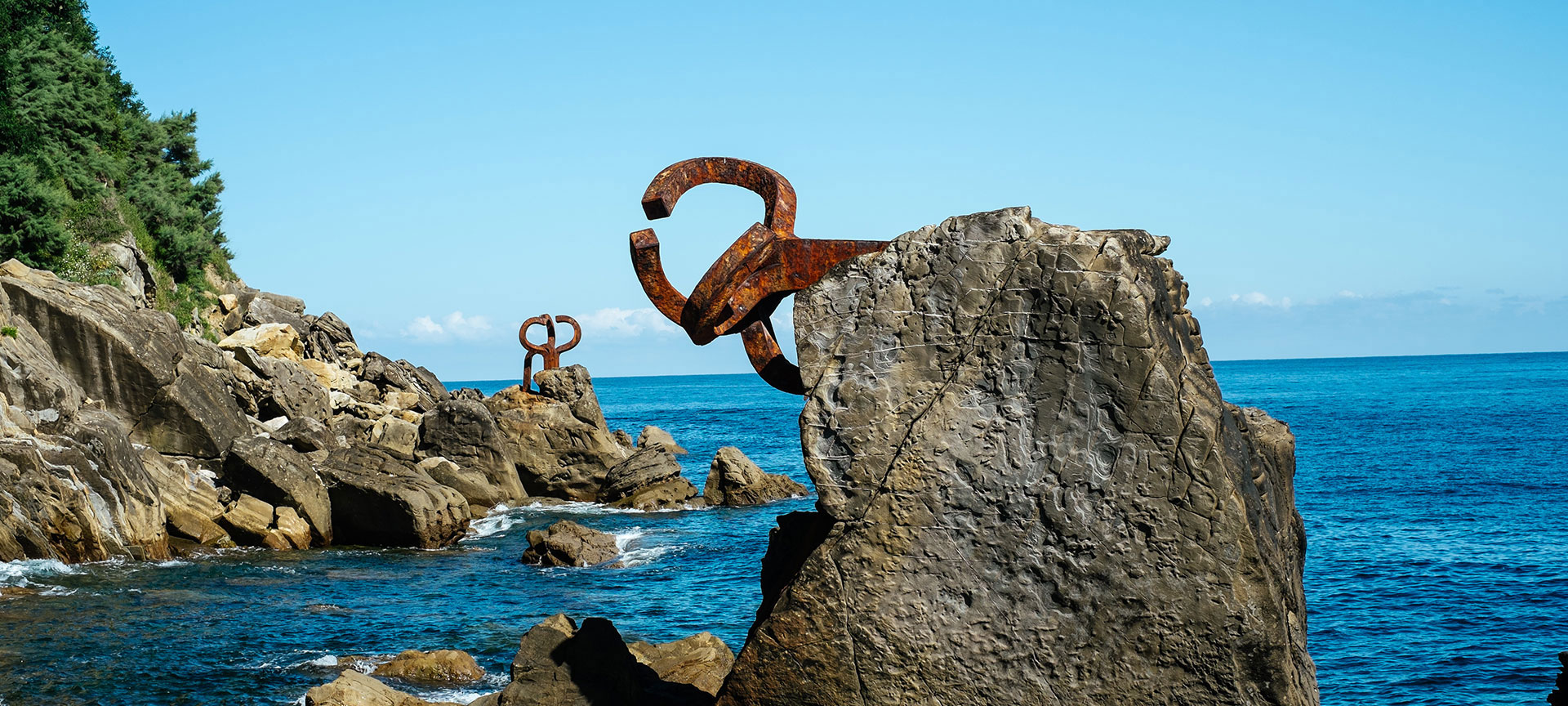
“Peine del Viento” sculpture
This is one of the best-known works by the sculptor Eduardo…
Other ideas for your trip
A week in Green Spain
We suggest a route from east to west covering the four regions that make up this part of Green Spain: the Basque Country, Cantabria, Asturias and Galicia.…
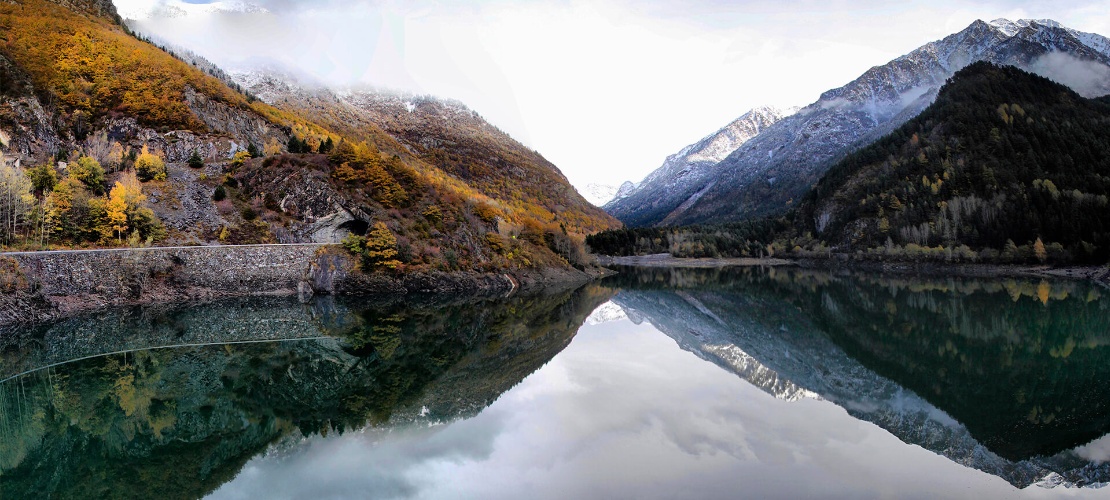
5 must-visit secret corners of the big cities of The Basque Country
Located in the north of Spain, this is one of the oldest autonomous regions, dating back thousands of years, with little known about its origins.…
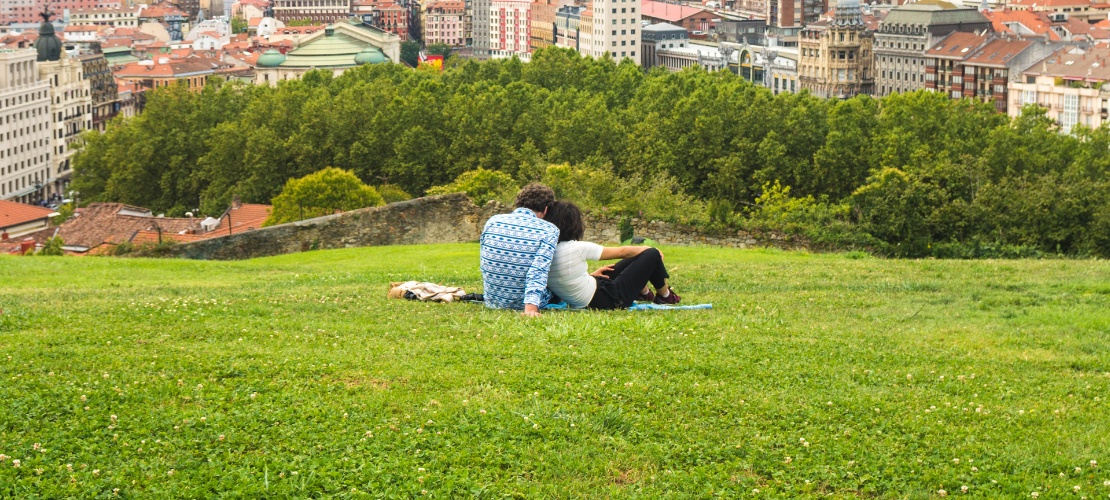
The Basque Country has all the green you need to reconnect with nature
Green forests, high cliffs, impossible rock formations and a large number of natural sites await you in the Basque Country.…
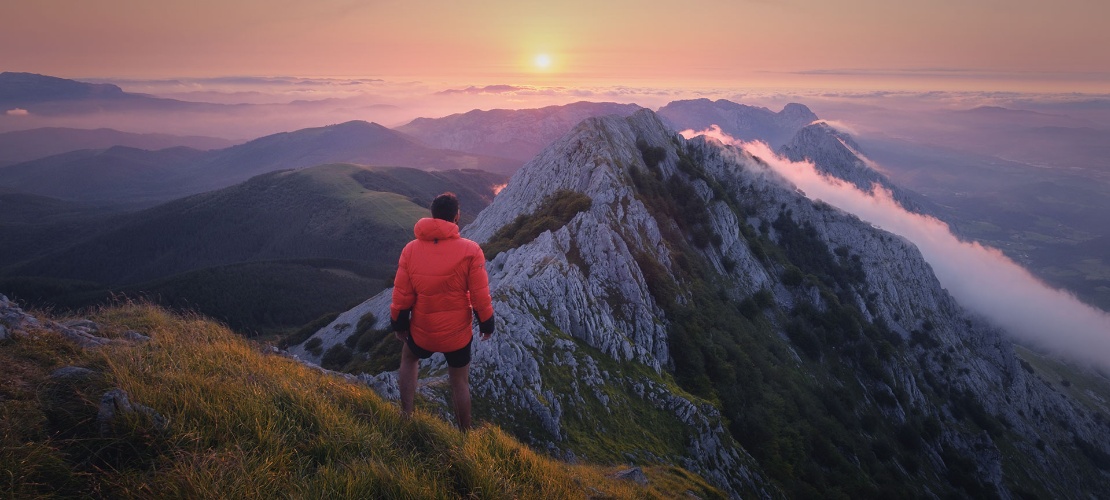
Enjoy nature: a holiday in a country cottage in the Basque Country
Our recommendation for today: give your eyes a treat. Leave the grey of the city behind and treat your eyes to the colour of serenity: green.…
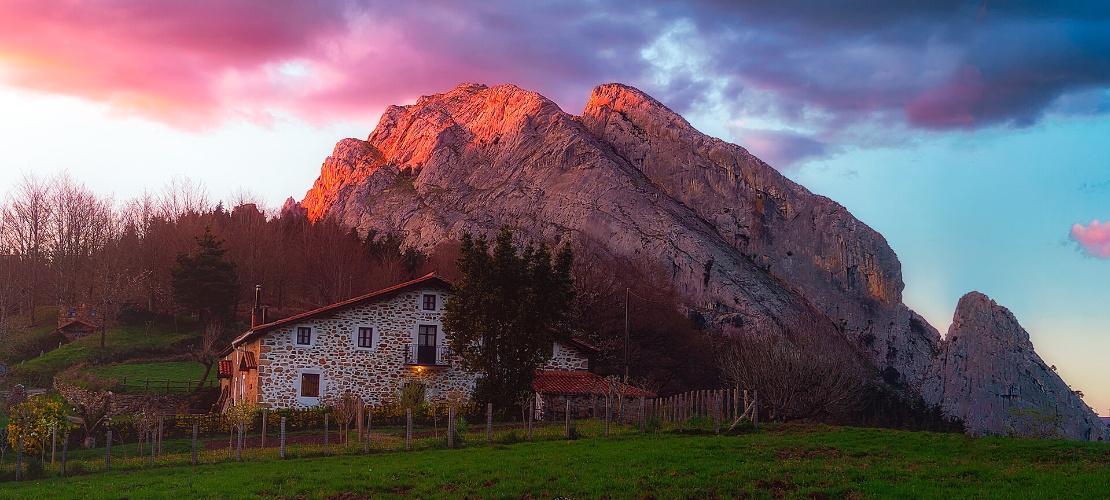
Located in the north of Spain, this is one of the oldest…
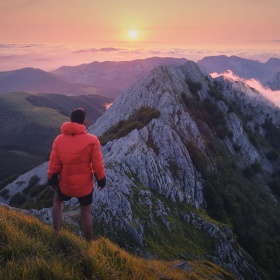
Green forests, high cliffs, impossible rock formations and a…
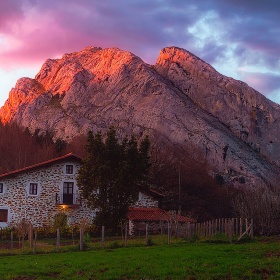
Our recommendation for today: give your eyes a treat.…
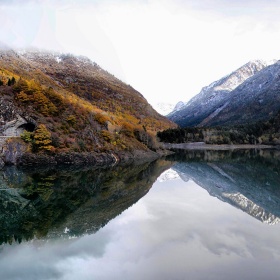
We suggest a route from east to west covering the four regions…

Choose between thousands of activities to live your best life on holiday.

- The Top 10 Things To...
Top Things To Do And See In The Basque Country

The Basque Country has much to offer. Explore beaches and cuisine, see spectacular views and visit museums in the area for never-ending fun.

1. The Guggenheim Museum
Building, Museum

2. San Sebastian-Donotia's beaches
San sebastian-donotia’s beaches.
San Sebastian-Donostia’s Concha Bay is an iconic part of a trip to this Basque city. Its most celebrated beach is La Concha, which is praised for its breathtaking landscape and is considered to be one of the most beautiful beaches in Europe . The spectacular bay sees many tourists, particularly during the summer, offering its visitors four luxurious beaches: La Concha, Ondarreta, Zurriola and Isla Santa Clara’s beach. Sun-bathing, volleyball, surfing and relaxing in a beach bar are only a few of the activities possible in Concha Bay.
Playa de la Concha, San Sebastia-Donostia, Spain

3. La Bretxa
Markets are popular in the Basque Country, where food and especially seafood is an integral part of Basque culture. To find the best of Basque seafood however, there is no better place to look than in La Bretxa in San Sebastian-Donostia, a market in which vendors consider the freshness and quality of the products to be of the utmost importance. The sea-products sold here, such as hake, eels and even barnacles, are all caught in nearby ports and are therefore seasonally sold.
La Bretxa, Boulevard Zumardia, 3, San Sebastian – Donostia, Spain
4. Saint Mary’s Cathedral and Cloister Bayonne
Building, Cathedral
Saint Mary’s Cathedral and Cloister Bayonne
Vittoria-Gastéiz, the quiet capital of the Basque Country, is home to a stunning cathedral built in the 13th and 14th century – the Cathedral of Santa María . Although this cathedral, which is a UNESCO World Heritage Site, is undergoing restoration work, it is still open to the public and professional tours are given round the building. These tours invite tourists to explore the history of Vitoria-Gasteiz, plunging into an exciting recount of the history of this Gothic cathedral.
Saint Mary’s Cathedral, Calle Cuchillería, 95, Vitoria-Gasteiz, Araba, Spain, +34 945 12 21 60

5. Sainte-Marie Cathédrale
Sainte-marie cathédrale.
Bayonne has its own beautiful Catedral Sainte-Marie , which was built in a gothic style using only white and red stone sourced nearby. This architectural beauty holds relics of St Léon, one of Bayonne’s Bishops from the 9th Century. Located at the heart of the historic centre and overlooking the Adour and Nive rivers, this World Heritage Site alongside the adjacent cloister is a must-see attraction when in Bayonne, for it is rich in history and artistic skill.
Sainte-Marie Cathédrale, 15 Rue des Prébendes, Bayonne, France

6. Musée Basque
Musée basque.
The Museé Basque , a splendid museum which has been open for almost a century, contains a wonderful exhibit of the history of Bayonne and the Basque Country. The collection of over 2,000 objects of historical interest is located inside a building typical of 18th century Bayonne and counts as the largest ethnographic museum in the whole of the Basque Country. Visit this museum to learn about the identity, traditions and roots of the Basque culture and its people.
Musée Basque, 37 Quai des Corsaires, Bayonne, France, +33 5 59 59 08 98

7. San Juan de Gaztelugatxe
San juan de gaztelugatxe.
San Juan de Gaztelugatxe is a breathtaking island in the Gulf of Gascony and is connected with the mainland by a stone bridge. 231 zigzagging steps lead to the summit of a small mound, where there is a little chapel dedicated to Saint John the Baptist. Take this magical walk of adventure in a luxurious island with magnificent views to enjoy the Basque landscape and come closer to nature. At the chapel don’t forget to ring the bell three times and make a wish.
San Juan de Gaztelugatxe, Biscay, Spain

8. Plaza Nueva
Plaza nueva.
La Plaza Nueva, located in the historic center of Bilbao , is an excellent example of the neo-classical influence in the city. Having replaced the plaza vieja (old square) and thus earning its name as the new square, La Plaza Nueva boasts arcade buildings and arches through which the square can be accessed. Nowadays, the square is frequently used for public events, such as folk demonstrations or festivals, and on Sundays a flea market selling old books, coins, stamps and other collectors’ items can be found. Many restaurants and taverns reside here, so look out for the traditional Basque pintxos .
Plaza Nueva, 9, Bilbao, Viscaya, Spain

Le Grand Stroll
A spectacular location for a coastline walk is Biarritz. The route starts at a lighthouse on a headland, and passes many other attractions. France’s second-oldest golf course, for example, is along the route, so perhaps book in for a game. If not, carry on to the glorious Russian Orthodox Church which was originally built for visiting nobility in the 19th century to see the magnificent dome. Other landmarks along the route are the Casino Barrière, Place Ste-Eugenie, the Museum of the Sea, Fishermen’s Port (built by Napoleon) and the Rock of the Virgin.

9. Train de la Rhune
Train de la rhune.
If you are looking for a magical experience, don’t miss out on the Train of the Rhune . This charming little train dates back to 1924, climbs up to a summit 905 meters high, offering breathtaking views of the Pyrenees and the French and Spanish coastlines. A 35-minute trip to the top through the wild takes you past Pottok ponies, ponies which are unique to the Basque Country and which live in complete freedom, manech sheep, also originating in the Basque Country, and wild vultures.
Train de la Rhune, Col de Saint-Ignace, Sare, France, + 33 559 542 026

Since you are here, we would like to share our vision for the future of travel - and the direction Culture Trip is moving in.
Culture Trip launched in 2011 with a simple yet passionate mission: to inspire people to go beyond their boundaries and experience what makes a place, its people and its culture special and meaningful — and this is still in our DNA today. We are proud that, for more than a decade, millions like you have trusted our award-winning recommendations by people who deeply understand what makes certain places and communities so special.
Increasingly we believe the world needs more meaningful, real-life connections between curious travellers keen to explore the world in a more responsible way. That is why we have intensively curated a collection of premium small-group trips as an invitation to meet and connect with new, like-minded people for once-in-a-lifetime experiences in three categories: Culture Trips, Rail Trips and Private Trips. Our Trips are suitable for both solo travelers, couples and friends who want to explore the world together.
Culture Trips are deeply immersive 5 to 16 days itineraries, that combine authentic local experiences, exciting activities and 4-5* accommodation to look forward to at the end of each day. Our Rail Trips are our most planet-friendly itineraries that invite you to take the scenic route, relax whilst getting under the skin of a destination. Our Private Trips are fully tailored itineraries, curated by our Travel Experts specifically for you, your friends or your family.
We know that many of you worry about the environmental impact of travel and are looking for ways of expanding horizons in ways that do minimal harm - and may even bring benefits. We are committed to go as far as possible in curating our trips with care for the planet. That is why all of our trips are flightless in destination, fully carbon offset - and we have ambitious plans to be net zero in the very near future.

Guides & Tips
The top 6 hiking trails in the basque country.

Bars & Cafes
The 10 best bars in the basque country.


The Most Beautiful Beaches in the Basque Country
Culture trip spring sale, save up to $1,100 on our unique small-group trips limited spots..

- Post ID: 393111
- Sponsored? No
- View Payload
19 Absolute Best Things to Do in San Sebastián | Spain’s Basque Country
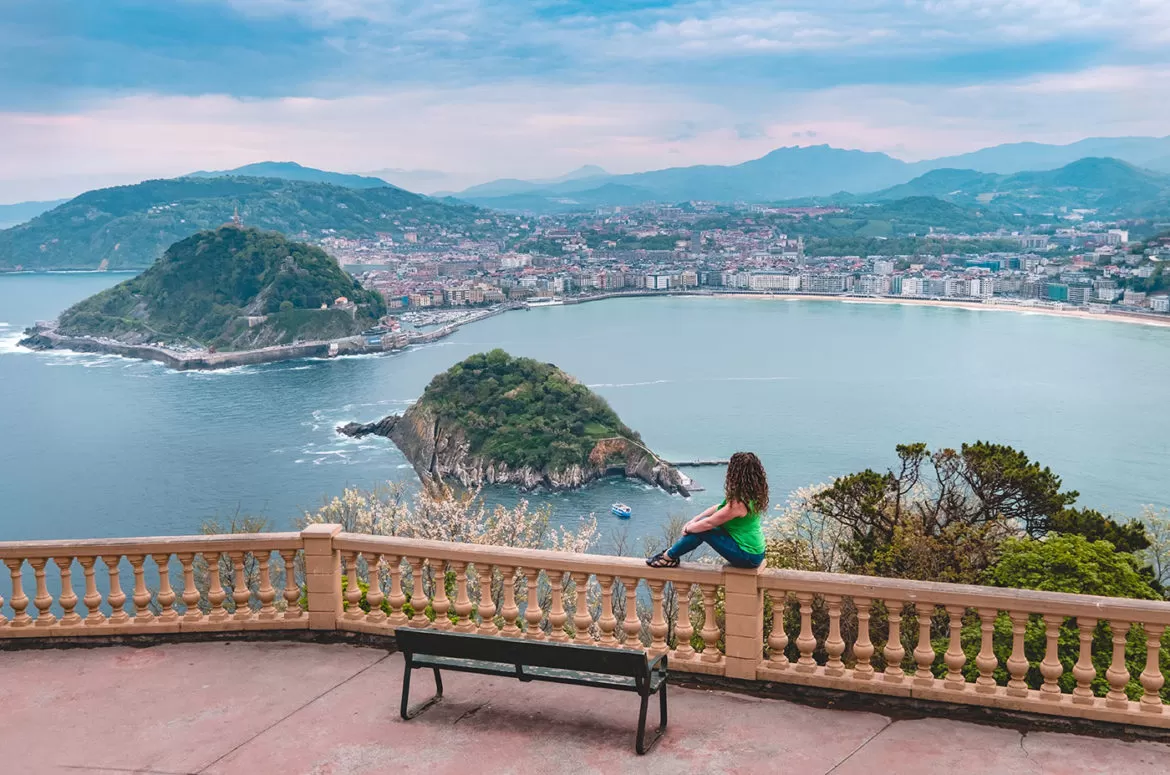
San Sebastián is the Basque country’s culinary capital. If you’re a foodie, then this is your paradise. Did you know, Spain’s Basque Country boasts the highest concentration of Michelin-starred restaurants in the world? Having a meal here is just one of many top things to do in San Sebastián .
San Sebastián’s appeal stretches beyond its plates of pintxos . Overlooking the crescent-shaped Bay of Concha, San Sebastián is located on Spain’s northern coastline set amongst scenic mountains making it an impossibly charming city. After spending 5 days exploring, relaxing, and eating my way through San Sebastián I’ve come up with the ultimate list of the best things to do in the San Sebastián.
Going to the Basque Country? Enrich your travels with my free Basque travel phrase guide plus audio. I also have a Spanish phrase guide too!
San Sebastián & Donostia – The City with Two Names
San Sebastián actually has two names – San Sebastián is its Spanish name and Donostia is its name in the local Basque language called Euskara. While they look completely different, that both mean “Saint Sebastián”. In the Basque language, dona/done/doni means “saint” and is derived from Latin word domine. The second part, -stia contains a shortened form of the saint’s name.
Map of Things to do in San Sebastián, Spain
Want to know where you’ll be going? Take a look at the detailed map below.
Tip: For a larger view of the map, click on the icon in the top right corner.
Click on this interactive map and see where this itinerary will take you. I’ve created this map using Google Maps which you can save and use as you visit San Sebastián.
The coloured pins represent different pockets of the town to explore each day. Click on any pin for more information. Things to do – Yellow pins Where to eat – Pink pins Where to stay – Green pins
Here are the Best things to do in San Sebastián
1. stroll along the seaside at la concha promenade.
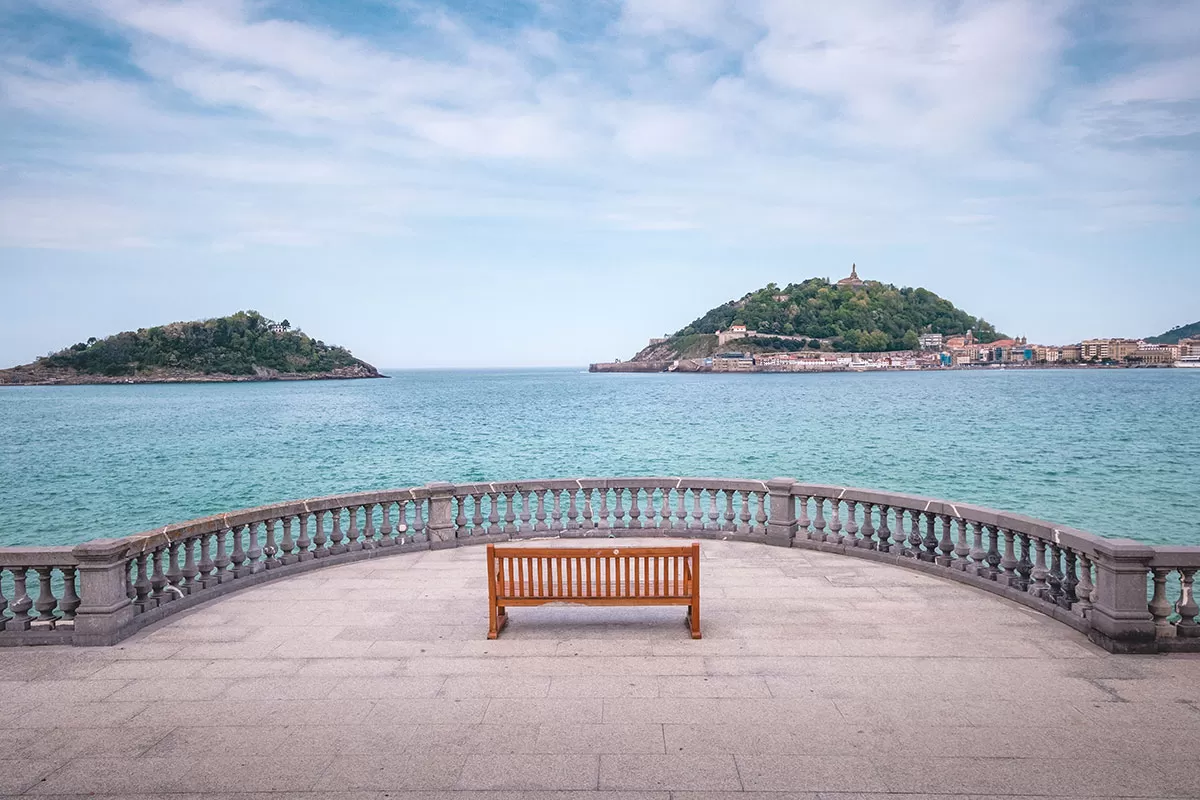
Essential information
Address – Kontxa Pasealekua, 20007 Donostia, Gipuzkoa, Spain Admission – Free Opening hours – 24 hours. Sunrise and Sunset are especially magic. Reviews – Read Tripadvisor reviews of La Concha Promenade
2. See the Peine del Viento sculptures
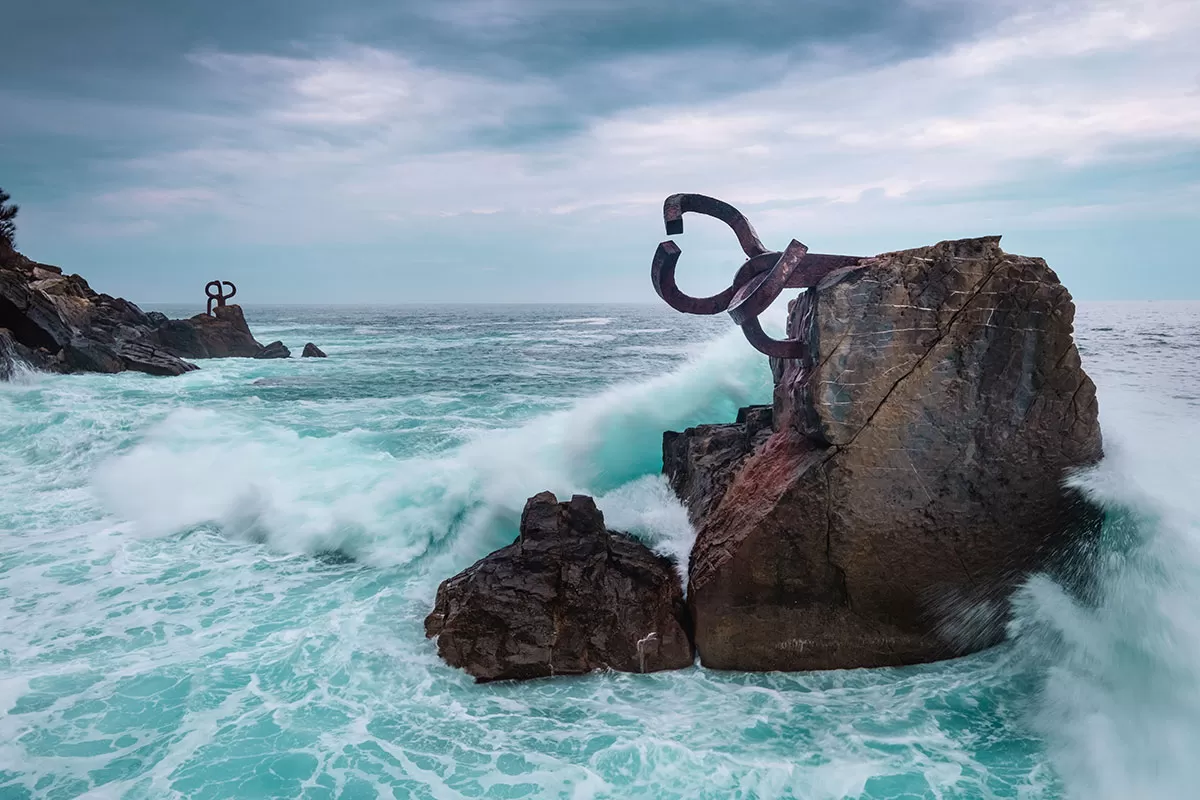
Completed in 1976, the sculptural group is made up of three curved steel sculptures that are welded into huge granite rocks located in direct contact with the sea. Strong winds and huge sea waves crash upon this area with great intensity and through a system of holes in the ground waves explode into the air in high columns. This place is even more spectacular on stormy days or when there is a heavy swell.
Peine del Viento gets its name from the combination of the shape of a twisted comb (peine) seen in the sculptures, along with the characteristic wind (viento) in the area.
Address – Eduardo Chillida Pasealekua, s/n, 20008 Donostia, Gipuzkoa, Spain Admission – Free Opening hours – 24 hours Reviews – Read Tripadvisor reviews of Peine del Viento
3. Explore the Old Town (Parte Vieja)
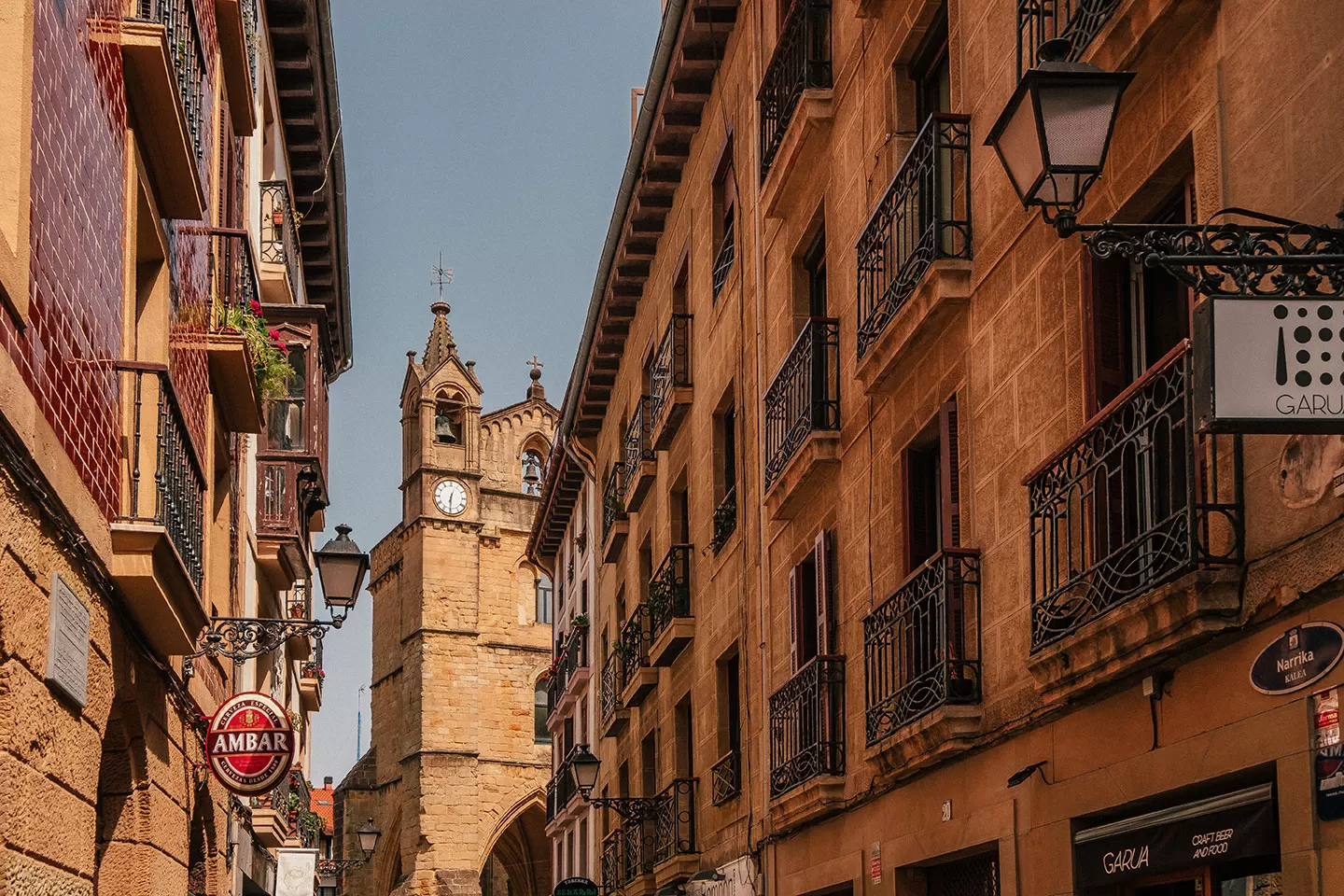
San Sebastián’s Old Town dates back to medieval times but much of it was rebuilt after a fire devastated the city in 1813. Highlights include the Municipal Museum San Telmo, the Gothic church of St. Vincente, the Baroque basilica of Santa María del Coro, and the stunning Plaza de la Constitución with its arcades and balconies. To learn more about San Sebastián’s history, join a guided walking tour of the Parte Vieja or a pintxos tour.
The Parte Vieja takes on a whole new atmosphere as patrons spill out onto the streets around lunch and dinner times to enjoy an endless variety of tantalizing pintxos. Pintxos is the Basque Country’s answer to the Spanish tapas. Local specialities include deep-fried cod, marinated anchovies, handmade croquettes, and of course tortilla de patatas (potato omelette). Tips on where to eat in San Sebastián coming up shortly!
Address – Start at Calle Mayor and walk to the end to see Basílica de Santa María del Coro before taking any side street. Admission – Free Opening hours – Times vary per establishment, with most places closed on Mondays and during siesta hours (14:00 until 17:00 for shops and 14:00 until about 20:00 or 21:00 for bars and restaurants). Reviews – Read Tripadvisor reviews of San Sebastián’s Parte Vieja
4. See the bullet holes in San Sebastián’s City Hall
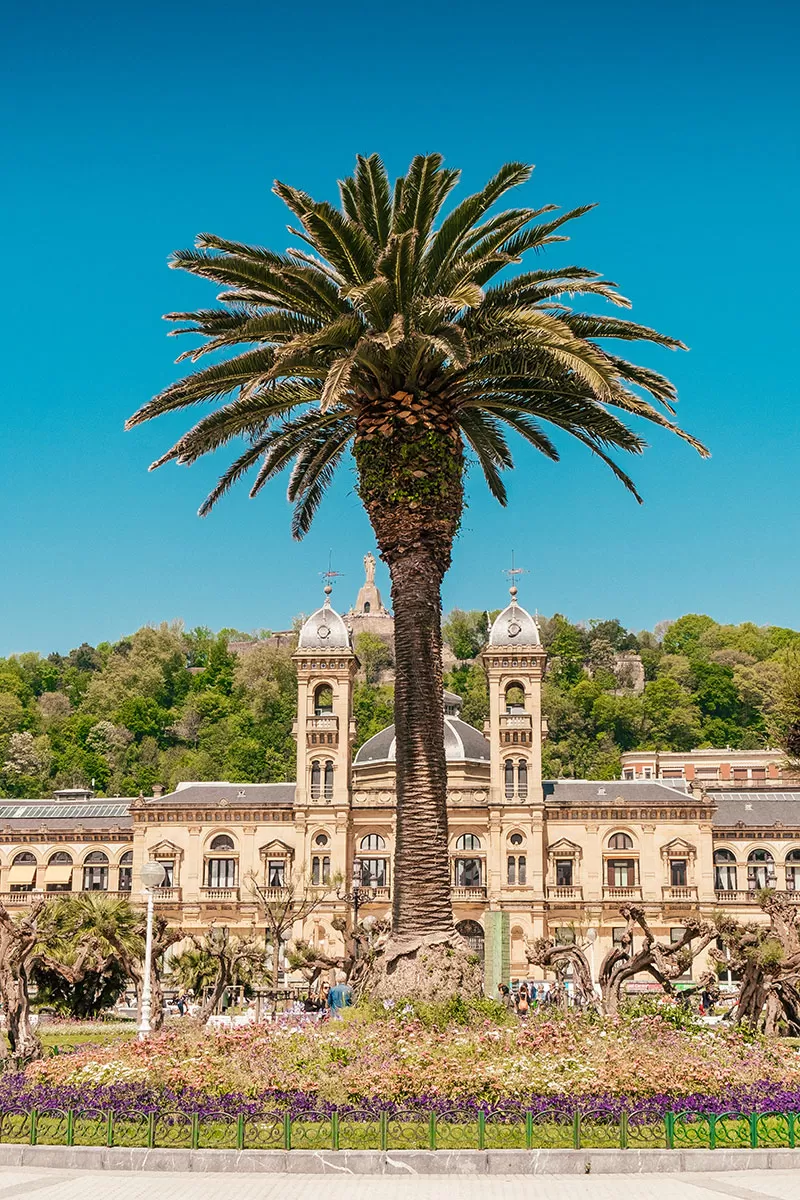
If you looking closely you can still see bullet holes on the facade of the building as a result of the fighting that took place here during the Spanish Civil War (1936 to 1939) between the nationalists and republicans.
It wasn’t until 1947 that the City Council moved its headquarters here from the Plaza de la Constitución. Today, San Sebastián’s City Hall faces the quiet Alderdi Eder gardens, an essential stopping point for those looking to relax after wandering along the promenade.
Address – Ijentea Kalea, 1, 20003 Donostia, Gipuzkoa, Spain Admission – Free Opening hours – Monday – Friday 09:00 – 14:00 Reviews – Read Tripadvisor reviews of San Sebastián’s City Hall
5. Wander the arcades of Plaza de la Constitución
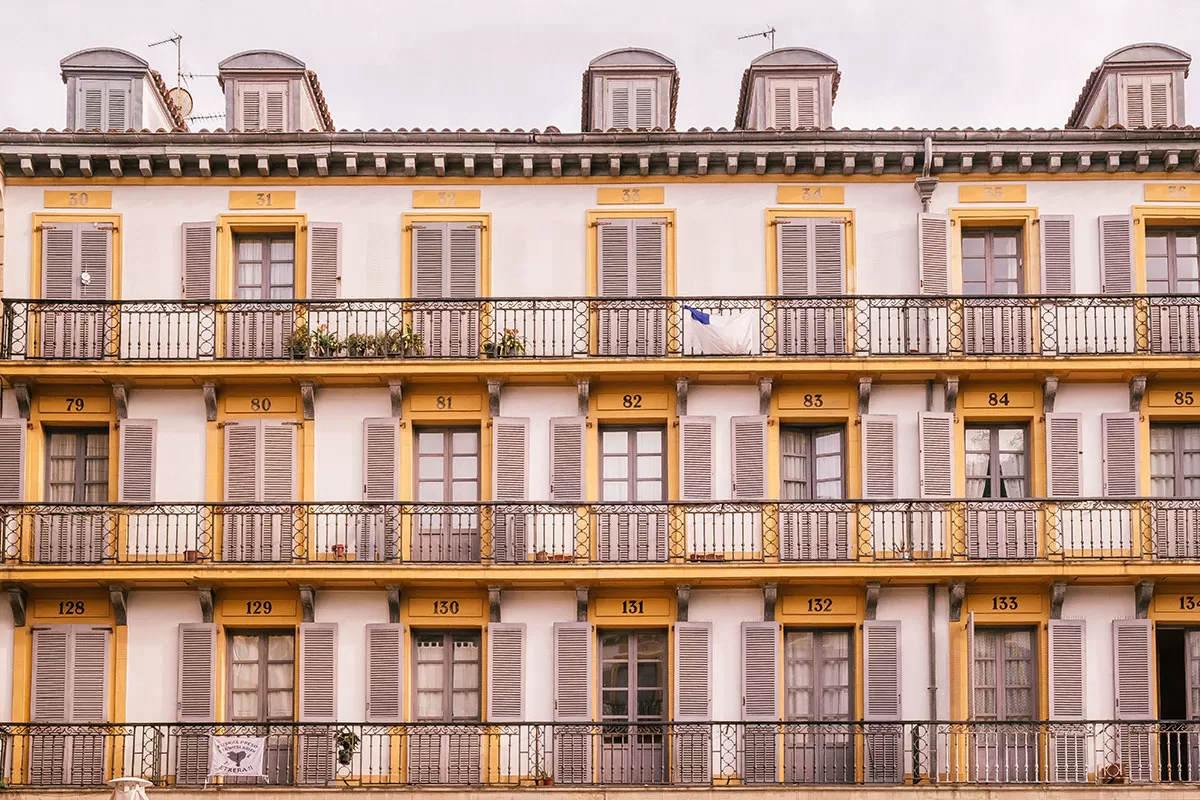
Address – Plaza Constitución, 12, 20003 San Sebastián, Guipúzcoa, Spain Admission – Free Opening hours – Bars and restaurants have varying opening times between 10:00 – 03:00. Reviews – Read Tripadvisor reviews of Plaza de la Constitución
6. Visit the stunning Basílica de Santa María del Coro
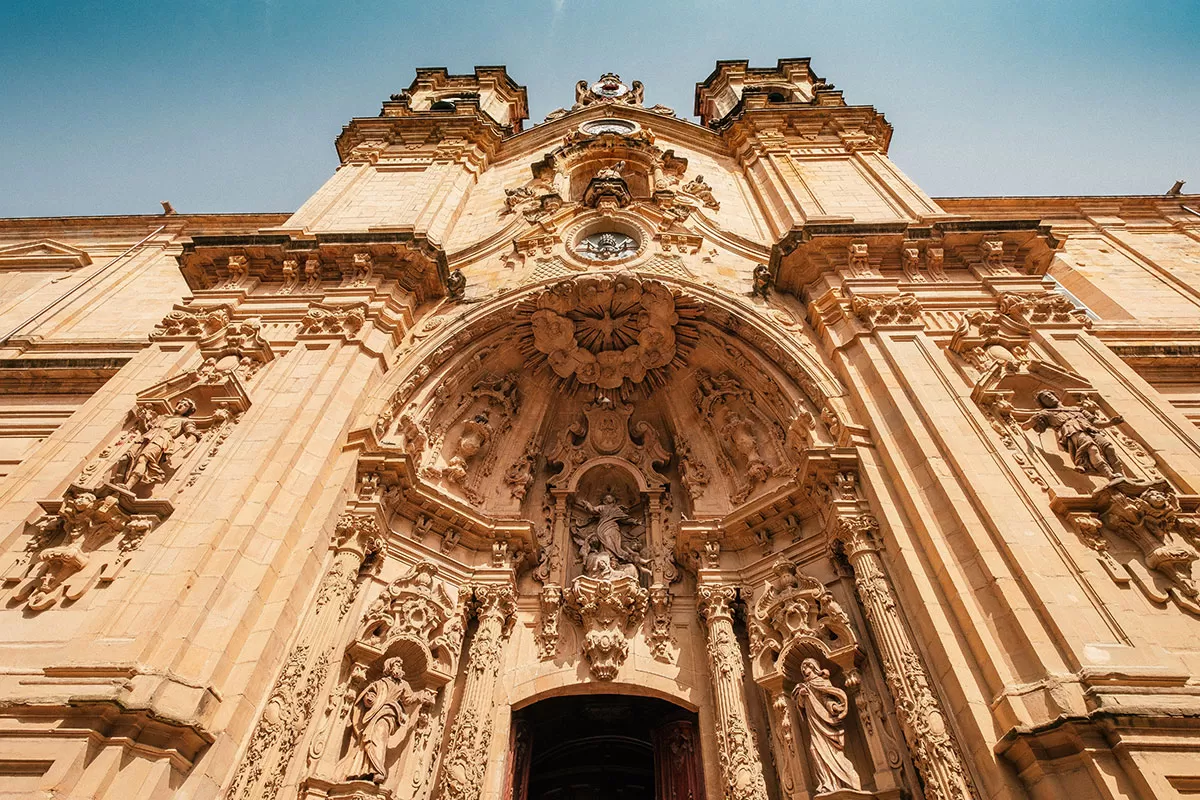
Address – 31 de Agosto Kalea, 46, 20003 Donostia, Gipuzkoa, Spain Admission – Free Opening hours – Monday to Sunday from 10:15 to 13:15 and from 14:45 to 19:45. Reviews – Read Tripadvisor reviews of Basílica de Santa María del Coro
7. Relax on Playa de la Concha
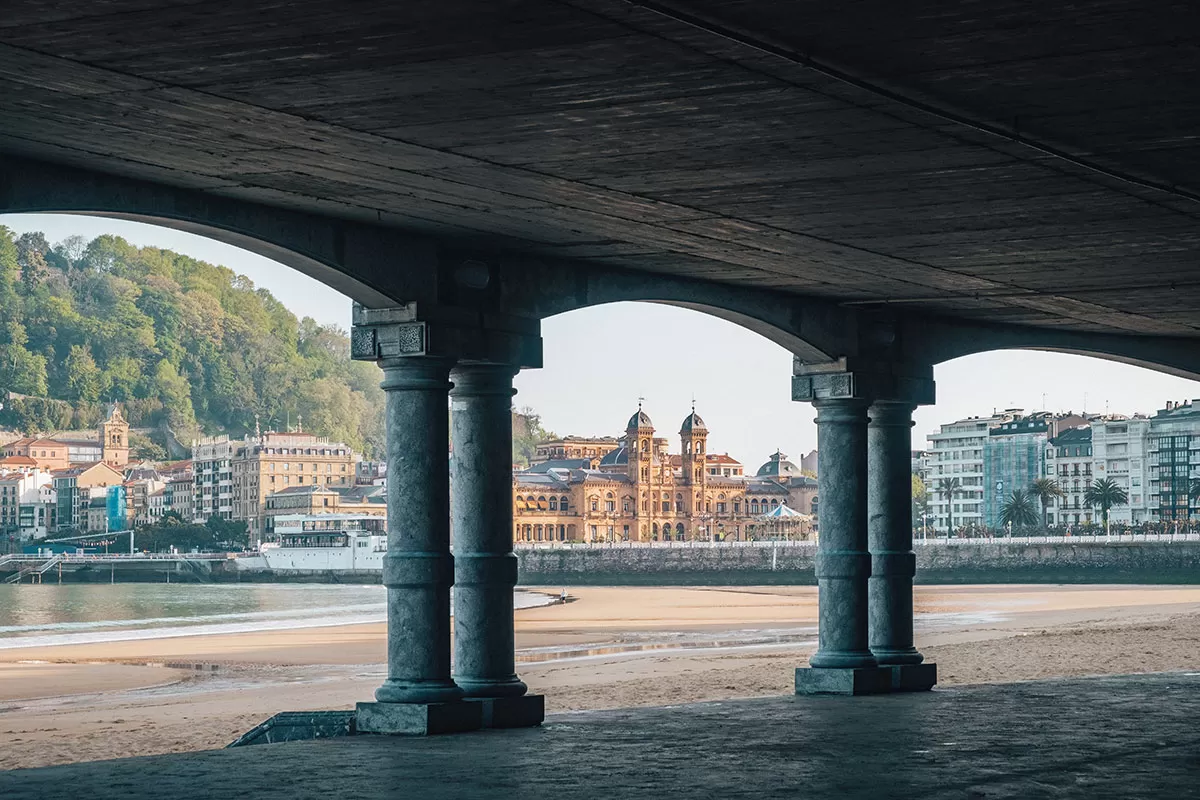
Address – 20007, Gipuzkoa, Spain Admission – Free Opening hours – 24hrs Reviews – Read Tripadvisor reviews of Playa de la Concha
8. Take the Funicular up to Monte Igueldo for Exceptional Panoramic Views
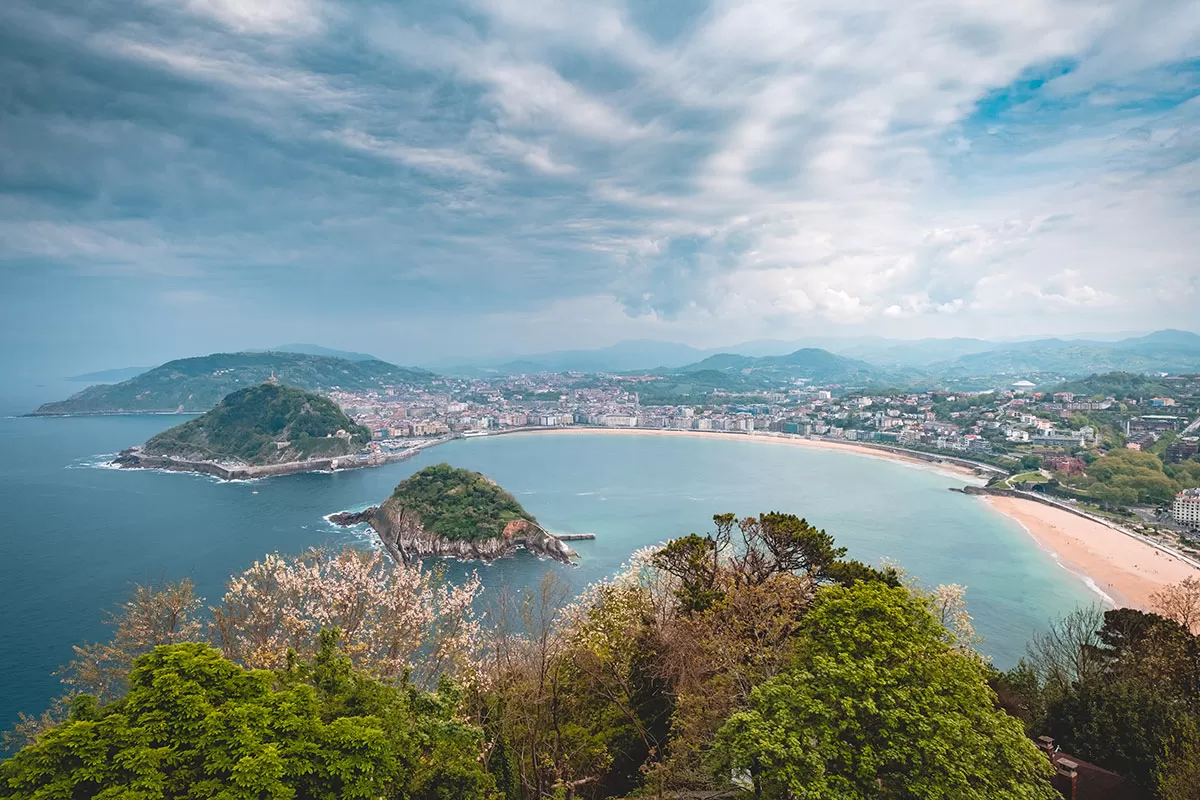
Those with a family in tow can have a fun day out at the Parque de Atracciones de Monte Igueldo amusement park located here which features charming carousels and a traditional wooden roller coaster.
You’ll be happy to know that all rides are reasonably priced so you won’t break the bank. There are food stands and a restaurant with a balcony where you can enjoy your meal with a view.
If you’re looking for something more sophisticated, head to Hotel Mercure Monte Igueldo, for a drink on their outdoor terrace or dine in their elegant restaurant. Extend your stay and book a room in their hotel.
Not to be missed is the 16th-century El Torreón tower which you can climb for views of the lighthouse and the rolling hills of the Basque countryside to the west.
Unless you have a car and prefer to drive, the best way to reach the top is by taking the funicular.
Address The funicular is located at Funikular Plaza, 4, 20008 Donostia, Gipuzkoa, Spain at the far end of Playa de Ondarreta near the Royal Tennis Club.
Admission There are two ways you can arrive to Monte Igueldo
- By Funicular: Adults 3,75 € / Children 2,50 €
- By Car/foot 2,30 € per person
Attraction prices range between 1 € – 2,50 €
Opening hours
- Funicular 10:00-21:00 (every 15 minutes)
- Attractions 11:00-14:00 / 15:30-20:00 – Closed Monday-Friday
- Enclosure/lookout – 10:00-21:00
Reviews – Read Tripadvisor reviews of Monte Igueldo Official website – Plan your visit with the official Monte Igueldo website
9. Have a picnic at Miramar Royal Palace (Palacio de Miramar)
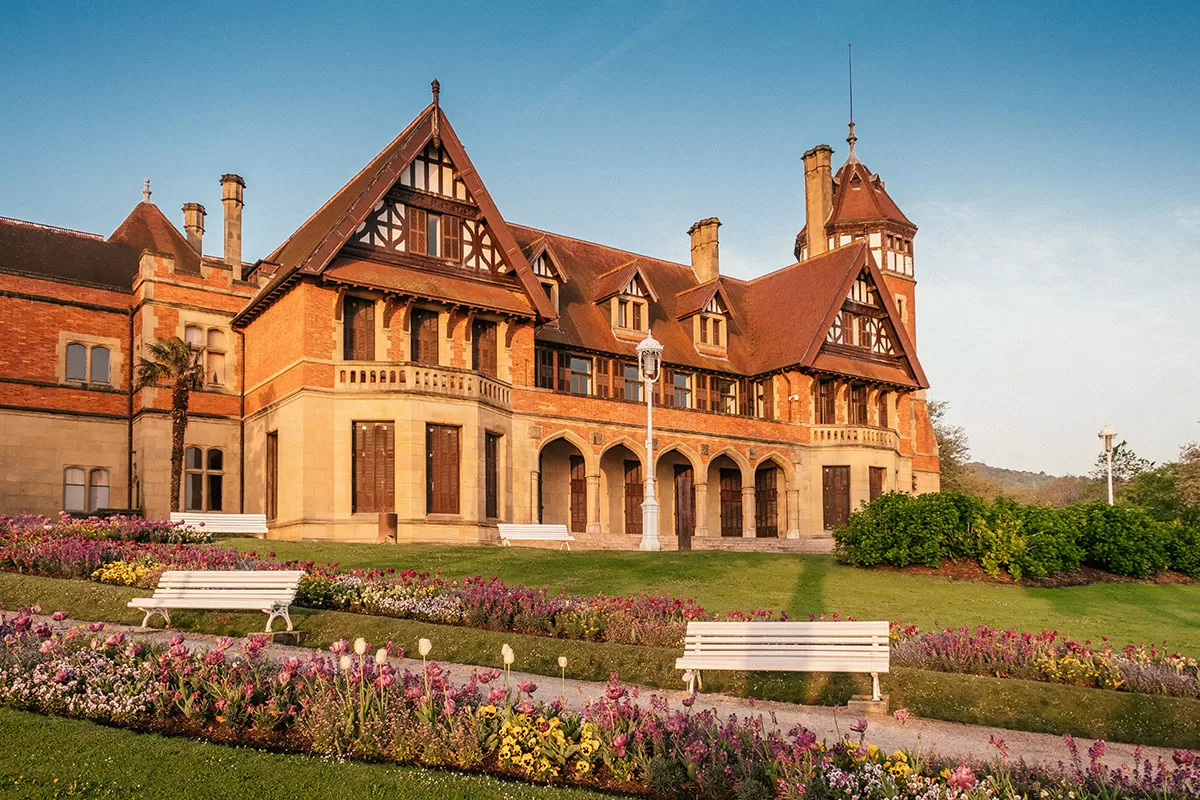
The house itself isn’t open to the public but you can visit its beautifully manicured and colourful gardens. This is an idyllic spot to come and sit and marvel at the beautiful views over a picnic lunch.
Address – 48 Paseo Miraconcha, 20007 Donostia, Gipuzkoa, Spain Admission – Free Opening hours – 07:00 – 21:00 Reviews – Read Tripadvisor reviews of Miramar Royal Palace
10. See the huge crashing waves at Paseo Nuevo
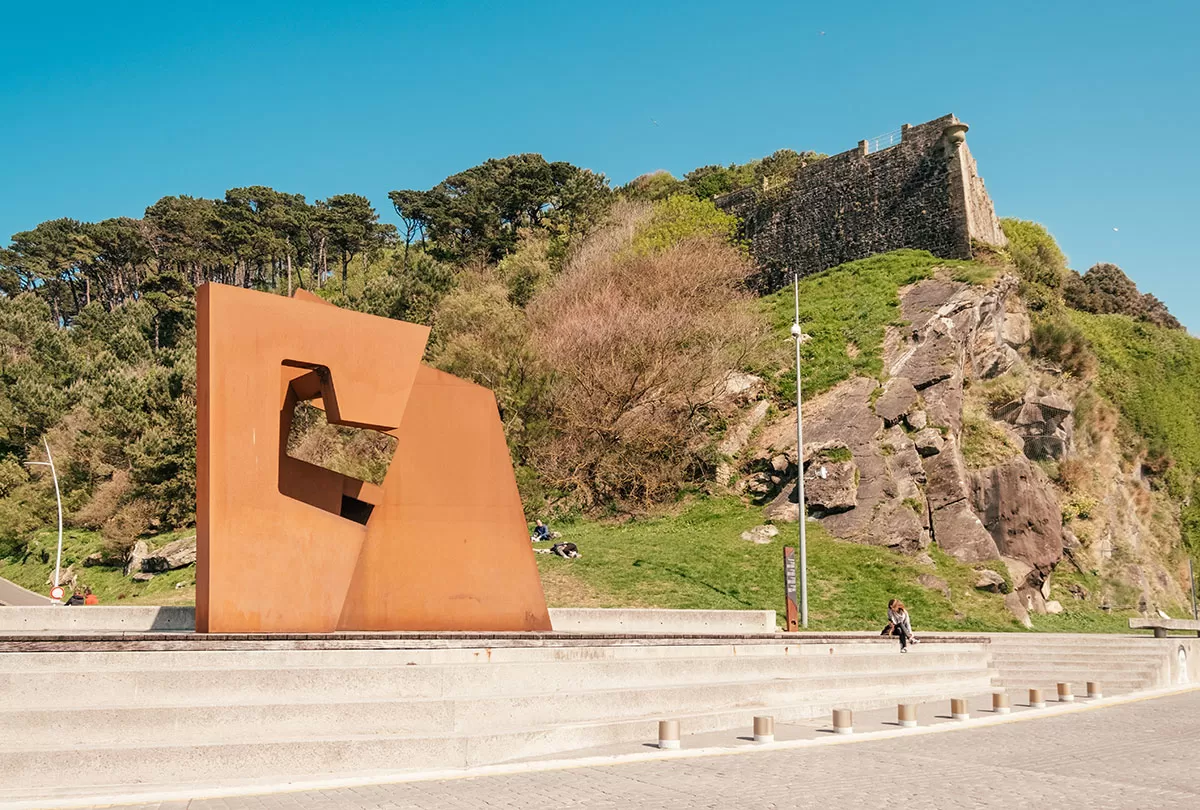
Address – Pasealeku Berria, 20003 Donostia, Gipuzkoa, Spain Admission – Free Opening hours – 24 hrs Reviews – Read Tripadvisor reviews of Paseo Nuevo
11. Step inside Catedral del Buen Pastor, San Sebastián’s largest church
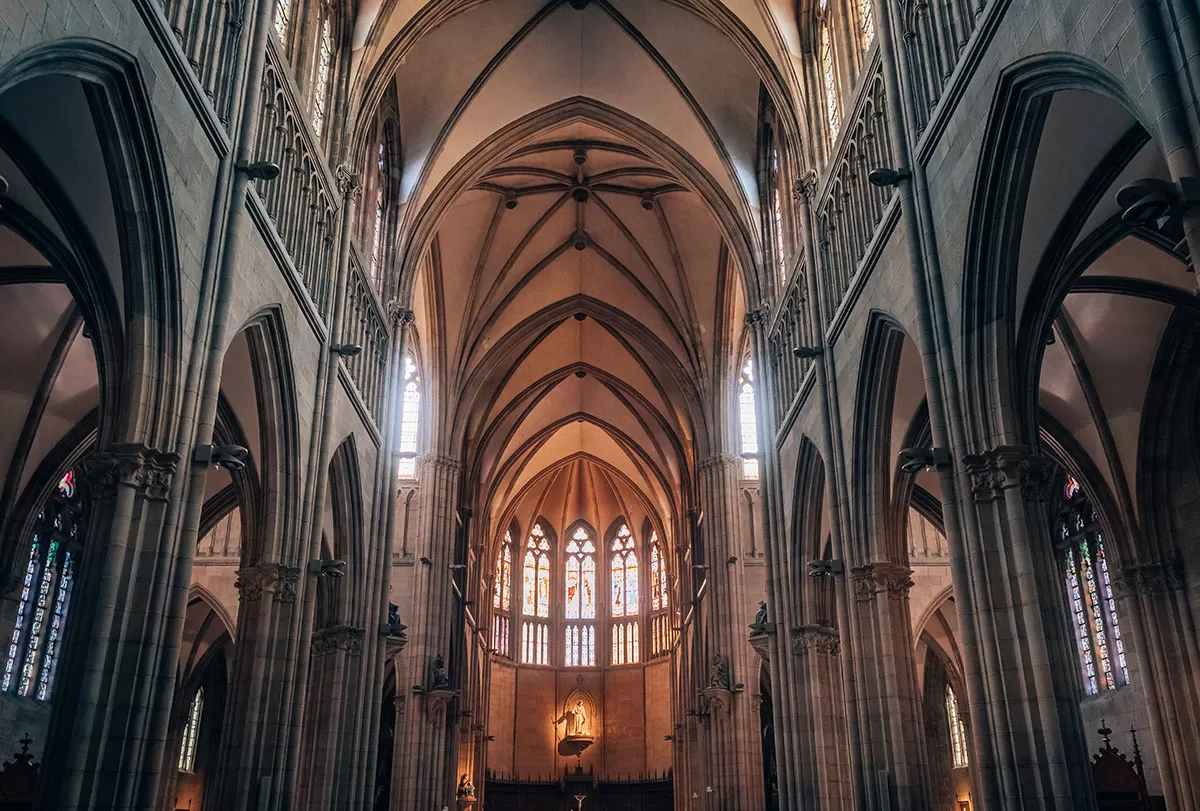
Located in the New Town, this Neo-Gothic cathedral was designed by Basque architect Manuel de Echave in 1880 and was completed in 1897. Inside is richly decorated with stained-glass windows and an organ consisting of more than 10,000 whistles, making it one of the biggest in Europe.
Address – Urdaneta Kalea, 12, 20006 Donostia, Gipuzkoa, Spain Admission – Free Opening hours – 08:00 to 12:30 and 17:00 to 20:00 Reviews – Read Tripadvisor reviews of Catedral del Buen Pastor
12. Visit the Museo de San Telmo History Museum
Learn about the cultural heritage of the Basque country at Museo de San Telmo, the biggest museum for Basque history from prehistoric times to the present day. The museum building is equally impressive occupying both a 16th-century Dominican convent and Renaissance-era buildings.
Over 26,000 historic artefacts are on display here providing an interesting insight into the country’s past. The collection is divided into four key areas including fine arts, history, archaeology, and ethnology. In the fine arts area are paintings, drawings, and sculptures by El Greco, Rubens, Morán, and Ribera alongside Basque artists such as Arteta, Echagüe, Salaberría, Ugarte, and Zuloaga.
The history exhibit showcases weapons from the 15th century to the present day and the archaeology exhibit includes a collection of ceramics, coins, and pre-Columbian artefacts.
Address – Plaza Zuloaga, 1, 20003 San Sebastián, Guipúzcoa, Spain Admission – Adult 6,00 € / Students and over 65 years 3,00 €, free admission on Tuesdays Opening hours – From Tuesday to Sunday: 10:00 – 20:00 Reviews – Read Tripadvisor reviews of Museum de San Telmo Official website – Plan your visit with the official Museo de San Telmo website
13. Surf, swim or stroll along Playa de Ondarreta
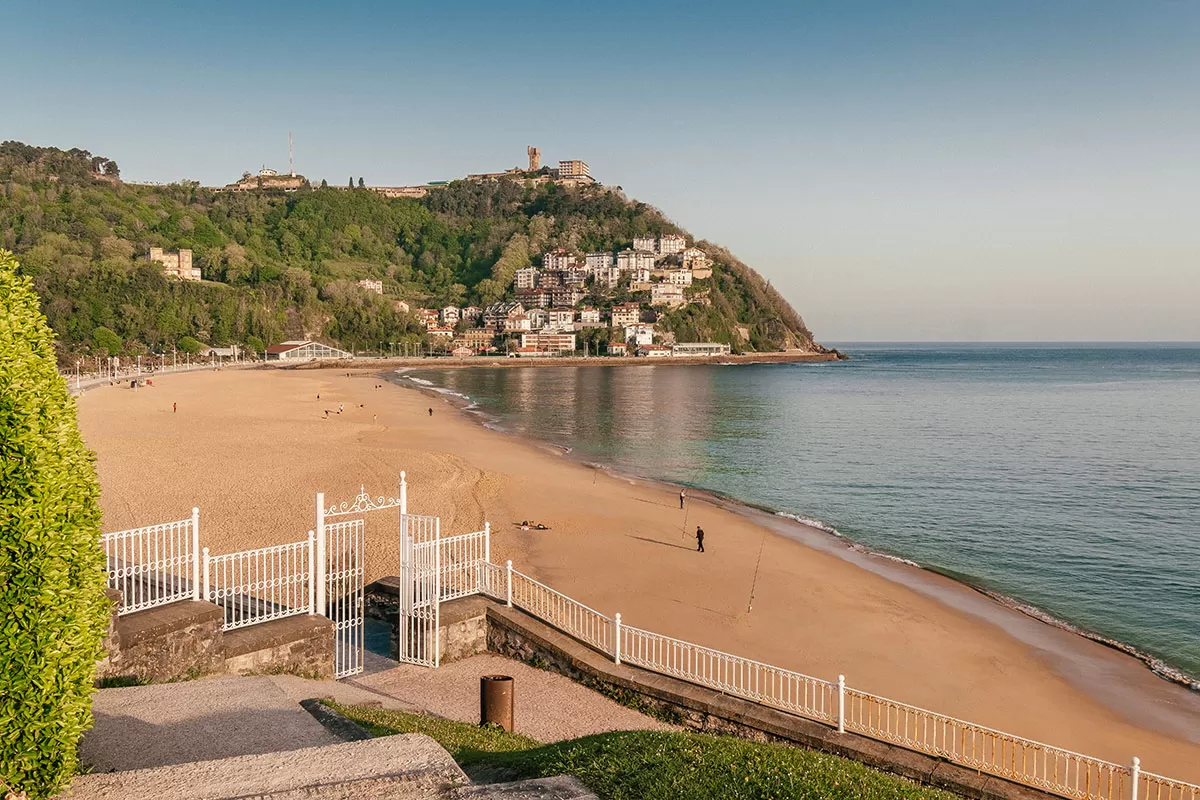
During the winter, you’ll find bodyboarders and surfers here and from June to August the beach fills up with classic striped beach cabanas, lounge chairs, and sun parasols. On its promenade is a lovely garden with a sculpture of Queen María Cristina.
Address – Ondarreta Pasealekua, 20008 Donostia, Gipuzkoa, Spain Admission – Free Opening hours – 24hrs Reviews – Read Tripadvisor reviews of Playa de Ondarreta
14. Catch a ferry to Santa Clara Island (Isla de Santa Clara)
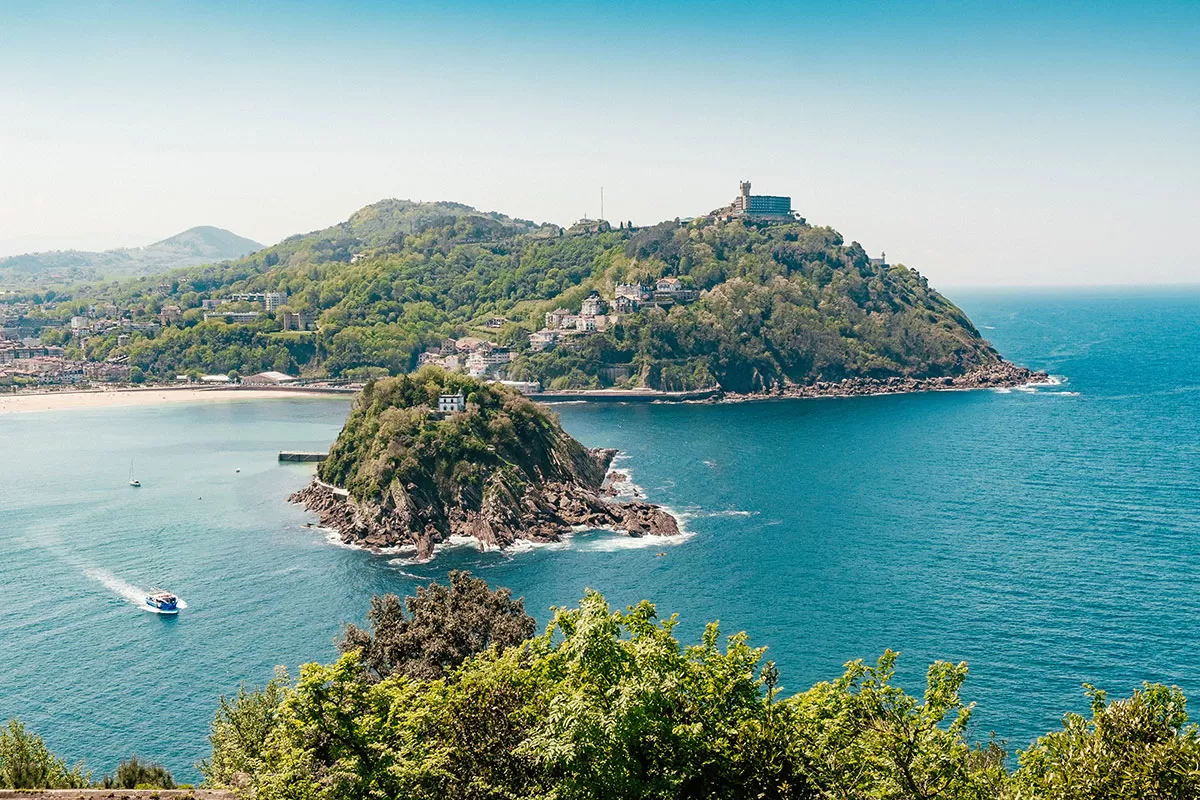
Considered a Historical National Interest Site, this island offers a peaceful bathing experience paired with a café, restaurant, and picnic areas. Go in search of its natural swimming pools located in hidden nooks around the island before taking a leisurely and scenic stroll up to its charming lighthouse for excellent views.
Scenic boat rides around the bay with underwater viewing plus a trip to the island are available for 6,50 €.
Address – 82C2+J9 Donostia-San Sebastián, Spain Admission – 4,00 € return Opening hours – During summertime from June 1 to September 30, a ferry runs from the San Sebastián harbour to the island every 30 minutes from 10:00 to 20:00. Reviews – R ead Tripadvisor reviews of Isla de Santa Clara Official website – Plan your trip using the official Motoras de la Isla website.
15. Eat the World’s Best Cheesecake at La Viña
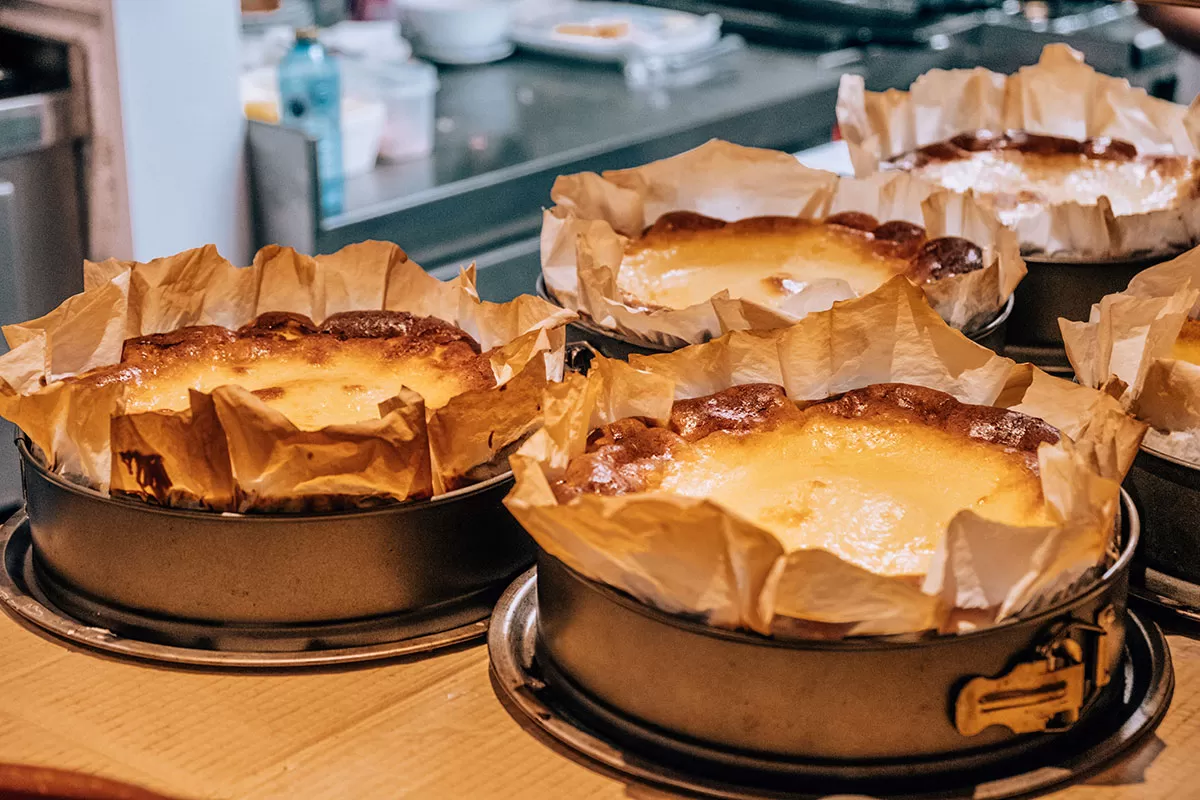
People from all over flock to La Viña bar and restaurant who critics claim make the “World’s Best Cheesecake”. La Viña bakes upwards of 100 cheesecakes a day so it’s fair to say they’ve definitely mastered the art of this mouthwatering crustless cheesecake (gazta tarta).
The caramelised cheesecake is a cross between a dense New York-style cheesecake and Spanish flan and for just 5,00 € each serving comes with two slices, which you won’t want to share. At least, I didn’t!
Address – 31 de Agosto Kalea, 3, 20003 Donostia, Gipuzkoa, Spain Price – 5,00 € for two slices Opening hours – Tuesday to Sunday 11:00 – 16:00 and 19:30 – 23:30 Reviews – Read Tripadvisor reviews of La Viña
16. Go surfing at Playa de la Zurriola
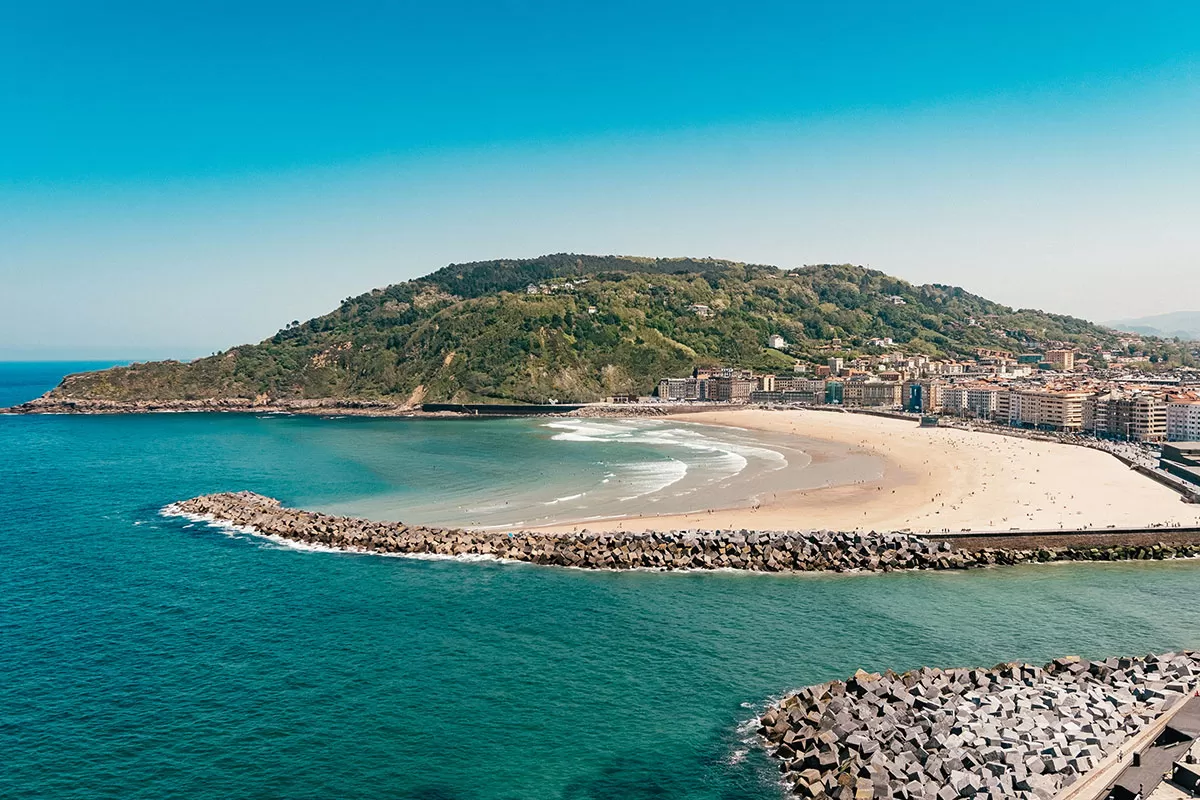
Address – Zurriola Ibilbidea, s/n, 20002 Donostia-San Sebastián, Guipúzcoa, Spain Admission – Free Opening hours – 24hrs Reviews – Read Tripadvisor reviews of Playa de la Zurriola
17. Visit the 12th-century Castillo de la Mota
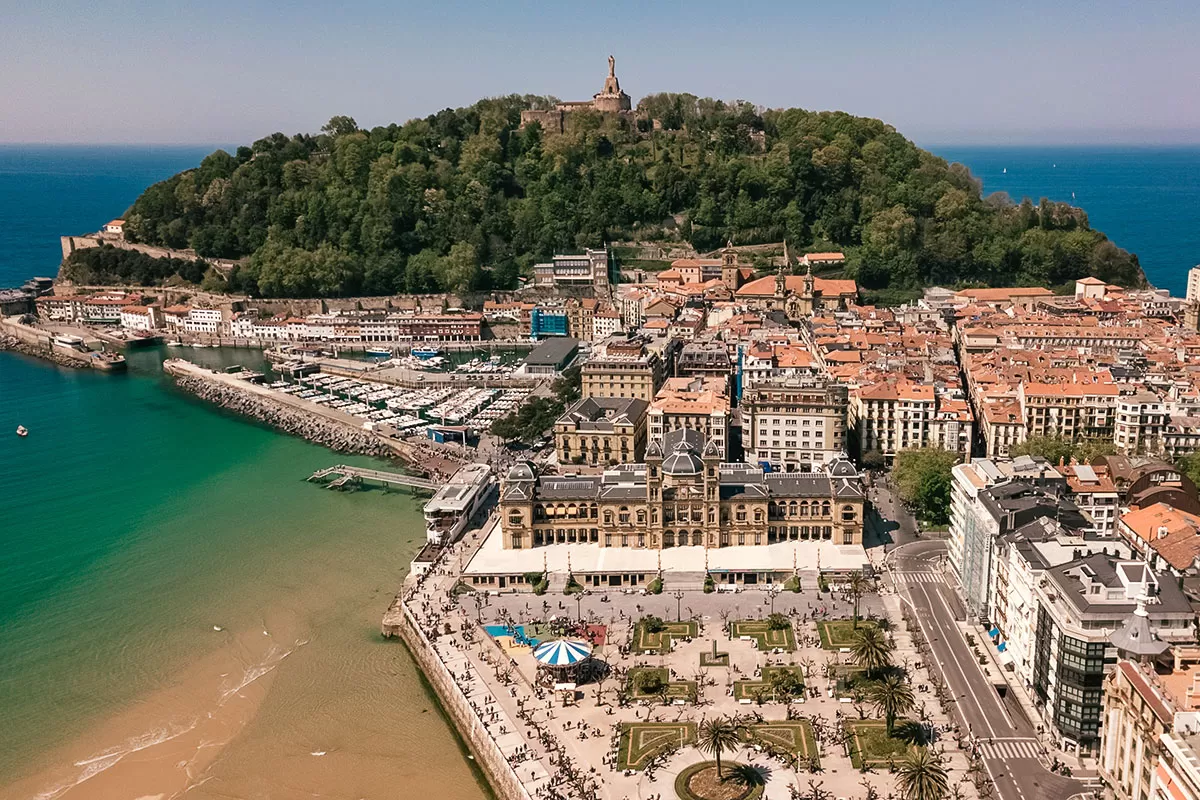
Adorning the top the castle is a 12-meter high sacred heart statue (Cristo de la Mota) watching over the city by Frederico Coullaut who completed it in 1950.
Today, the castle is home to the Casa de la Historia (History House Museum) which documents the city’s 800-year history. Explore the museum with a tour guided by audio-visuals, models, objects and scenographies.
The walk to the top is lovely and for the most part, is shaded. The path up can be reached from Kaiko Pasealekua where the boats are or from the streets behind Basílica de Santa María del Coro. On a hot day, I recommend cooling off with a beer or ice-cream at Polboriña, a small cafe located near the castle with outdoor seating and gorgeous views of Santa Clara island.
Address – 82G6+2C Donostia-San Sebastián, Spain Admission – Free Opening hours
- Every day from 11:00 to 20:00 (July 1 – August 31)
- Wednesday to Sunday from 10:00 to 17:30 (September 1 – June 30 )
Reviews – Read Tripadvisor reviews of Castillo de la Mota
18. Visit Iglesia de San Vicente, San Sebastián’s oldest church
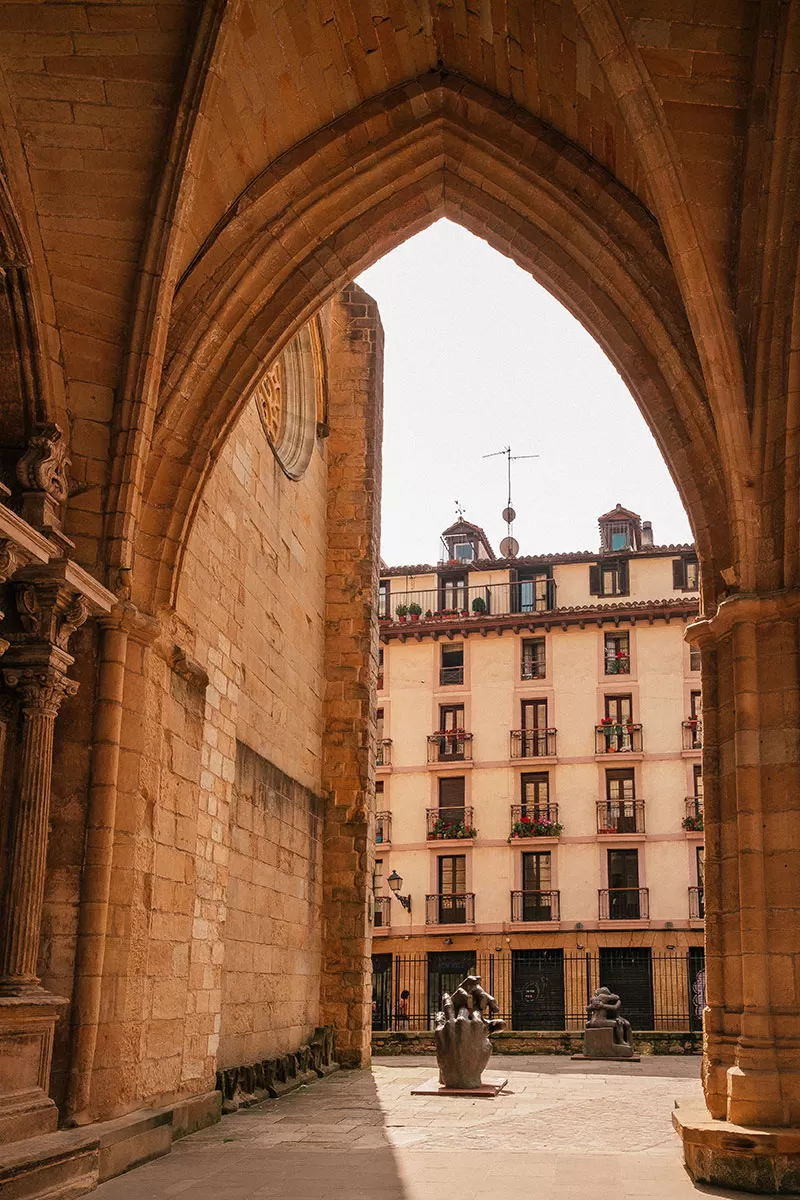
The church you see today was built during the first half of the 16th century under the Gothic style. Before entering the church, notice the sculpture of “La Piedad”, by the artist Jorge Oteiza on the church’s facade. Church of San Vicente is home to one of the best Romanesque altarpieces and highlights of the church, made by Ambrosio de Bengoechea in collaboration with Juanes de Iriarte.
A fun little fact I learned is that those who are christened in here are called “koxkeros”, after the stones protruding from the church (koxka in Basque).
Address – San Juan Kalea, 15, 20003 Donostia, Gipuzkoa, Spain Admission – Free Reviews – Read Tripadvisor reviews of Saint Vincent Church
19. Spoil your taste buds with a Pintxos and Ice-cream
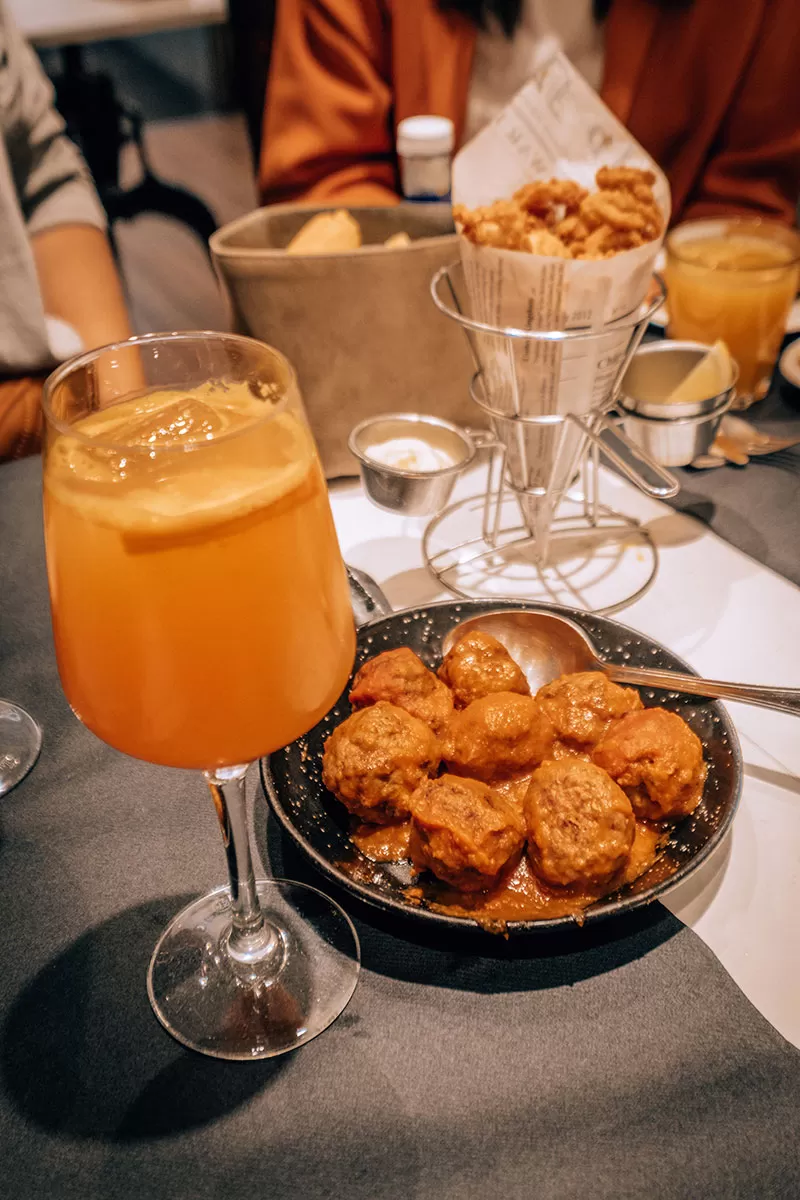
A local tradition is to sample a local ice-cream so don’t be shy, try one, two or three San Sebastián’s ice creams in any of its ice-cream shops which boast a wide range of flavours.
Not sure where to start? For recommendations on where to eat in San Sebastián , see the section below!
Where to eat in San Sebastián
Let your taste buds take you on a tour of San Sebastián with these tasty restaurant recommendations. A quick word of warning. If you’re vegan or vegetarian (like me), finding pintxos that meet your dietary requirements will be very difficult. The closest you’ll get is a tortilla de patatas, but you can’t just have this for every meal. My advice is to stick to dining in a restaurant where you’ll have more options. I also found this vegetarian pintxos tour which I’m annoyed I didn’t see earlier.
Here are all the places me and my friends ate at and recommend.
Old Town Coffee
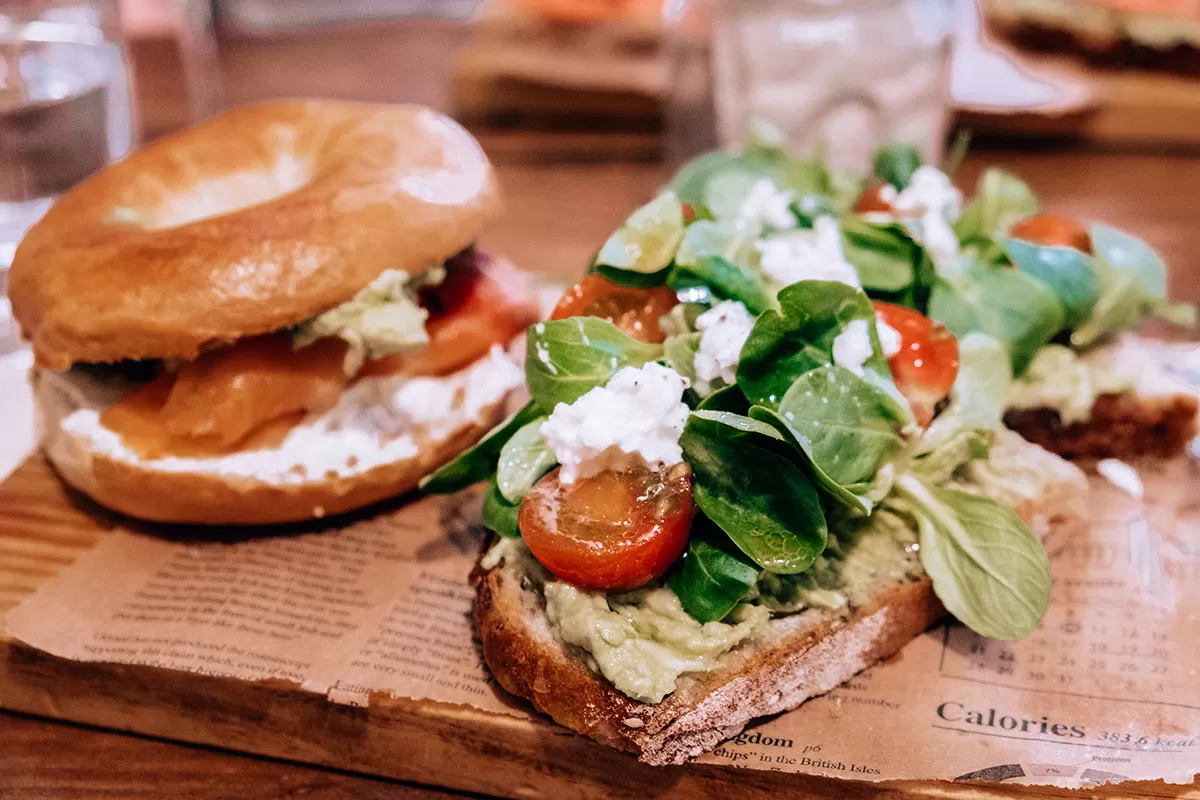
Address : Reyes Catolicos Kalea, 6, 20006 Donostia, Gipuzkoa, Spain Opening times: Tuesday-Saturday 09:00 – 18:00 / Sunday 09:00 – 13:00
La Casa Vergara
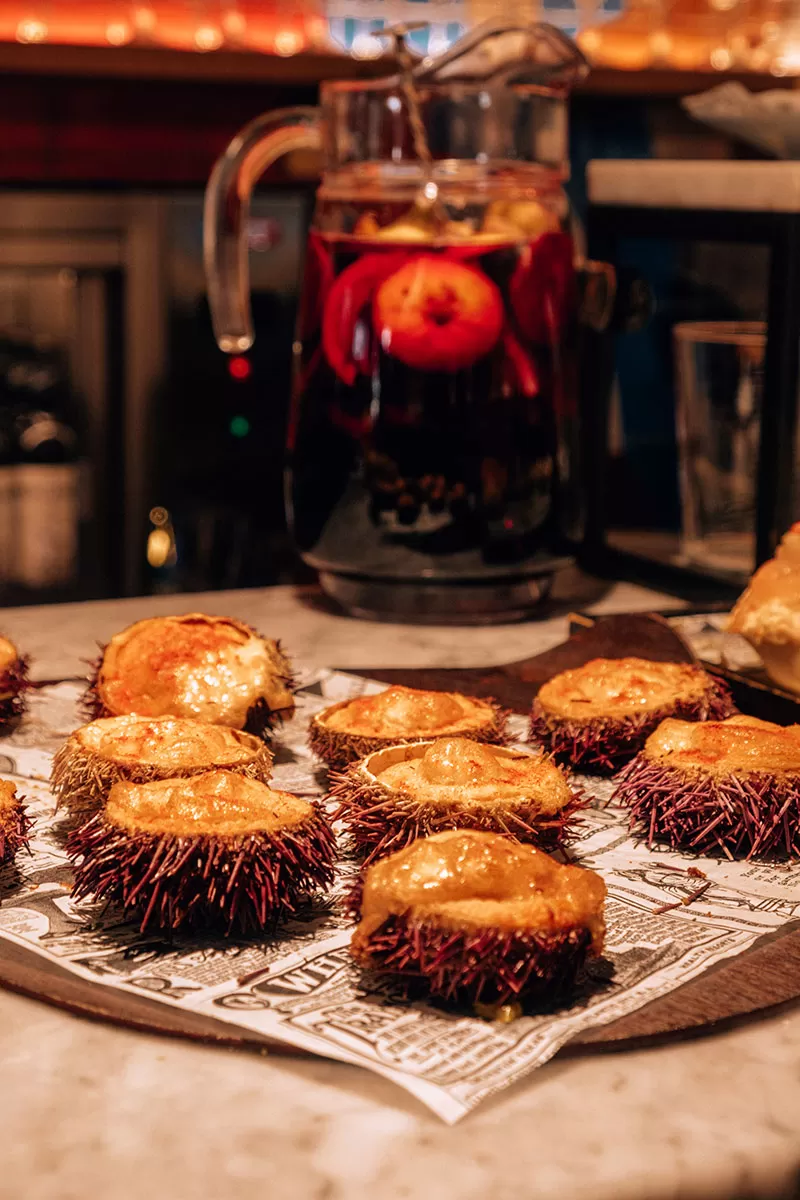
Address: Calle Mayor, 21, 20003 San Sebastián, Guipúzcoa, Spain Opening times: Everyday 11:00 to 24:00
La Cuchara de San Telmo
La Cuchara de San Telmo is well-known for preparing some of the best dishes in Basque cuisine. I must admit that nothing on the menu appealed to me as a vegetarian (I ate at a nearby restaurant afterwards) but nonetheless, my friends absolutely loved it.
Unlike most pintxo bars in San Sebastián, everything at La Cuchara de San Telmo is made to order based on what’s in season. For this reason, I recommend arriving early, no later than 20:00 otherwise you risk waiting in the long queue and once you get your food, you’ll have to eat it standing up outside. There is very little space inside and tables outside fill up quickly.
Everything here is good, or so my meat-eating girlfriends tell me. Some vegetarian options are available but to be honest, I’ve never liked French Onion soup 😛
Address: Santa Korda Kalea, 4, 20003 Donostia, Gipuzkoa, Spain
Opening times:
- Tuesday – Friday 19:30–00:00
- Saturday – Sunday 12:00 – 15:30 and 19:30 – 23:30.
- Monday closed
Xibaris Restaurante
I had one of my better vegetarian meals here. I had probably the best patatas bravas of the trip here and a large garden salad. It might look small from the outside but there is additional seating available downstairs. The service was excellent too.
Address: San Jeronimo Kalea, 20, 20003 Donostia, Gipuzkoa, Spain Opening times: Monday – Tuesday 11:00 – 16:00 / Wednesday – Sunday 11:30 – 00:00
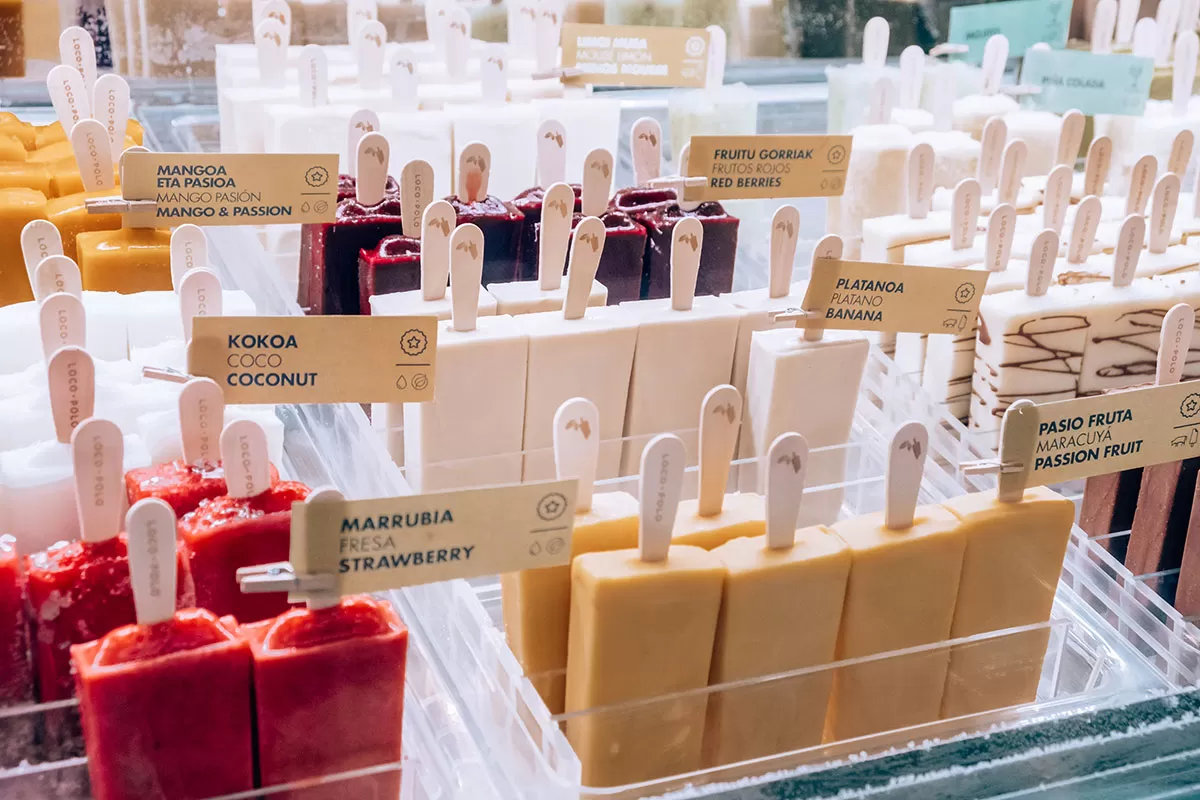
Address: Narrika Kalea, 10, 20003 Donostia, Gipuzkoa, Spain Opening times: Everyday 11:00 – 01:00
Getting Around San Sebastian
San Sebastián is a very walkable city so it’s unlikely you’ll need to use public transportation to get around the city centre.
DBus is San Sebastián public bus network. Fares cost €1.70 (€2.10 at night) and can be bought on board from the drive. Buses run from 07.30 to 22.30 after which a limited night bus service continues until about 04:00. One of the most useful routes is bus 16, which connects the city centre with Monte Igueldo.
Taxis are available 24hrs a day with official rates in place which operate with a taximeter. unlike in other cities, taxis in San Sebastián do not normally stop when hailed down in the street. The best idea is to head for a taxi rank or phone Taxidonosti +34 943 46 46 46 or Vallina Teletaxi +34 943 40 40 40.
How to Get to San Sebastián from Bilbao city
If you’re coming from Bilbao you can catch the tram to San Mamès and catch a bus to San Sebastián. Tickets must be booked in advance via alsa.com . The journey time is roughly 75 minutes.
How to Get to San Sebastián from Bilbao Airport
San Sebastián has a domestic airport which is only 20 kilometers away with numerous connections to/from Madrid and Barcelona. If you’re arriving from abroad, then your best bet is to fly into Bilbao International which is approximately 100 kilometres away. The best and cheapest way to get to Donostia-San Sebastián from Bilbao Airport (Loiu) is by bus. There is a direct bus service which departs from the airport and will take you to the city centre in just 75 minutes. The bus stop is located outside the airport to your right, and the name of the bus company is PESA.
Departures: There is one departure per hour from 07:45 to 23:45. The bus making the route San Sebastián-Bilbao airport departs on the hour from 05:00 to 21:00. Price: Single tickets cost 17,10 euros. Check times and book your ticket here
Accommodation: Where to stay in San Sebastián
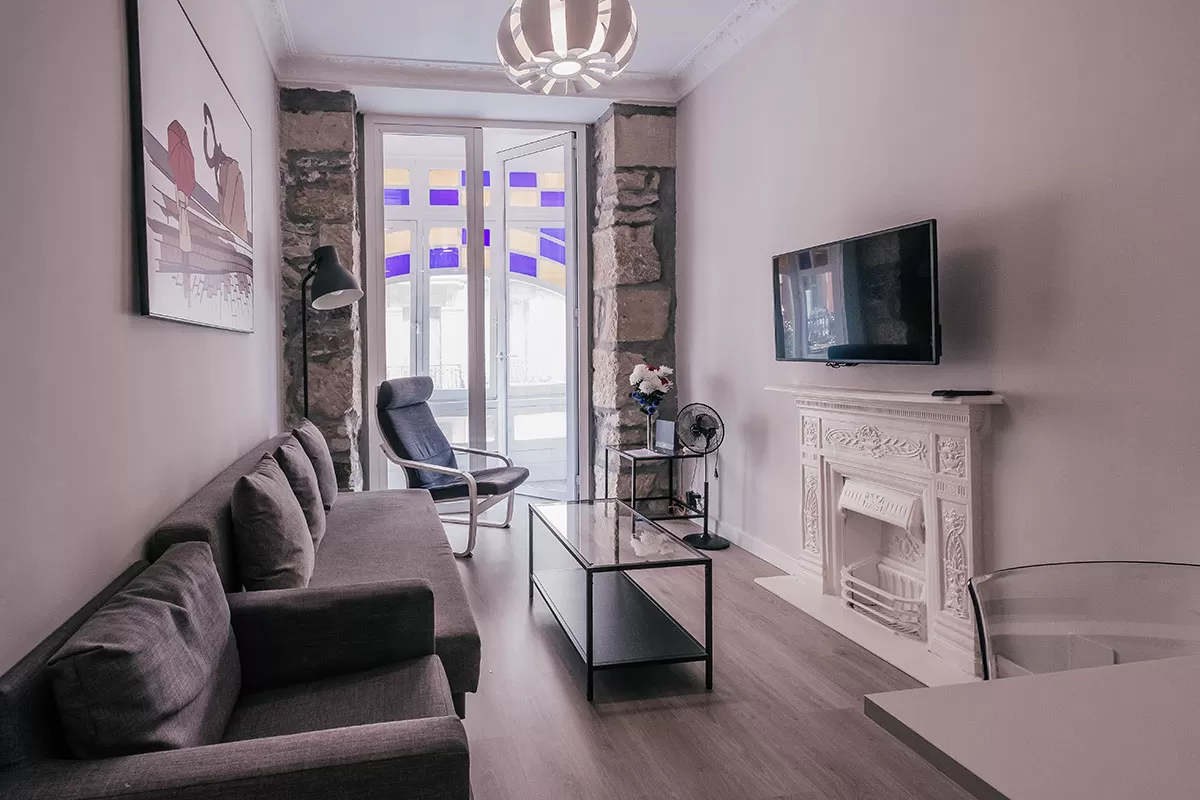
Tours and Day trips from San Sebastián
Got more time? Consider going on a day trip or join one of these tours.
- French Basque Countryside Tour
- Biarritz and French Basque coast tour
- San Sebastian Lunch Time Pintxo Tour with Wine
- San Sebastián Electric Bike Tour
- Basque Pintxos and traditional dishes cooking class
- La Rioja Wine Full Day Experience Tour
- Basque Cider Tour
- Hondarribia and Pasaia (San Pedro & San Juan) Tour
Visiting Spain? Check out my other Spain travel guides
- Where to Stay in Gran Canaria, Spain (The BEST Hotels)
- 36 Exceptional Things to do in Gran Canaria, Spain (Canary Islands)
- 19 Absolute Best Things to Do in Bilbao, Spain
- 13 Free things to do in Barcelona, Spain
- 23 Beautiful Must-See Places in Madrid, Spain
- 19 Reasons You’ll Want to Visit Costa Brava in Spain Right Now
- Costa Brava – Get my Ultimate 5-Day Costa Brava Itinerary
Learn Spanish with me, with Intrepid Spanish!
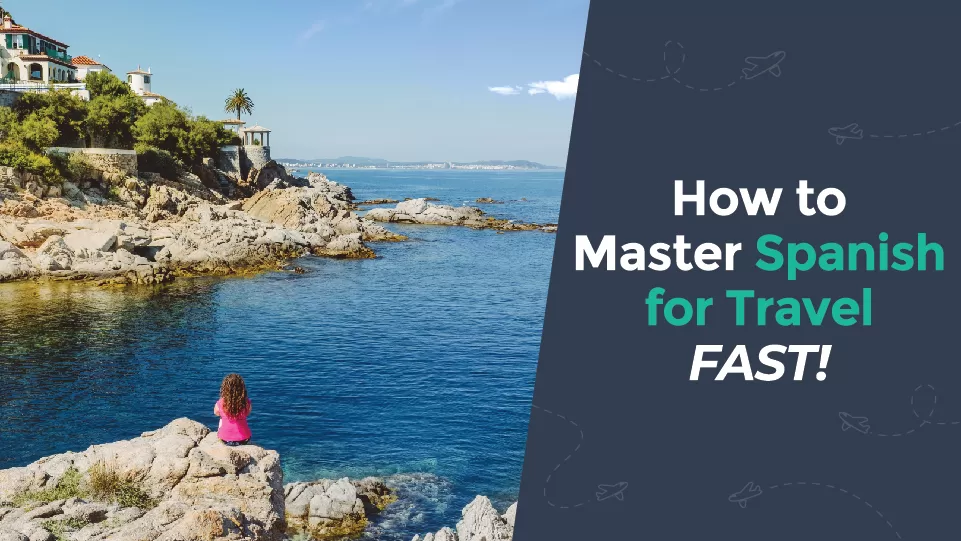
Travelling to Spain? Don’t be treated like a tourist! Live your best travel experiences and learn Spanish for less than the cost of eating at a tourist trap restaurant or a taxi driver who has “taken you for a ride”. In addition to my free Spanish travel phrase guide , I’ve made it even easier for you to master the Spanish language so you can create lifelong memories as you mingle with locals , get local tips , avoid tourist traps , and make new friends . Join my popular Spanish course here.
Here’s what my students are saying:

Loved it, loved it, loved it. I’ve been trying to learn languages using various language learning apps for years now and although I know random words I feel no more confident in actually speaking the language than I was when I started.” – Basil Pereira
Click here more details and get instant access!
Like it? Pin it for later!
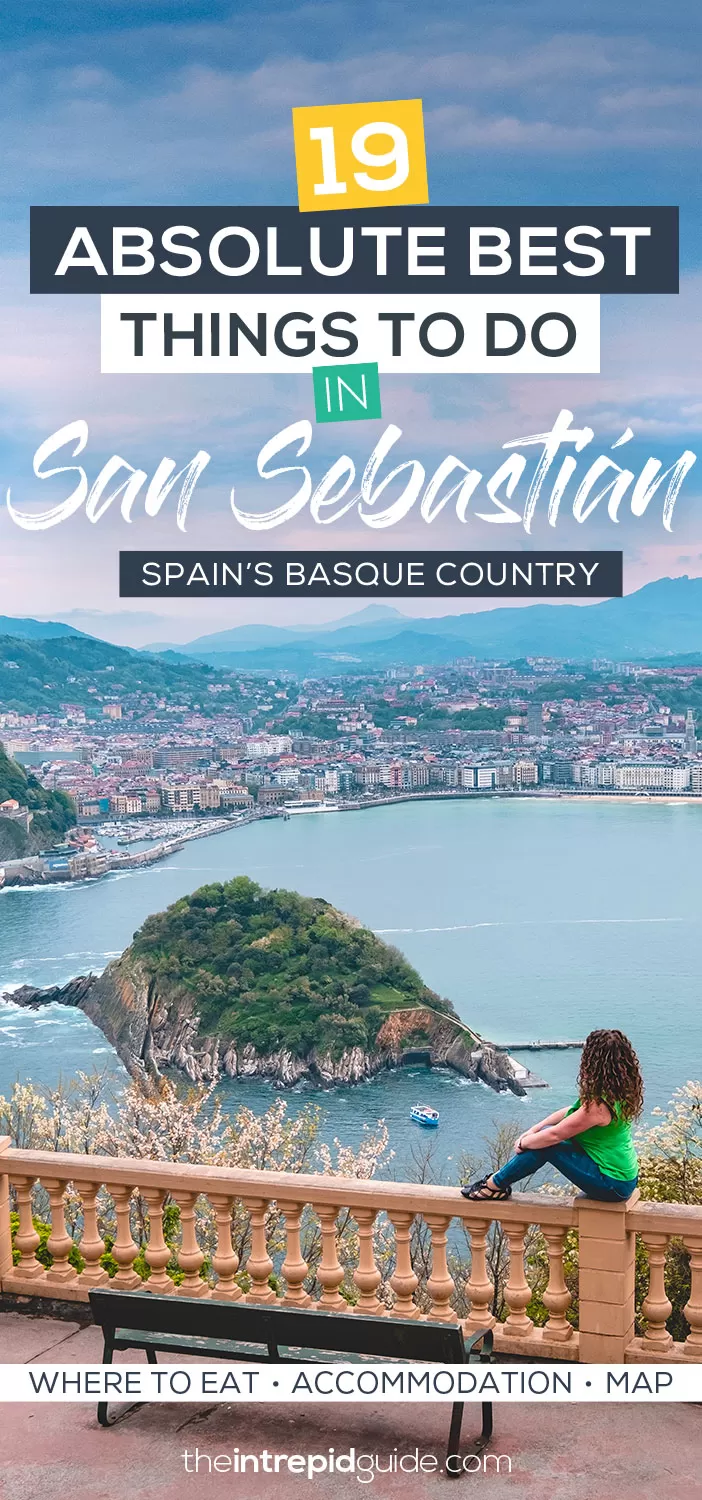
Over to you!
Do you have a question about visiting San Sebastian? Ask me below! Let me know using the comments section below or join me on social media to start a conversation.
Thanks for reading and I hope you enjoyed this post. Like what you see? Subscribe using the form below to have all of my posts delivered directly to your email.
Success! Now check your email to confirm your subscription.
There was an error submitting your subscription. Please try again.
Get my best language and travel tips FREE by email...
Subscribe to my newsletter to receive detailed travel guides, exclusive travel and language learning tips, priority access to giveaways and more!
I will never give away, trade or sell your email address. You can unsubscribe at any time.
Michele creates language learning guides and courses for travel. What separates her from other instructors is her ability to explain complex grammar in a no-nonsense, straightforward manner using her unique 80/20 method. Get her free guide 9 reasons you’re not fluent…YET & how to fix it! Planning a trip? Learn the local language with her 80/20 method for less than the cost of eating at a tourist trap restaurant Start learning today!
16 Lovely Things to Do in Stratford-upon-Avon: A Detailed Guide to Shakespeare’s Birthplace
99 essential basque (euskara) phrases for your trip to the basque country, you may also like, 19 absolute best things to do in bilbao,....
Hey Michele,
Awesome post. I’m looking for all possible information about Spain. I saw a great trip to see where they recorded the best series of all time: Game Of Thrones.
I intend to spend about 20 days in Spain and I want to know every detail of the culture and the main locations. Thank you so much for sharing your experience with us.
Thanks Rafa, I’m so glad you enjoyed this guide. Wishing you an amazing trip 🙂
Leave a Comment Cancel Reply
Save my name, email, and website in this browser for the next time I comment.
This site uses Akismet to reduce spam. Learn how your comment data is processed .

If you don't know where you are , how do you know where you're going? Find out how well you know Italian grammar today!

16 Top-Rated Attractions & Things to Do in Biarritz
Written by Lisa Alexander Updated Dec 28, 2023 We may earn a commission from affiliate links ( )
Biarritz exudes the elegance and sophistication that you would expect of a celebrated European seaside resort . This Basque Country beach town has been fashionable ever since Empress Eugénie (wife of Napoléon III) decided to spend summer holidays here in the 19th century.
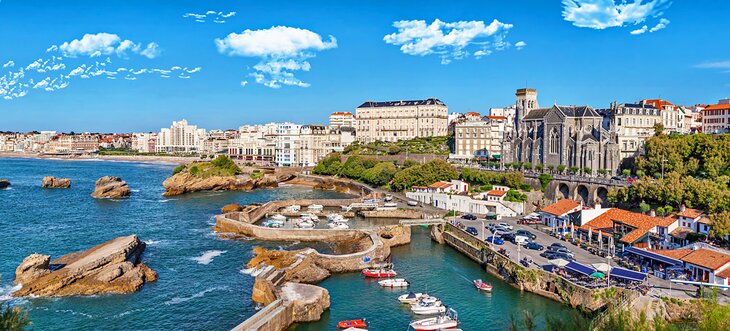
Before it became a resort town, Biarritz was just a sleepy fishing village, albeit in a magnificent setting. The coastal enclave nestles along the Bay of Biscay and looks directly out onto dramatic Atlantic Ocean waves.
Though the regal influence of Biarritz has faded, the city has retained its prestige. In fact, Biarritz is now considered one of the most desirable beach destinations in France and is certainly among the most glamorous. Another claim to fame: Biarritz is the capital of surfing in Europe.
If you're seeking a beach holiday that combines natural beauty and culture, then Biarritz is a fabulous choice. You can spend your days sunbathing on the beach and taking walks along the seafront promenades, with breaks for gourmet meals and afternoon tea. The city brims with inviting cafés, excellent fine-dining restaurants, and fancy pâtisserie boutiques.
Discover the best places to visit and things to do in the legendary beach town of Biarritz.
See also: Where to Stay in Biarritz
1. Grande Plage
2. plage du miramar, 3. biarritz aquarium, 4. biarritz lighthouse, 5. elegant boulevards and squares, 6. miremont tea salon, 7. rocher de la vierge (virgin of the rock), 8. chapelle impériale, 9. surfing beaches, 10. day trip to saint-jean-de-luz, 11. basque country excursion: village of espelette, 12. eglise orthodoxe de biarritz, 13. kid-friendly beaches, 14. cité de l'océan, 15. unesco-listed saint-jean pied de port, 16. musée d'art asiatique (museum of asian art), where to stay in biarritz for sightseeing, map of attractions & things to do in biarritz.
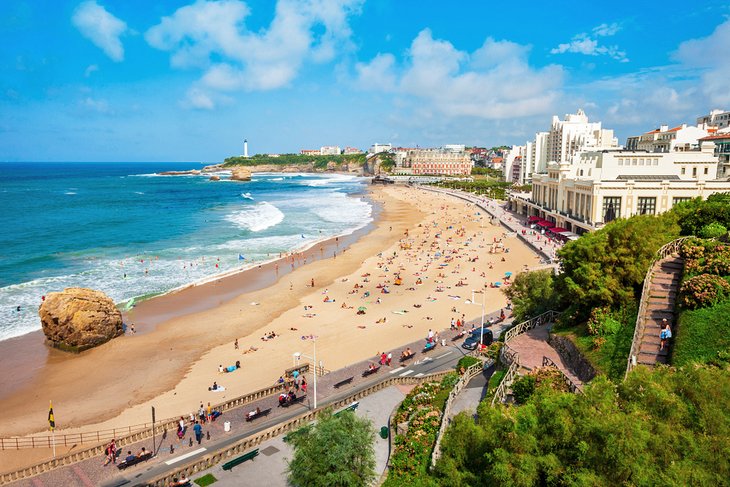
Biarritz' most central beach, the Grande Plage has attracted high-society vacationers since the Belle Epoque. This wide, sandy beach begins at Bellevue near the Boulevard du Général de Gaulle and extends to the Hôtel du Palais.
In summertime, the beach is covered with sunbathers and their colorful striped cabanas. Lifeguards are on duty from May through October with more extended hours during the high season.
Beach safety: It is important to note that this beach has heavy surf. Water safety is posted on a daily basis. During certain periods of strong currents, bathing, swimming, and surfing are prohibited.
Alongside the beach, the Quai de la Grande Plage promenade is a perfect place to visit for taking a leisurely stroll. This wide pedestrian walkway offers vistas of the breaking waves and the Biarritz lighthouse in the distance.
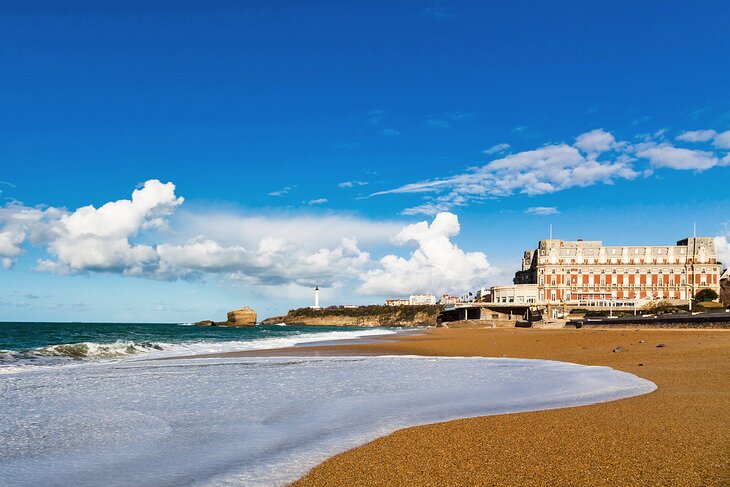
On a headland at the end of the Grande Plage, the Hôtel du Palais Biarritz offers sumptuous accommodations. Napoléon III commissioned this palace for his wife Eugénie. A classified Monument Historique , the palace has been converted into a luxurious five-star hotel that features a full-service spa, fitness center, and an outdoor swimming pool.
The Hôtel du Palais also boasts a Michelin-starred restaurant, La Rotonde – La Table d'Aurélien Largeau, in an opulent Second Empire dining room with ocean views. If you decide to indulge at this refined gastronomic establishment, you will be treated to the finest contemporary Basque cuisine, while watching the surf crash against the shore.
Another gourmet destination on the Grande Plage is the Maison Dodin , which has an outdoor terrace overlooking the beach. This pâtisserie boutique/restaurant (open every day) serves breakfast, brunch, lunch, and afternoon tea.
Read More: Top-Rated Beaches in the South of France
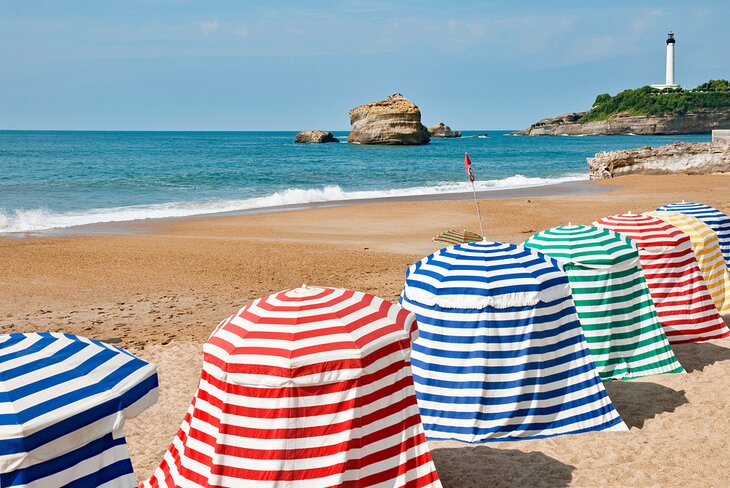
Spectacular scenery and dramatic shore-breaking waves distinguish the Plage du Miramar. The beach extends from the Hôtel du Palais to the Pointe Saint-Martin.
This sheltered shoreline offers a sense of tranquility. However, keep in mind that rough seas and strong currents (including riptides) make swimming dangerous. Check safety conditions and exercise caution before entering the water. Lifeguards are on duty in July and August from 10:30am until 7:30pm daily. In June and September, there is limited lifeguard surveillance.
Miramar Beach has the charm of an old-fashioned seaside resort — especially in summertime when vintage-style, striped beach tents make their appearance.
The beach attracts sunbathers, and spa-goers, who frequent the nearby Thalassa Sea & Spa center in the five-star Sofitel Hotel .
Just off the coast is a huge rock, the Roche Ronde, a protected nature area and bird sanctuary.
Read More: Best Places to Visit in the South of France
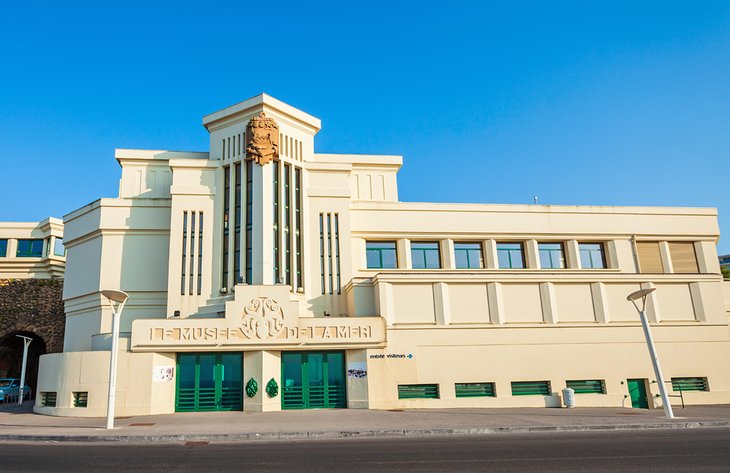
The Biarritz Aquarium stands on a breathtaking piece of oceanfront property opposite the Rocher de la Vierge. The aquarium's spectacular 7,000-square-meter exhibition space rivals the natural splendor of the scenery.
More than 20 aquarium tanks are filled with a wide range of amazing species, from lobsters and sea urchins to turtles and hammerhead sharks. The aquariums represent species from all the Seven Seas.
Check out the outdoor terrace to admire astounding ocean views and to watch adorable marine mammals in action at the seal pool . The twice-daily (10:30am and 5pm) seal feeding time is a popular thing to do — especially for families with children. It's fun to watch how quickly the seals gobble up huge amounts of fish.
Address: Esplanade du Rocher de la Vierge, Biarritz
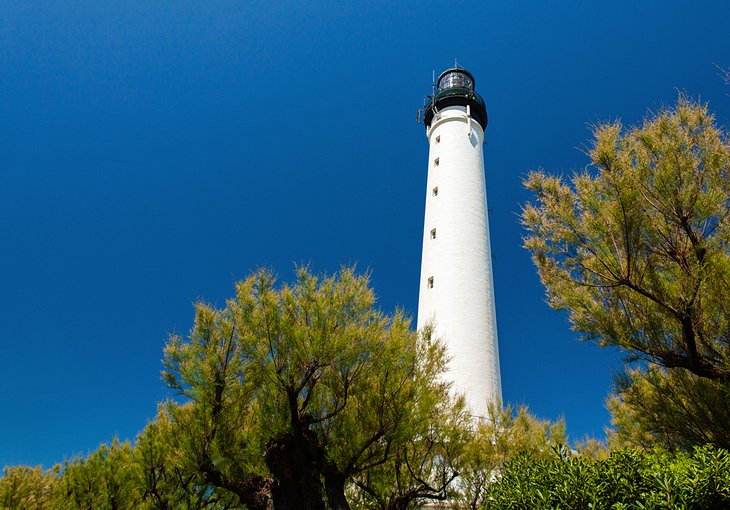
The emblematic Biarritz lighthouse stands at an essential location overlooking the coastline of Cape Hainsart. The lighthouse is at the tip of the Pointe Saint-Martin, which marks a boundary between the sandy beaches of the Landes Coast to the south and the rocky coastline to the north.
Climb the 248 steps of the lighthouse to reach the viewing platform at the top. The lighthouse commands sweeping panoramas of Biarritz and the Basque coastline.
The lighthouse is open every day from June through September. During the off-season, the lighthouse has more limited opening hours. During periods of bad weather, the lighthouse may close.
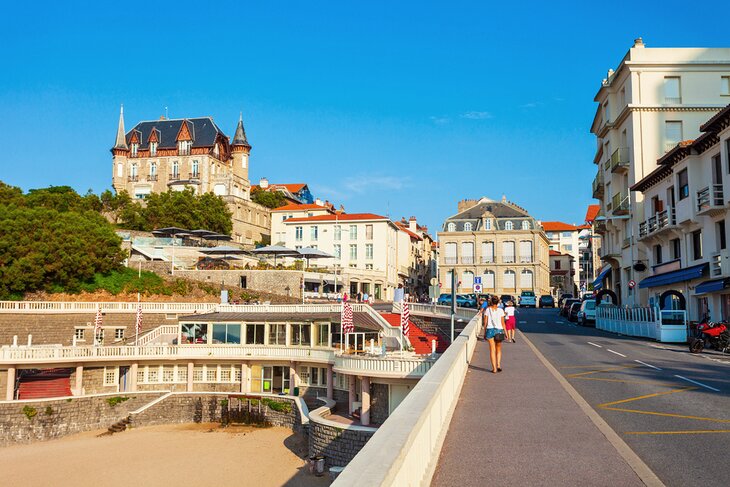
The elegant boulevards, streets, and squares of Biarritz exemplify the city's aristocratic heritage. At the center of Biarritz, the spacious Place Georges Clemenceau joins with several of the city's principal streets. From here, it is a short distance to the Place Bellevue , a semicircular square with panoramic views of the beach and the ocean.
To the south of the Place Bellevue, the Boulevard Maréchal Leclerc runs alongside the old fishing harbor. This seaside boulevard is a good starting point for a scenic walking tour along the Biarritz coast.
Read More: Best Places to Visit in France
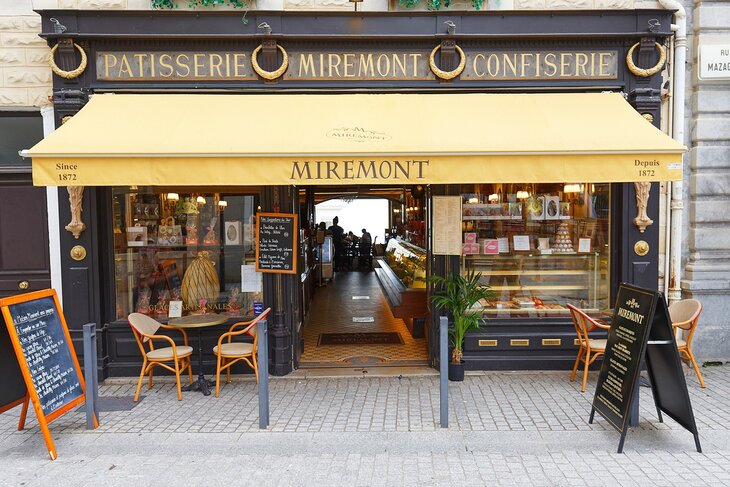
The Miremont is renowned for its elegant ambience and traditional French pâtisserie. You'll find all of the classics in the pastry case, such as éclairs, Gâteau Saint-Honoré, and strawberry tarts.
This historic salon de thé (tea salon) occupies a 17th-century building with ocean views. The Miremont's dining room looks out onto the Grande Plage and the Hôtel du Palais. Upstairs, the salon features pastel pink decor and seems perfectly appointed for a gathering place of aristocratic ladies.
Founded in 1872, the Miremont was frequented by royalty during Biarritz' glory days. Spain's King Alphonso XIII enjoyed having lunch here. King Edward VII of England appreciated the Miremont's exquisite French pastries. Queen Nathalie of Serbia often purchased caramels for her friends, and Queen Amelia of Portugal had a habit of taking her tea at a window seat with the best view.
You may purchase pastries at the Miremont to take away or enjoy lunch or afternoon tea in the dining room. The Miremont also sells gift boxes of chocolates, caramels, and other candies.
Another prestigious 19th-century tea salon in Biarritz, the Maison Dodin offers a similar selection of classic French pâtisserie. Dodin Biarritz is famous for its Béret Basque (chocolate mousse cake) and spectacular oceanfront location, overlooking the Grande Plage.
Address: 1 Bis, Place Clémenceau, Biarritz
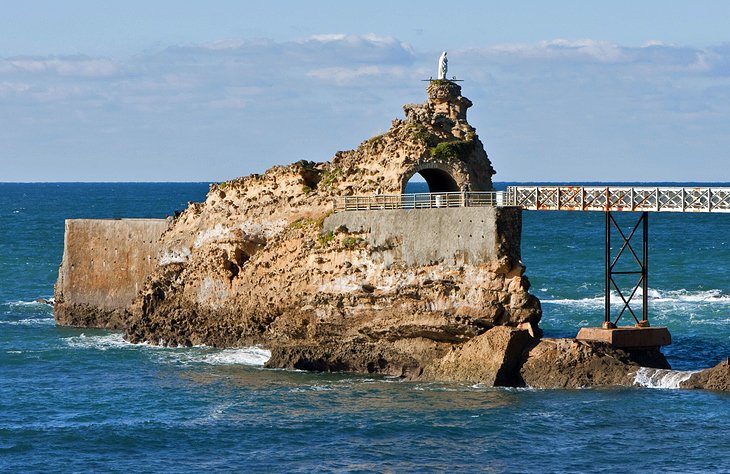
The Rocher de la Vierge is a truly dramatic landmark—a statue of the Virgin Mary set on a steep, narrow rock in the ocean.
According to a local legend, fishermen were guided back to the port during a storm by what seemed to be a divine light. In gratitude, the fishermen installed a statue of the Virgin Mary on the rock.
Napoléon III decided to make the site accessible from the shore and in 1887 asked Gustave Eiffel to create a sturdy metal bridge.
To arrive at the Virgin Mary statue, tourists must walk across the Passerelle Eiffel (pedestrian bridge), suspended high above the pounding ocean waves. The bridge affords awe-inspiring panoramas of the coastline, extending from the mouth of the Adour River to the Spanish frontier.
Other marvelous viewpoints of the Basque coastline can be found nearby at the Esplanade du Rocher-de-la-Vièrge and at the Esplanade du Port-Vieux , where there is a magnificent prospect of the cliff-fringed Côte des Basques extending all the way to the hills of Spain.
Read More: Top-Rated Tourist Attractions in France
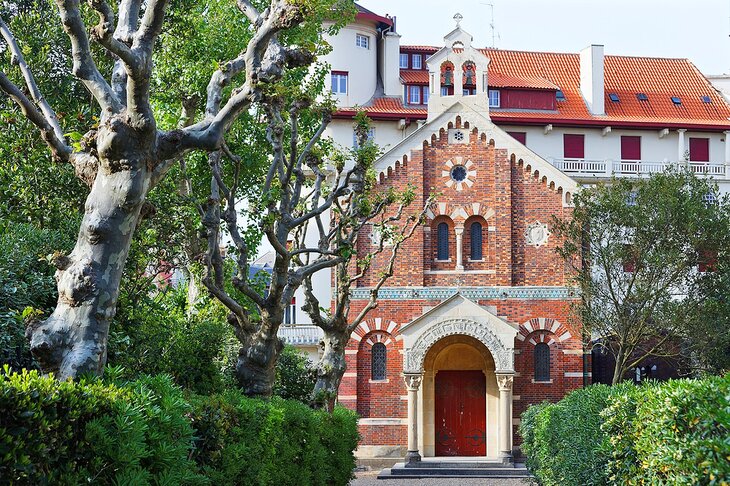
Empress Eugénie requested the creation of the Chapelle Impériale for her own personal spiritual worship. Built in 1865, the chapel is dedicated to the Virgin of Guadalupe (Mexico's patron saint).
This little gem of a chapel reveals an eclectic yet harmonious blend of architectural elements: Romanesque-inspired arches, Moorish design motifs, and glittering Byzantine-style gilded mosaics. The ornate details add up to an enchanting interior, which dazzles the eyes.
The Chapelle Impériale has been classified as a Monument Historique and allows visits during limited hours. From June through September, the chapel is open on Thursday and Saturday afternoons. In March, April, May, October, November, and December, the chapel is open on Saturday afternoons. Guided tours are available.
Mass is held here four times a year on specific dates: January 9th to commemorate the death of Napoléon III; June 1st , the anniversary of the death of Louis-Napoléon Bonaparte, the Prince Impérial (the only child of Napoléon III and Eugénie) who was killed in action during the Anglo-Zulu War; July 11th to commemorate of the death of Empress Eugénie; and December 12th to celebrate the Feast Day of the Virgin of Guadalupe.
Prior to the construction of the Imperial Chapel, the Empress Eugénie, Emperor Napoléon III, and the Imperial family attended mass at the Eglise Sainte-Eugénie near the old port. This neo-Gothic chapel was inaugurated in 1856 and is dedicated to the patron saint of the empress.
Address: Rue des Cent Gardes, Biarritz
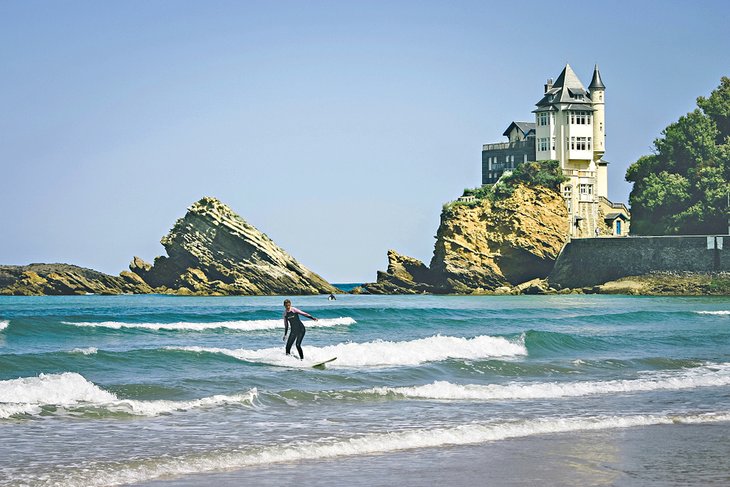
The Côte des Basques is considered the birthplace of surfing in France. The impressive waves provide challenging conditions for surfing, and many competitions are held here. Swimming and wading are allowed except during high tide when waves break on the entire shoreline.
Visit the Côte des Basques to admire dazzling oceanfront scenery, with views of the mountainous coastline extending to the Spanish border. Because cliffs surround the beach, a steep pedestrian staircase provides access from the parking lot.
Next to the Côte des Basques, the Plage de Marbella is another favorite of surfers and bodyboarders because of its powerful waves. This unspoiled, sandy beach is wild and rugged and is only accessible by a staircase.
Access to both of these beaches is difficult for people with limited mobility.
Safety notes: Beginning surfers should be advised on how and when to enter and get out of the water to avoid hitting the stones.
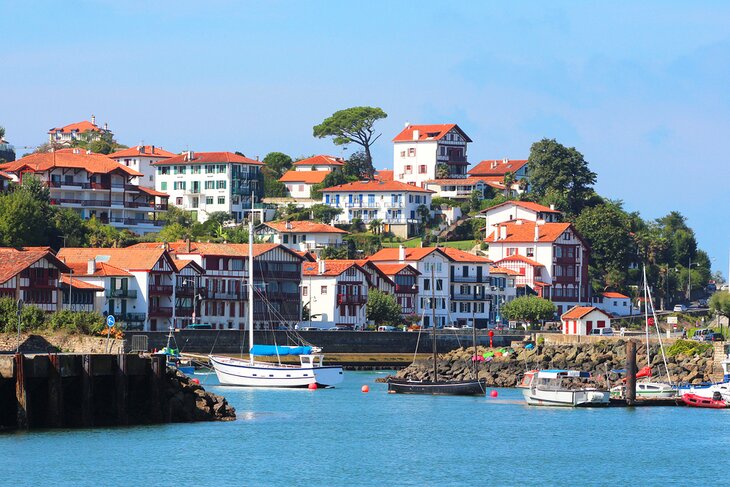
Saint-Jean-de-Luz is another popular holiday destination on France's Basque coastline. The town has retained its historic charm and the ambience of an old fishing village. Brimming with specialty food shops and traditional restaurants, Saint-Jean-de-Luz offers an authentic taste of Basque culture.
The sandy beaches of Saint-Jean-de-Luz attract many vacation goers during summertime. Its beaches are prized for their gentle waves (thanks to protection from the ocean by a sea wall). Families with kids appreciate that it's safe to swim and wade in the waters.
Saint-Jean-de-Luz is just a 30-minute drive south of Biarritz. It's worth taking the time to discover this Basque seaside town, which is quite different from the glitzy resort of Biarritz.
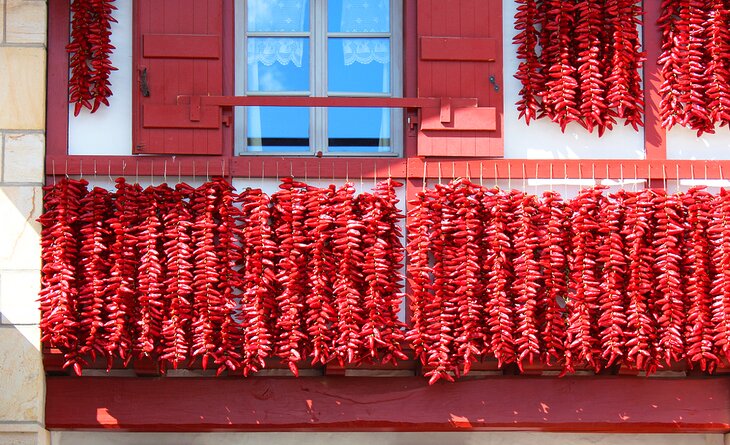
A key ingredient in Basque cuisine, the Piment d'Espelette , takes its name from this picturesque village. The town's traditional red-shuttered Basque houses are often festooned with neatly lined rows of peppers, drying in the open air. The bright red peppers are grown on nearby farms.
The Piment d'Espelette pepper has been designated with an AOP ( Appellation d'Origine Protégée ) label because of its distinctive flavor and unique geographical origin.
To experience the best of local culture and cuisine, visit in late October during the Fête du Piment d ' Espelette (Pepper Festival). The two-day festival includes gourmet tastings, hearty country meals, Basque dance performances, and choir concerts. Market stalls sell Piment d'Espelette peppers and other regional gastronomic products.
Espelette is a 30-minute drive from Biarritz.
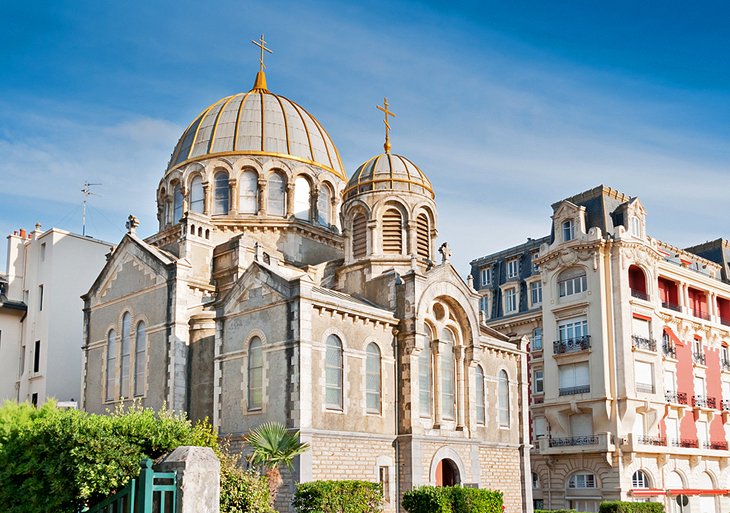
This Byzantine-style Russian Orthodox church was designed by the renowned Biarritz architect Tisnès. It was built between 1890 and 1892 for a community of Russian immigrants (mostly aristocrats).
Gilded icons from Saint Petersburg adorn the interior, creating the impression of a glittering jewel box.
The church is open to the public for visits, Thursday through Sunday, in the afternoon. You may also attend prayer services on Sunday mornings.
Address: 8 Avenue de l'Impératrice, Biarritz
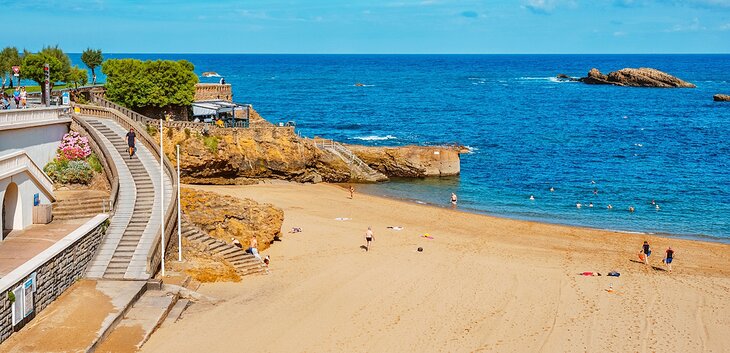
This sheltered Plage du Port Vieux is an excellent choice for families with children. The small sandy beach nestles in a rocky inlet of the Port Vieux (Old Harbor) near the city center.
Because the beach is in a protected cove, the waves are gentle, and the waters are safer here than at the Grande Plage and the Plage du Miramar. The conditions are usually calm enough for swimming, and the shallow areas are safe for kids to bathe and splash around, under supervision.
Another family-friendly beach is the Plage de la Milady . This expansive sandy beach features a seaside boardwalk and a playground. The beach is very popular among locals and bodyboarders.
Swimming is permitted at the Plage de la Milady, except when the waters are rough. One caution: The zone of surveillance increases at low tide.
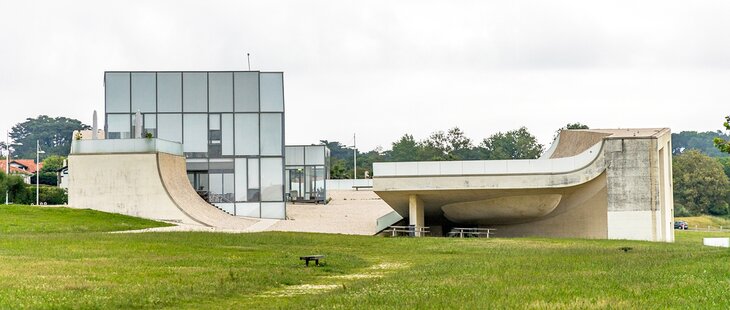
Near the Plage de la Milady, the Cité de l'Océan (City of the Ocean) is entirely dedicated to the science of oceanography. The museum's creative and interactive exhibits make learning about ocean-related topics fun and interesting.
Exhibits focus on specific concepts, such as climate change and the origin of waves. A virtual surfing experience allows visitors to feel what it's like to ride the ocean waves without getting wet. In a small theater, the museum screens a 3-D show, which simulates being in a submarine 1,000 meters underwater.
The Cité de l'Océan is open from February through October. Hours are extended during the high season.
Address: 1 Avenue de la Plage, Biarritz
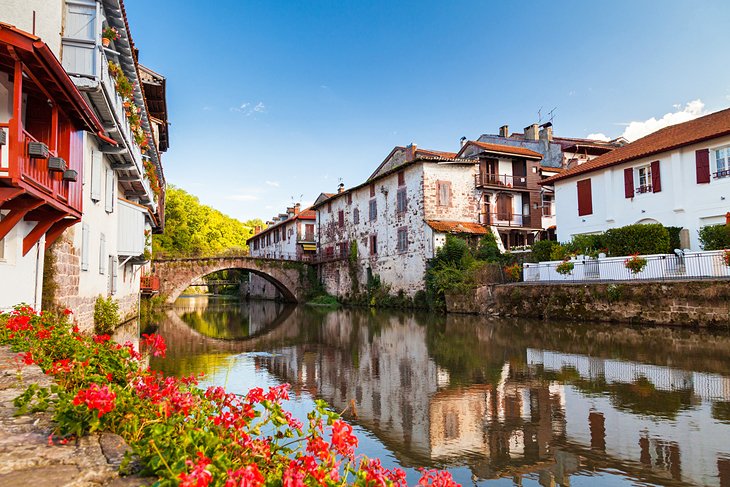
The Basque village of Saint-Jean Pied de Port definitely merits a day trip, located an hour's drive from Biarritz. This quaint village nestles in a gorgeous verdant setting of rolling hills and woodlands.
Listed as a UNESCO World Heritage Site, Saint-Jean Pied de Port features cobblestone streets and traditional Basque red-shuttered historic buildings. The town also boasts a noteworthy 13th-century church — the Eglise Notre-Dame du Bout du Pont .
Saint-Jean Pied de Port was a stop on the medieval Way of Saint James pilgrimage to Santiago de Compostela in Spain. Standing at the foot of the Pyrenees Mountains, at an elevation of 1,300 meters, the town marked a difficult stage of the pilgrims' route. Many modern pilgrims still begin their Chemin de Saint-Jacques journey here.
The pristine countryside around the village is also a fantastic place for hiking and nature walks or just for relaxing and meditating in the lush landscape.
In August, the town hosts the Fêtes de Saint-Jean Pied de Port , a traditional Basque festival with dance and music performances.
The surprising Musée d'Art Asiatique displays one of Europe's top collections of Asian art. There are more than 1,000 pieces of artwork representing different historical periods, from ancient to modern times. The collections represent the work of different countries, including China, India, Nepal, and Tibet.
Address: 1 Rue Guy Petit, Biarritz
Biarritz has been a premier seaside resort since the 19th century, when the destination was known as the "Queen of Resorts and the Resort of Kings." Because of this aristocratic heritage, Biarritz has many establishments that cater to a clientele with refined tastes, including luxury hotels on prime oceanfront property. There are also affordable accommodations, just a short walk away from the beach. Below are highly rated hotels in several categories.
Luxury Hotels:
- The Hôtel du Palais is a splendid seaside palace that was built for the Empress Eugenie in 1855. The five-star property dazzles guests with its lavish Second Empire-style interior, sumptuous guest rooms, oceanfront gardens and outdoor pool, gastronomic restaurant, and a pampering spa. The hotel's restaurants and many of the guest rooms have ocean views.
- In a lovely beachfront location, Regina Experimental Biarritz is another architectural standout in Biarritz. The Belle Epoque five-star hotel has spacious guest rooms decorated in Art Deco style. Amenities include an upscale spa with a hammam, an outdoor pool with a terrace, and a bistronomique restaurant with panoramic ocean vistas.
- More modern in style than the other luxury hotels, the Sofitel Biarritz Le Miramar Thalassa Sea & Spa Hotel features a thalassotherapy (saltwater therapy) spa with a sauna and wellness treatments, an outdoor saltwater swimming pool, and a poolside restaurant. The beachfront property offers ocean views plus easy access to the Plage du Miramar.
Mid-Range Hotels:
- On a tree-lined street in town, the three-star Hotel Saint Julien is within easy walking distance of many restaurants and the beach. The hotel occupies a typical Basque house with red shutters and a flowering garden. Guest rooms are decorated in an understated contemporary style. A classic French buffet-style petit déjeuner (baguette, fresh fruit, cheese, yogurt, juice, and coffee) is served in a charming salon or on the outdoor terrace.
- In the historic center of Biarritz, La Maison du Lierre is a good choice of accommodation within walking distance of the beach. This small boutique hotel has cheerful guest rooms and a delightful garden where a traditional French breakfast is served.
- The Hôtel Villa KOEGUI Biarritz is another boutique hotel in the center of Biarritz near the Place Georges-Clemenceau, a short walk to the beach. This contemporary four-star hotel has an intimate atmosphere, minimalistic rooms, and a pleasant outdoor patio. A generous breakfast buffet with homemade pastries and local specialities is available.
Budget Hotels:
- The two-star Hôtel Parc Mazon is found in a typical red-shuttered Basque house in a quiet residential neighborhood, within walking distance of the Côte des Basques surfing beach. The hotel's guest rooms are small and basic yet are decorated in an appealing whimsical style. Breakfast is available for an additional cost.
- About a five-minute walk from the beach, the three-star Hôtel Argi Eder offers contemporary-style guest rooms at an affordable price. A continental breakfast is available for an extra fee. Those who are mobility challenged should note that the hotel does not have an elevator.
More Related Articles on PlanetWare.com
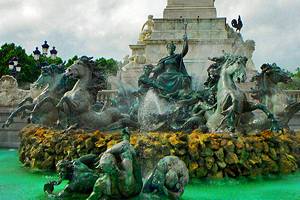
Cultural Heritage Sites in France's Southwest: Biarritz is found in France's far Southwestern corner, which is relatively remote compared to other tourist destinations in France. It's a long way from Paris (a 90-minute plane flight, 8- to 10-hour drive, or over five hours by train). The closest big cities are Bordeaux (about a two-hour drive or train ride), renowned for its romantic riverside setting and UNESCO-listed architectural treasures, and Toulouse (about a three-hour drive), which has a slow-paced Southern French ambience and a rich cultural heritage.
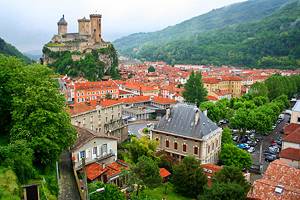
Pyrenees Mountains and Spanish Basque Country: Biarritz boasts majestic scenery along the Atlantic Coast with the Pyrenees Mountains in the background. Within about a two-hour drive are many sublime nature sights, quaint alpine villages, Romanesque churches, and rejuvenating spa towns in the nearby French Pyrenees .
Biarritz is also at the heart of the French Basque Country, which shares a cultural heritage with the neighboring Spanish Basque region. This distinctive area of Spain is known for its idyllic rural landscape and vibrant cities. Spain's version of a stylish seaside resort, San Sebastian (about a 45-minute drive or 90-minute train ride) attracts crowds to its sandy beaches during the summertime and year-round because of its atmospheric Old Town, superb fine arts museum, and traditional " pintxo " (Basque tapas) restaurants.
For art lovers, it's worth taking the two-hour drive from Biarritz to explore the sights of Bilbao , including the Guggenheim Museum and the Bilbao Fine Arts Museum. The historic town of Pamplona (about a 90-minute drive) is famous for its Running of the Bulls festival but also has an impressive cathedral and other noteworthy attractions.
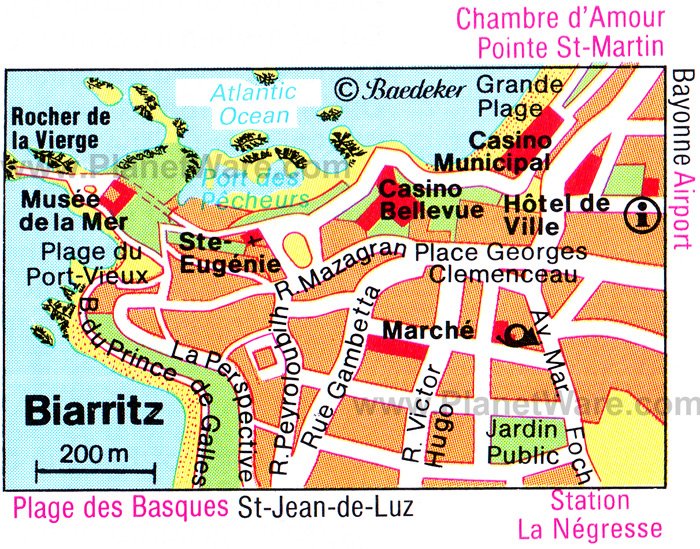
More on France


This spring, in the Basque Country
Discover your next destination.
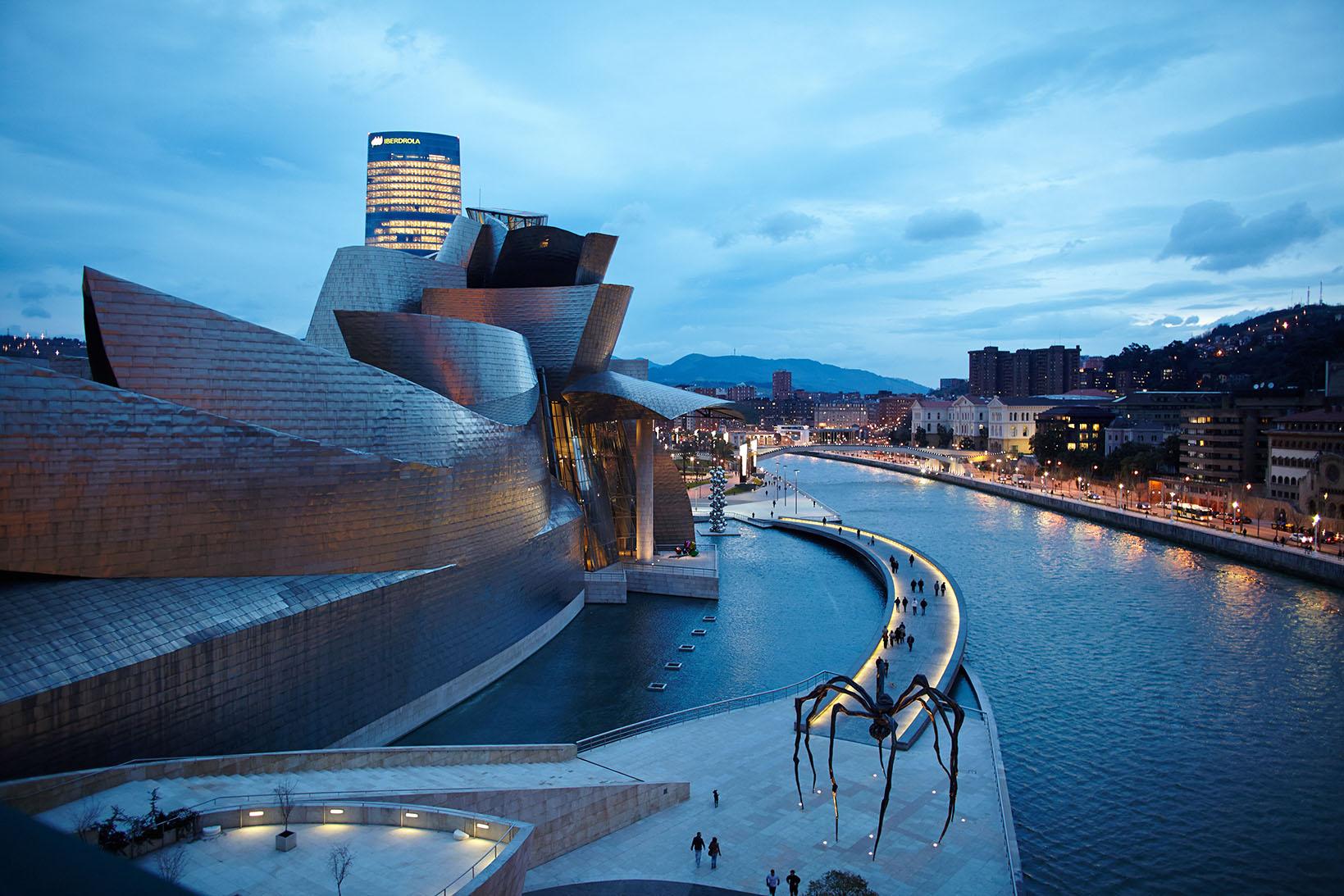
This spring in the Basque Country
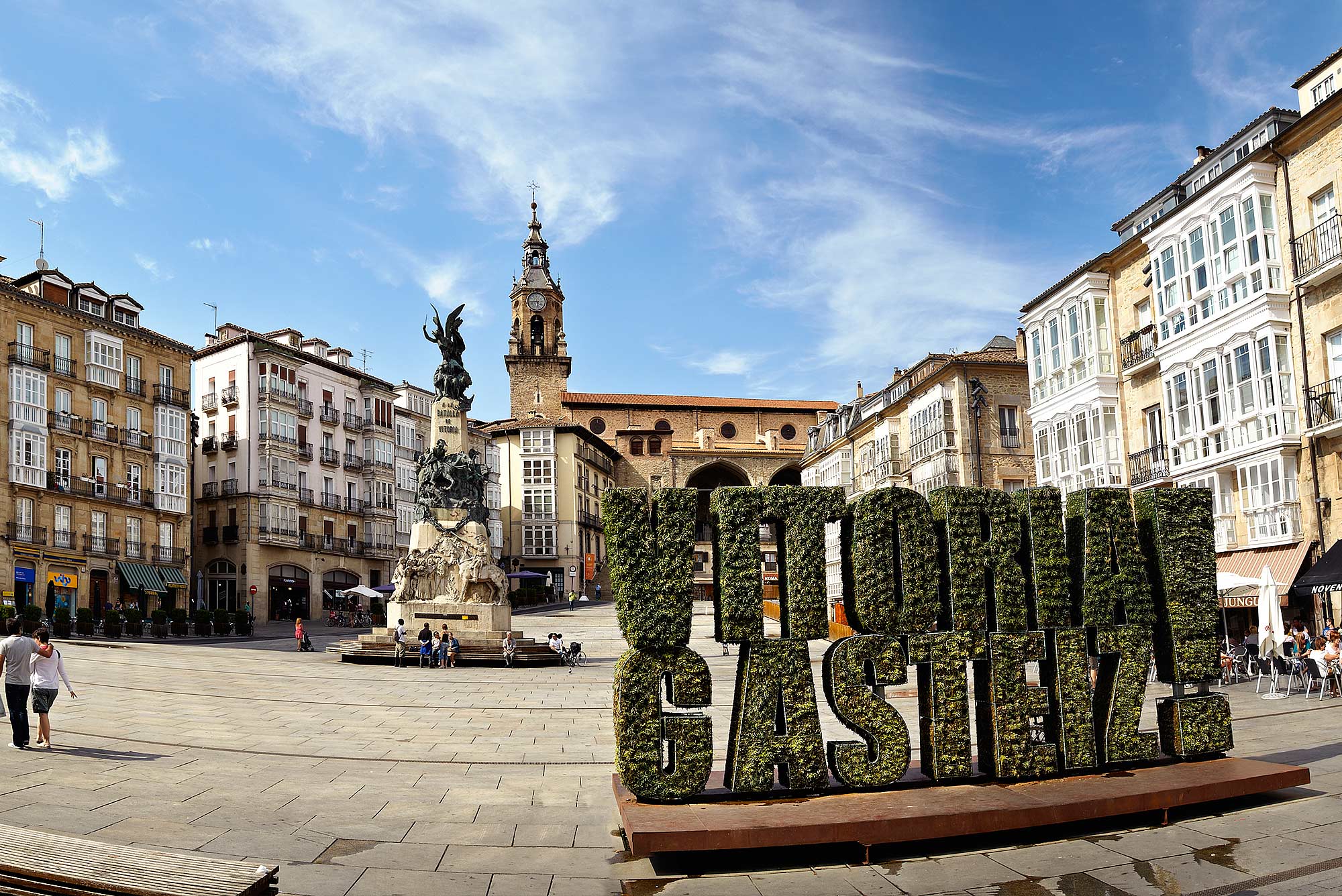
Basque Country Tourism, discover the Basque Country
Welcome to basque country tourism.
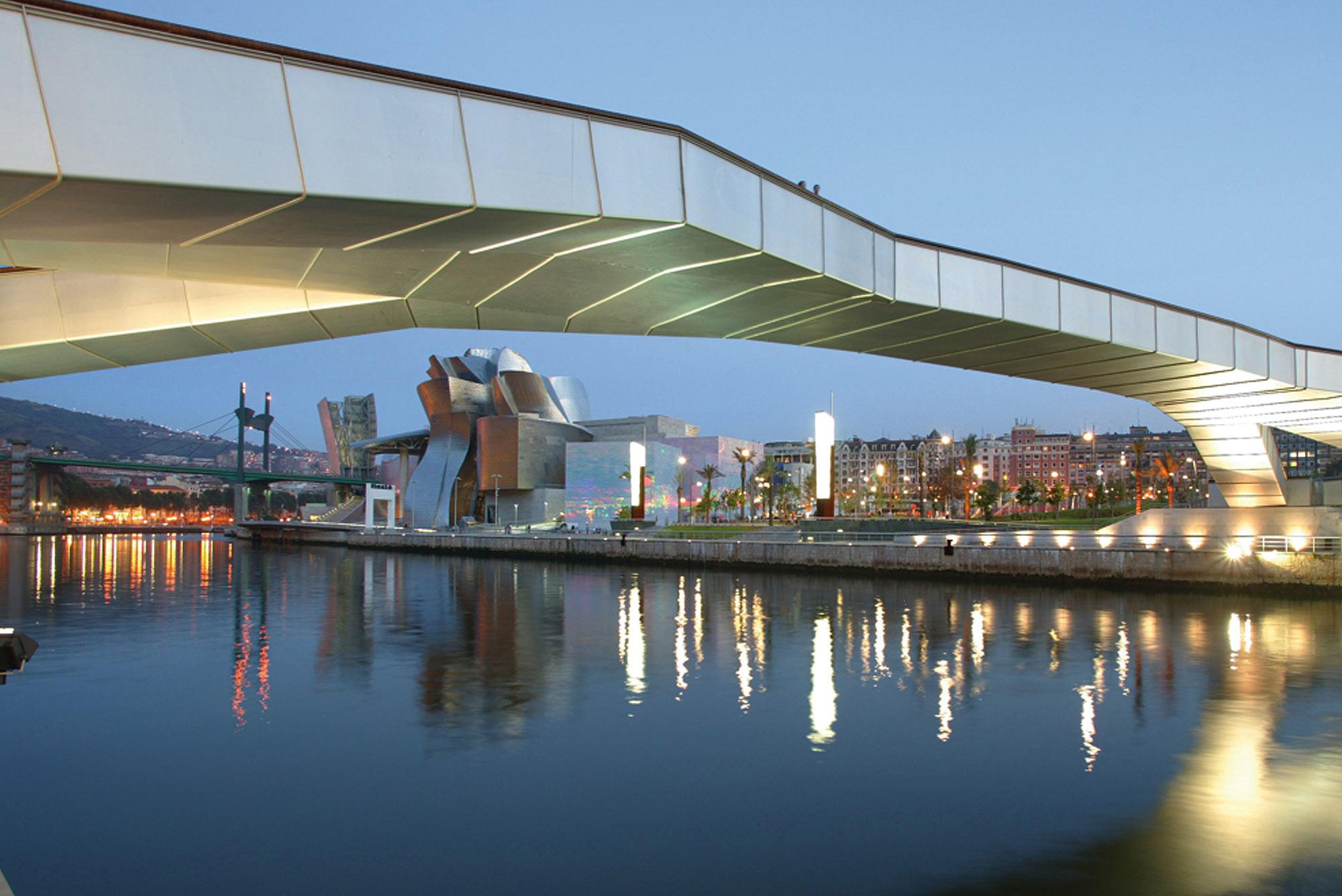
Discover Bilbao
Cosmopolitan, open, welcoming, vital, elegant and modern; Bilbao combines traits of a unique and characteristic cultural heritage, with a new aesthetic in which the avant -gardeand the art coexist in its streets creating a new balanced and surprising urban landscape.
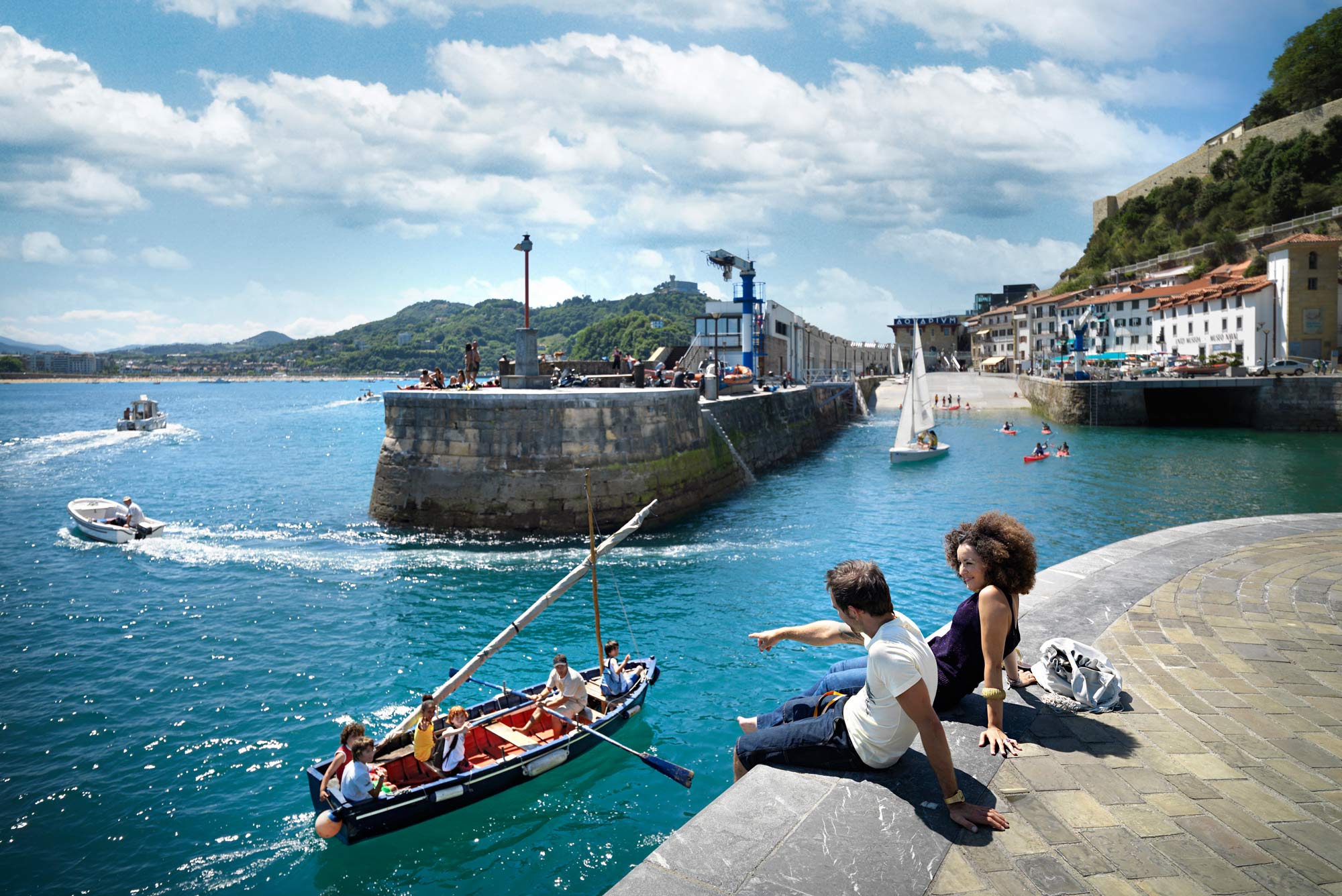
Discover Donostia - San Sebastián
Donostia / San Sebastián, European Capital of Culture in 2016, is much more than the beautiful Bay of La Concha.

Discover Vitoria-Gasteiz
The capital of Euskadi, Vitoria-Gasteiz, has achieved the distinctions of Biosphere Destination Certification as a sustainable tourist destination in 2016, National Capital of Gastronomy 2014 and European Green Capital 2012.
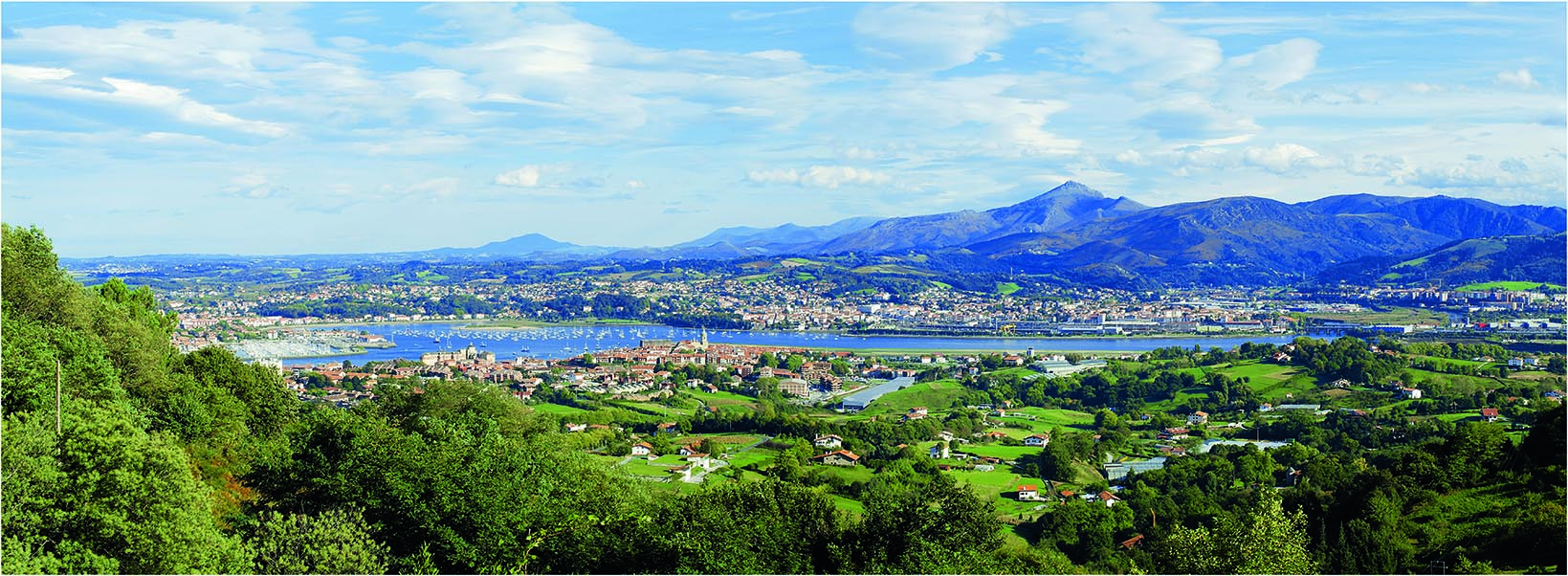
Discover Hondarribia and Irún
At the mouth of the Bidasoa River is the Bay of Txingudi, with Hondarribia and Irun. The first of these is a beautiful fortified villa where you can visit the neighborhood of La Marina, with its colorful fishermen's houses, pintxos bars and restaurants.
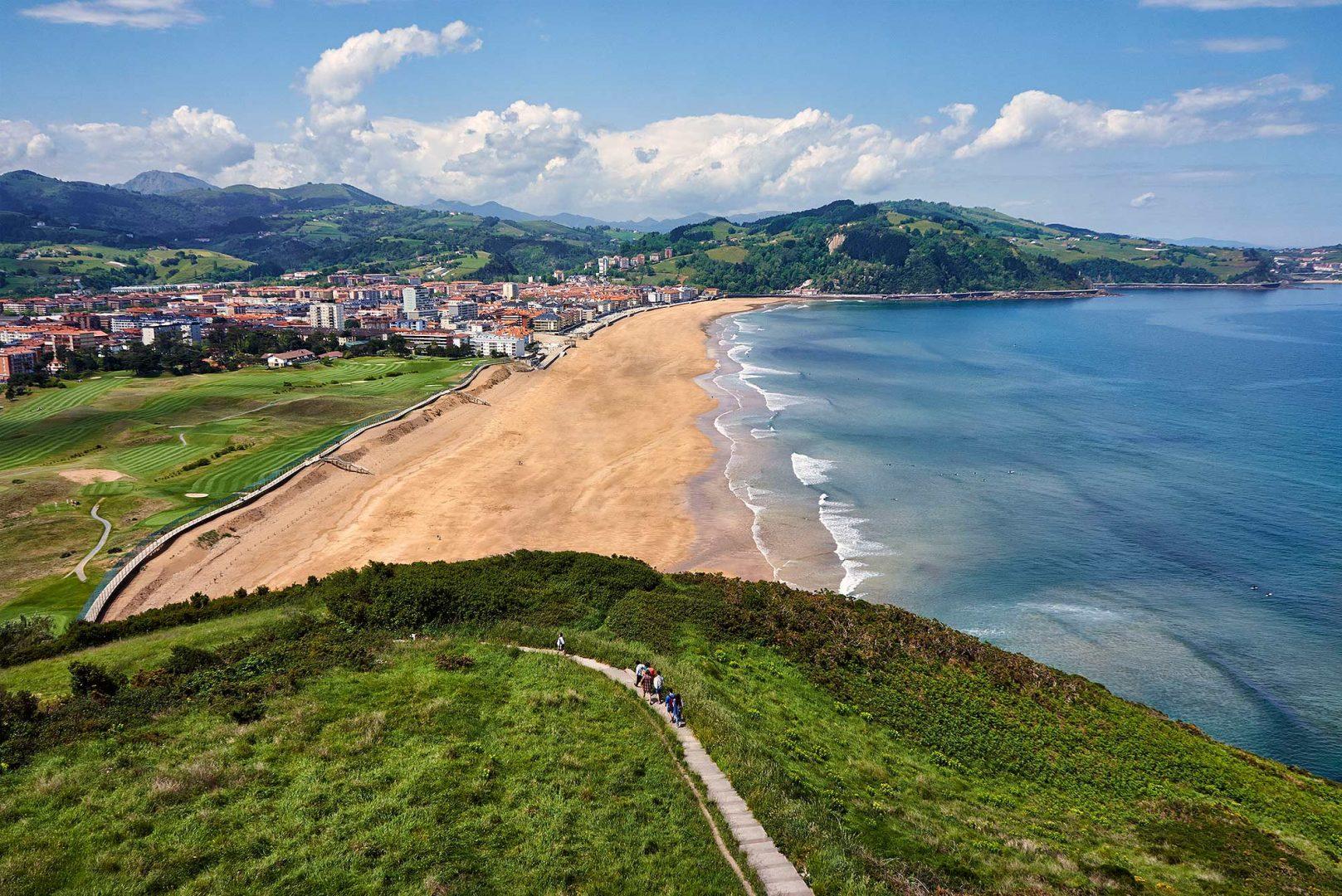
Discover Zarautz
On the coast of Gipuzkoa, is Zarautz. Its beach, worthy of the best summer postcards for its great extension and the sculptures that shine outdoors on its promenade, attracts thousands of surfers from all over the world.
LAST NEWS ABOUT TOURISM IN THE BASQUE COUNTRY

IMAGES
VIDEO
COMMENTS
2024. 1. La Concha Beach. 9,239. Beaches. City beach with shallow waters, ideal for families, flanked by a boardwalk with bay and mountain views. Nearby, the historic old town provides a scenic promenade and dining. See ways to experience (48) 2023.
The Basque coastline is unique because of the relationship between land and sea there. With its protected biotopes, wetlands and several nearby nature parks, the Basque coastline is an ideal destination for anybody looking to enjoy the best of the sea in a natural setting. Here in the Basque Country we have the best city beaches - and the most ...
Address. Getaria, Gipuzkoa, Spain. Head just a little ways out of San Sebastián to the west and soon you'll find yourself in one of the Basque Country's most charming coastal destinations. A humble fishing village teeming with authentic, local charm, Getaria is a haven of gorgeous landscapes and quaint traditional architecture, which combine ...
Basque Country. On a peaceful, tree-lined boulevard, this low-lit armaments museum showcases weapons used over the centuries, from Bronze Age spearheads to 19th-century…. Discover the best attractions in Basque Country including Museo Guggenheim Bilbao, Itsasmuseum, and Museo de Bellas Artes.
The most complete Basque Country tourism guide featuring photos & info for the region's top destinations, restaurants, festivals and things to do. The Best of the Basque Country. Basque Country Guide ... The Basque Country has long been an unexplored region in northern Spain and southern France. But that's all changing these days since it's ...
What to see and what to do on your trip to the Basque Country. Discover the 10 things not to miss Bilbao, San Sebastián and Vitoria-Gasteiz ... Family Tourism Basque Country Confidential Basque Country with your dog Art and culture Basque culture Basque sports. Leaflets. All the maps. Basque food and drink Basque food and drink. Return. Where ...
See ways to experience (49) 2023. 2. Guggenheim Museum Bilbao. 18,065. Art Museums. American architect Frank Gehry is responsible for this architectural masterpiece: this fantastic chrome and metal creation houses a large collection of modern and contemporary art, a continuation of the Guggenheim legacy.
Top Things to Do in Basque Country, Spain: See Tripadvisor's 816,923 traveller reviews and photos of 1,834 things to do when in Basque Country.
Things to Do in Basque Country, Spain: See Tripadvisor's 805,829 traveller reviews and photos of Basque Country tourist attractions. Find what to do today, this weekend, or in August. We have reviews of the best places to see in Basque Country. ... Top Attractions in Basque Country. Map. See all. 2023. 1. La Concha Beach. 9,221. Beaches. By ...
10. Les Grottes de Sare. 1,026. Caverns & Caves. An original approach to the underground world ! In CAVES of SARE, visitors will hear in the depths of the earth, the echo of a human adventure that lasts for thousands of years! At the heart of a remarkable natural and historic territory, a particular emotion emerges...
Basque Country. Boasting some of the best cuisine in the world, beaches in natural surroundings, examples of avant-garde architecture... This area of northern Spain is perfect for an all-round trip. If you go to the Basque Country, don't forget to try their famous "pintxos": haute cuisine in miniature which you will find on display in many ...
Saint Mary's Cathedral and Cloister Bayonne. Vittoria-Gastéiz, the quiet capital of the Basque Country, is home to a stunning cathedral built in the 13th and 14th century - the Cathedral of Santa María. Although this cathedral, which is a UNESCO World Heritage Site, is undergoing restoration work, it is still open to the public and ...
Vitoria-Gasteiz gets international certification as a destination for sustainable tourism, Biosphere Responsible Tourism. Another of the treasures Vitoria-Gasteiz has to offer is what is known as the Mediaeval Almond, so-called because of its shape, one of the finest old quarters in the Basque Country. The Cathedral, a Gothic literary star
Zubizuri Bridge. 130. Straddling the Nervión River and connecting two of the city's most popular attractions—the Guggenheim and Artxanda Funicular—the futuristic, steel cable-suspended Zubizuri Bridge is an architecturally notable landmark. Visit after dark to see the Santiago Calatrava-designed footbridge light up.
18. Visit Iglesia de San Vicente, San Sebastián's oldest church. Built in the Gothic style, Iglesia de San Vicente (Church of San Vicente) was one of the lucky few buildings to survive the fire of 1813 when Napoleon's troops set the city alight, which makes this the oldest church in the city.
Map of Attractions & Things to Do in Biarritz. 1. Grande Plage. Grande Plage. Biarritz' most central beach, the Grande Plage has attracted high-society vacationers since the Belle Epoque. This wide, sandy beach begins at Bellevue near the Boulevard du Général de Gaulle and extends to the Hôtel du Palais.
Keep in mind that Pasaia consists of 4 villages: San Pedro, Antxo, Trintxerpe, and San Juan (Donibane), the latter being our favorite as it is in a privileged position on the bay and has more tourist attractions such as the square of Santiago, the church of San Juan Bautista, the Arizabalo palace, the chapel of Santa Ana and the house where the French writer Victor Hugo lived.
Basque Country Tourism, the best way to discover a small country with a great identity. From the avant-gardism of its cities to the tranquility of its coastal towns, this tourist proposal allows you to enjoy the essences of Euskadi. Basque Country Tourism is the association formed by the cities of Bilbao, San Sebastian, Vitoria-Gasteiz, Zarautz ...
Bathed by the Bay of Biscay, Zarautz is located in the historical territory of Gipuzkoa within the Urola-Kosta region. Its wide beach is enhanced by Santa Bárbara and Mollarri Cliffs and extends along 2,500 metres surrounded by a lived promenade full of coffee bars and terraces. The unmistakable colourful awnings and its fine and golden-colour ...